 |
PO Box 9021,
Wilmington, DE 19809, USA
E-mail: font@focusonnature.com
Phone: Toll-free in USA 1-888-721-3555
or 302/529-1876 |
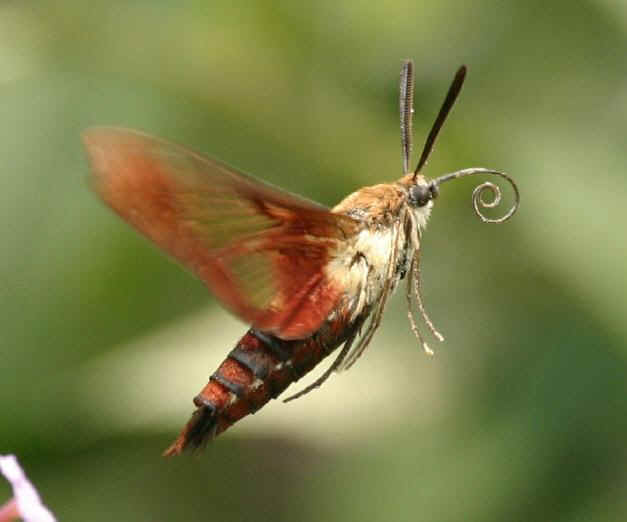 A List
A List
of Moths
in eastern
North America
with some photos
including those during
Focus On Nature Tours
in North Carolina,
the Delmarva Peninsula,
and elsewhere in the East
Part 1 of a List of Eastern North American Moths, in 2 Parts
compiled by Armas Hill
MOTHS
IN PART 2 OF THIS LIST, with families EREBIDAE & NOCTUIDAE
and some others, including: Tussock, Owlet, Nolid, Tiger, Wasp, and
Lichen Moths.
Photo at upper right: the
HUMMINGBIRD CLEARWING
(photo by Howard
Eskin)

LINKS to OTHER LISTS with
some PHOTOS of:
BUTTERFLIES in:
EASTERN NORTH AMERICA
ARIZONA
TEXAS
THE WEST INDIES CENTRAL AMERICA
SOUTH
AMERICA
DRAGONFLIES and DAMSELFLIES in: EASTERN NORTH AMERICA
TEXAS
MOTHS in: THE WEST INDIES
CENTRAL AMERICA
SOUTH AMERICA
MOTHS and BUTTERFLIES in:
ALASKA
EUROPE
JAPAN
And PHOTO GALLERIES of:
MOTHS in: JAMAICA
the DOMINICAN REPUBLIC
MOTHS
and BUTTERFLIES DURING RECENT FONT TOURS IN ECUADOR

There is now a field guide to moths that is truly excellent. It is the "Peterson
Field Guide to Moths of Northeastern North America", by David Beadle
& Seabrooke Leckie, published in 2012.
That book is listed below under "Codes", and referred to in the list
with the code (PNE). .
Codes:
M#:xxxx MONA (Moths
of North America) Numbers
These generally were Hodge's
Numbers, from the "Check List of the
Lepidoptera of America North of Mexico",
by R.W. Hodges, et. al.
That 1983 list (actually compiled thru 1978) is outdated, but those numbers have
long been used (and continue to be in the MONA listing).
Numbers noted as (NA:xxx)
refer to the photographs in the National Audubon Society Field Guide of
North American Insects & Spiders,
by Lorus & Margery Milne,
1980
Numbers noted as (NW:xx) refer to pages with
photographs in "Moths & Caterpillars of the North Woods" by
Jim Sogaard, 2009, (the North Woods series relates to wildlife in northern
Michigan, Wisconsin, Minnesota in the US & Ontario in Canada)
Numbers noted as (PM:xx)
refer to plates with
illustrations in the older Peterson book, "A Field Guide to the Moths of Eastern North
America", by
Charles Covell, Jr., 1984.
Numbers noted as (PNE:xxx) refer to pages
with illustrations in the "Peterson Field Guide to Moths of Northeastern
North America", by David Beadle & Seabrook Leckie,
2012.
Numbers noted as (PNP:xxx) refer to pages
with photographs in the book "Pollinators of Native Plants" by
Heather Holm, 2014.
Numbers noted as (S:xxx)
refer to pages in the
book "Butterflies and Moths"
by David Carter, a Smithsonian
Handbook,
second printing 2002.
Numbers noted as (W:xx)
refer to pages in the
book "Caterpillars of Eastern North America"
by David Wagner,
2005.
MA: occurs in Massachusetts
MD: occurs in Maryland
NC: occurs in North Carolina
NJ: occurs in New Jersey
PA: occurs in Pennsylvania
(ph): species with a photo in this FONT website
As of now, there are 1,754 species of moths in this two-part list.
Links to Groupings in this 2-part List:
We begin this long 2-part
of moths with those in the families SPHINGIDAE and SATURNIIDAE
as they are the most striking and spectacular in appearance and thus those that
are most apt
to catch the attention of people who may become interested in moths.
Sphinx & Hawk Moths (Family
Sphingidae)
Giant Silk Moths (Family
Saturniidae)
Lappet Moths & Tent Caterpillars
(Family Lasiocampidae)
Apatelodid Moths (Family Apatelodidae)
In this list, with APATELODIDAE is
BOMBYCIDAE: Silkworm Moths
Sack-bearers (Family Mimallonidae)
Scoopwing Moths (Subfamily
Epipleminae in the Family Uraniidae)
Hooktip Moths (Family
Drepanidae)
Geometer Moths (Family
Geometridae)
Prominents (Family
Notodontidae)
Tussock
Moths (Subfamily Lymantriinae)
What was the family LYMANTRIIDAE
is now said to be a subfamily,
LYMANTRIINAE, as part of the family EREBIDAE
Owlet Moths & Miller Moths
(what has been Family Noctuidae,
including
Family Erebidae, Euteliidae & subfamilies noted below)
EREBIDAE was part of NOCTUIDAE. It is 1 of 7 North American
families
in the superfamily NOCTUOIDEA that includes 12 former noctuid subfamilies:
including CALPINAE, CATOCALINAE, EUTELILINAE, HERMINIINAE,
HYPENINAE, BOLETOBLINAE, DIPHTHERINAE, EREBINAE, and others.
Nolid Moths (Family
Nolidae)
Slug Caterpillar
Moths (Family Limacodidae)
Smoky Moths or Leaf
Skeletonizers (Family
Zygaenidae)
& Metalmark Moths (Family Choreutidae)
Cossid
& Carpenter Moths (Family Cossidae)
Ghost
Moths (Family Hepialidae)
Tiger Moths
(Subfamily Arctiinae in the Family Erebidae)
What was the family ARCTIIDAE is now said to be a subfamily,
ARCTIINAE, as part of the family EREBIDAE
Wasp Moths (Subtribe Ctenuchini in Arctiinae in Erebidae)
Lichen Moths (Subtribe
Lithosiini in Arctiinae in Erebidae)
Plume Moths (Family
Pterophoridae)
Window-winged Moths (Family
Thyrididae)
Pyralid Moths (Family Pyralidae)
Family CRAMBIDAE is included in this list in the family PYRALIDAE.
Flannel Moths (Family
Megalopygidae)
Leafroller or Tortricid Moths (Family
Tortricidae)
Clear-winged Moths (Family Sesiidae)
Ermine
Moths (Family Yponomeutidae)
Certain members of the unrelated Snout Moths (in PYRALIDAE)
are also known as "Ermine Moths"
Needleminer Moths (Family
Lyonetiidae)
& Falcate-winged Moths (Family Ypsotophidae)
Twirler
Moths (Family Gelechiidae)
Mompha
Moths (Family Momphidae)
& Acorn Moth (Family Blastobasidae)
Leaf-blotch Miner
Moths (Family Gracillariidae)
Concealer
Moths (Family Oecophoridae)
Fairy Moths (Family Adelidae)
Tineid,
or Fungus Moths (Family Tineidae)
Family Galacticidae: a
recently-described family
of moths previously assigned to other families
Other Links:
Upcoming FONT Birding & Nature Tours in North America
FONT Past Tour Highlights
A List & Photo Gallery of North American Birds, in 6
parts Birds during
FONT North Carolina Tours
Other Lists
& Photo Galleries: Eastern
North America Butterflies
Eastern North America Wildflowers & some other plants
(noting host plants
for butterflies & moths)
Eastern North America Dragonflies & Damselflies
Eastern North America Amphibians & Reptiles
Eastern North America Mammals (Land & Sea)
Eastern North America Marine Life
Other Lists & Photo Galleries of Butterflies & Moths Elsewhere
Alphabetical Directory of Moths by Genus
with Photos in the FONT
Website
Alphabetical Directory of Butterflies by Genus
with Photos in the FONT
Website
Directory of Photos in this Website

In the two-part list that follows,
there are photographs of 162 species of moths and caterpillars.
A big thank you to all who have contributed photos.
Family SPHINGIDAE:
Sphinx Moths including
Hawk
Moths, or "Hummingbird Moths"
- Hummingbird Clearwing (ph) ______
M#7853 MD
NC
NJ PA
(NA:569) (NW:112) (PM:6) (PNE:265) (S:242) (W:268)
Hemaris thysbe
Hemaris thysbe resembles hummingbirds when hovering in front
of flowers, so much so that the moth is regularly mistaken for the tiny
bird.
When this moth hovers at flowers, as it does in full sunlight, it produces a
buzz with its wings that is similar to but softer than that of a hummingbird
when similarly engaged.
Favored foods are: hawthorns, honeysuckles, Prunus species, and snowberry.
The Hummingbird Clearwing is common throughout eastern North America.
Adults in the north fly Apr-Aug (1 brood), and in the south Mar-Jun &
Aug-Oct (2 broods).
Caterpillar food: often viburnums, also blueberries, cranberries
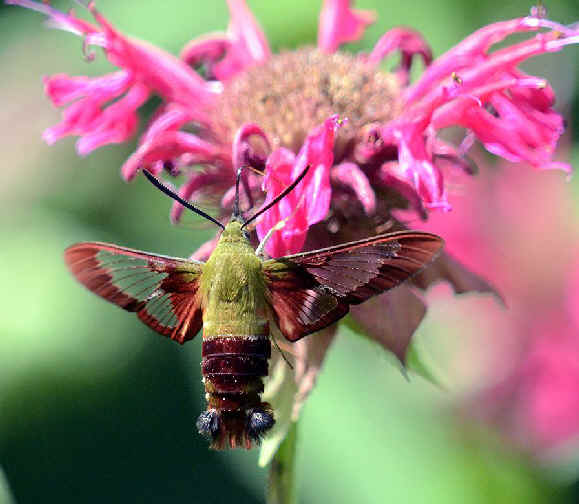
Above: A Hummingbird
Clearwing
(photo by
Howard Eskin)
- Snowberry Clearwing (ph) ______
M#7855 MD NC NJ PA
(NW:113) (PM:6) (PNE:265) (W:267)
Hemaris diffinis
The Snowberry Clearwing occurs commonly throughout eastern
North America. It has two broods. Adults fly Apr-Aug.
Favored caterpillar foods: snowberry, dogbane, honeysuckles.
Hemaris diffinis
resembles a bumblebee. It is distinguished
from the other two Hemaris species by black scaled areas on the
wings.
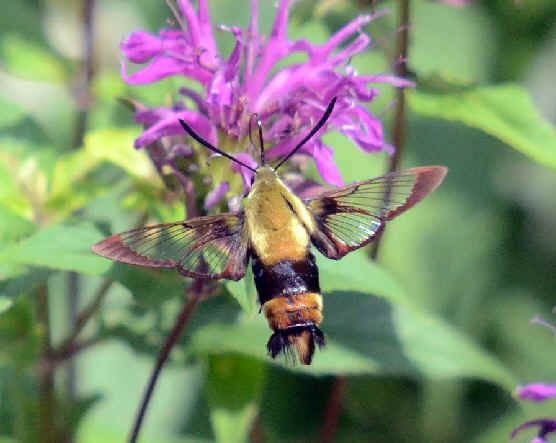
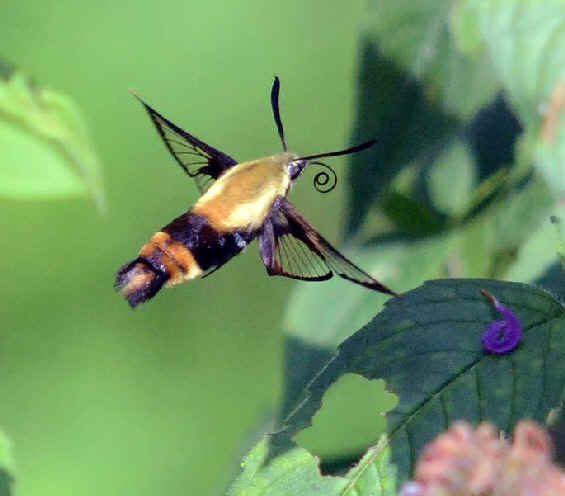
Photographs of the Snowberry Clearwing Moth
(photos by Howard Eskin)
- Slender Clearwing ______ M#7854
PA
(PM:6) (W:277)
Hemaris gracilis
The Slender Clearwing occurs from Nova Scotia to Florida, and west to
Michigan & Manitoba. Adults fly May-Aug.
It is the least common of the Hemaris species in eastern North
America, and its favored food is early, low blueberry.
- Carolina Sphinx Moth (ph) ______
M#7775 MD
NC
NJ
PA
(NA:25,558) (PM:1) (PNE:257) (S:238) (W:248)
Manduca sexta (in the subfamily SPHINGINAE)
The larva of the Manduca sexta is known as the Tobacco
Hornworm.
Yet another name for Manduca sexta
is the "Six-spotted Sphinx". In southern tobacco-growing
states, the adult moth is called a "tobacco fly".
Its caterpillars hatch from large green eggs and grow rapidly in 4 to 5
weeks. the pupae have a distinctive jug-like handle.
The Carolina Sphinx occurs throughout eastern North America. It is
more common southward. Adults fly May-Oct.
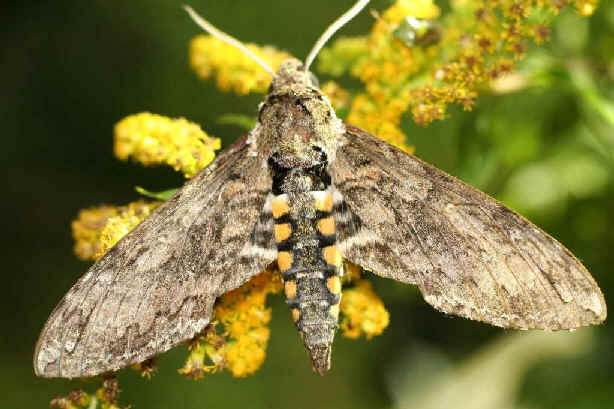
Carolina Sphinx
(photo by Stephen Kloiber)
- Rustic Sphinx Moth (ph) ______
M#7778 MD
NC
(PM:3) (PNE:259) (W:249)
Manduca rustica (in the subfamily SPHINGINAE)
Similar to Manduca sexta, the
Rustic Sphinx Moth is chocolate brown, mottled with white, black, and
yellow on its forewings, and it has 6 pairs of yellow spots on its abdomen.
It occurs from Virginia south to Central America, but it often strays
further north.
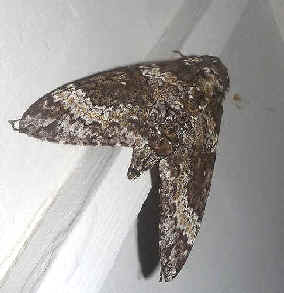
Rustic Sphinx Moth
- Ash Sphinx Moth ______ M#7783
MD NC PA (PM:4) (PNE:259)
Manduca jasminearum (in the subfamily SPHINGINAE)
The Ash Sphinx Moth occurs from Connecticut and New York south to
Florida, and west to Arkansas & Texas. It is more common along the East
Coast. Adults fly May-Sep.
- Five-spotted Hawkmoth ______ M#7776
MD
NC
NJ PA (NA:26) (PM:3) (PNE:257) (W:249)
Manduca quinquemaculata (in the subfamily
SPHINGINAE)
Manduca quinquemaculata
is also called the
Tomato Hornworm Moth.
The caterpillars of Manduca quinquemaculata
are seen much more often than the adult moths. They feed mostly at night and
later pupate in unlined cells in the soil.
Although they are called tomato worms or hornworms, they also
eat the foliage of potatoes, eggplants, green peppers, and various weeds.
Persistent rumors that these caterpillars can "sting" with their
horns are totally false.
The adult moths are known in the southern tobacco-growing states as "tobacco
flies".
The Five-spotted Hawkmoth occurs throughout eastern North America. It is
less common southward than the Carolina Sphinx. Adults fly
May-Oct.
Manduca sp. ______
The following photo of a Manduca species was taken
in Colorado, USA in July 2014.
(photo by Janet Kenning)
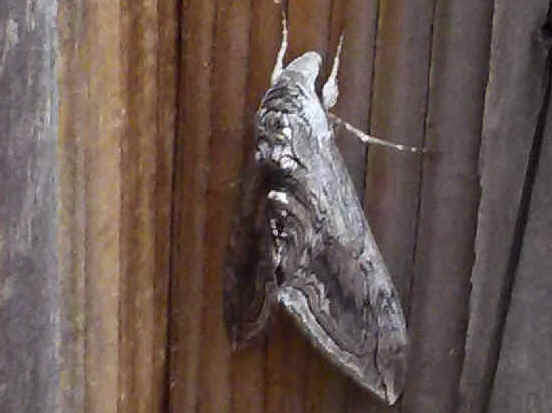
- Cerisy's Sphinx Moth (ph) ______
M#7822 PA
(NA:565) (NW:107) (PM:6) (PNE:263) (W:260)
Smerinthus cerysyi
Smerinthus cerysyi
is also called the One-eyed Sphinx Moth.
The Cerisy's, or One-eyed Sphinx Moth occurs uncommonly from
Newfoundland to Georgia, and west to Manitoba & Arkansas. Adults fly
May-Jul.
Caterpillar food: willows and poplars
Smerinthus cerysyi is closely
associated with boreal forest.

The Caterpillar of the Cerisy's, or One-eyed
Sphinx
(photo by Sally Brady)
- Two-spotted Sphinx Moth ______ M#7821
MD NC NJ PA (NW:106)
PM:6)
(PNE:263) (S:241) (W:261) (also called Twin-spotted Sphinx Moth)
Smerinthus jamaicensis
The Two-spotted Sphinx Moth is more widespread than the preceding species,
the Cerisy's Sphinx Moth.
Smerinthus jamaicensis has red
rather than pink on its hind wings, and the blue area in the eyespot is
divided by a black line, hence "Two, or Twin Spotted".
The Two-spotted Sphinx Moth is common throughout eastern North America.
Adults fly Apr-Oct.
Caterpillar food: often willows, also poplars, elms.
- Galium Sphinx Moth (ph) ______
M#7893 MA PA
(PNE:269) (W:274)
Hyles gallii
intermedia (in the subfamily MACROGLOSSINAE)
Hyles gallii is also
called the Bedstraw Sphinx Moth.
The Galium Sphinx is similar
to, but smaller than, the following species, the White-lined Sphinx,
except that it lacks the white stripes on the thorax and is veins are not
outlined in white.
In eastern North America, the Galium Sphinx Moth occurs from Labrador to
Virginia, and west across Canada, south to Iowa. In much of the range, it is
common. Adults fly May-Aug.
Its caterpillars feed on bedstraw, spurge, fifewed, and other plants.
This, and the following species, were formerly in the genus CELERIS.
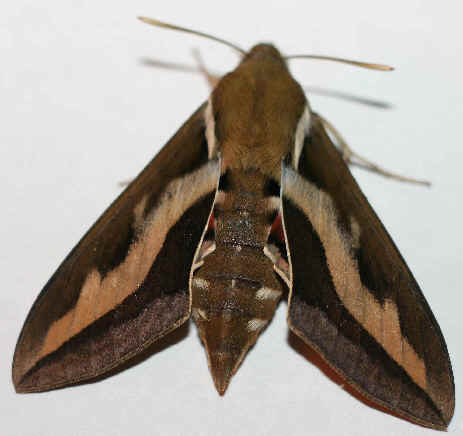
Galium Sphinx
(photo by Stephen Kloiber)
- White-lined Sphinx Moth (ph) ______
M#7894 MD NC NJ PA
(NA:554)
(NW:115) (PM:3) (PNE:269) (S:245) (W:275)
Hyles lineata (in the subfamily MACROGLOSSINAE)
White-lined Sphinx Moths
whir like hummingbirds as they visit gardens, often at dusk as well as in
darkness. Often they fly in numbers to artificial lights. Sometimes they
seek nectar in daylight.
There are 2 or more generations a year, with one overwintering as pupae
underground.
The White-lined Sphinx Moth occurs throughout eastern North America,
where adults fly Apr-Oct. It is sporadic northward.
Caterpillar food includes: evening primrose

Above: White-lined Sphinx
(photo by Howard Eskin)
Below: a Caterpillar of the White-lined Sphinx Moth photographed during a
FONT Tour
(photo by Doris Potter)

- Pink-spotted Sphinx Moth (ph) ______
M#7771 MD
NC
NJ
PA (PM:3) (PNE:257) (W:249)
Agrius cingulata (in the subfamily SPHINGINAE)
Agrius cingulata
is also called the Pink-spotted Hawkmoth.
The Pink-spotted Sphinx Moth occurs throughout eastern North America, but
as a stray northward. May be locally common. Adults fly Jun-Oct, especially
Sep-Oct.
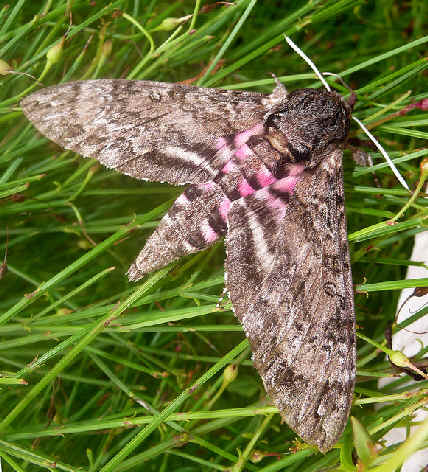
Pink-spotted Sphinx Moth
- Walnut Sphinx Moth (ph) ______
M#7827 NC
NJ
PA
(NW:110) (PM:6) (PNE:265) (W:264)
Amorpha juglandis (or Laothoe juglandis)
The Walnut Sphinx Moth occurs throughout eastern North
America. It is common in most of its range. Adults fly
May-Aug.
Caterpillar food includes: hop hornbeam (ironwood) and hazel.
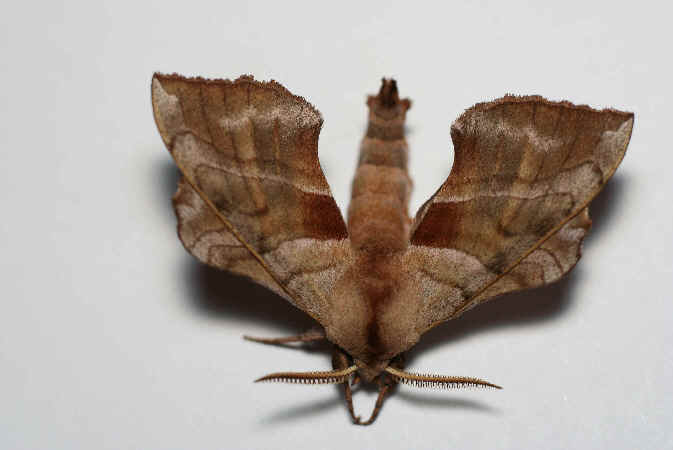
Walnut Sphinx Moth
(photo by Stephen Kloiber)
- Elm Sphinx Moth ______ M#7786
MD
NC
NJ
PA (PM:3) (PNE:259) (W:250)
Ceratomia amyntor
(in the subfamily MACROGLOSSINAE)
Ceratomia amyntor is also
called the Four-horned Sphinx Moth.
The Elm Sphinx Moth is common throughout eastern North America. Adults
fly May-Oct.
- Catalpa Sphinx Moth ______ M#7789
MD
NJ
PA
(PM: 5) (PNE:259) (W:251)
Ceratomia catalpae (in the subfamily MACROGLOSSINAE)
The Catalpa Sphinx Moth occurs
throughout eastern North America, where it is locally common to abundant,
but less common northward. Adults fly May-Sep.
- Waved Sphinx Moth (ph) ______
M#7787 MD
NC
NJ PA (NW:100) (PM:4) (PNE:259) (W:252)
Ceratomia undulosa (in the subfamily MACROGLOSSINAE)
The Waved Sphinx Moth occurs throughout eastern North America, where
it is one of the most common sphinxes. Adult fly May-Oct.
A caterpillar food: ash species
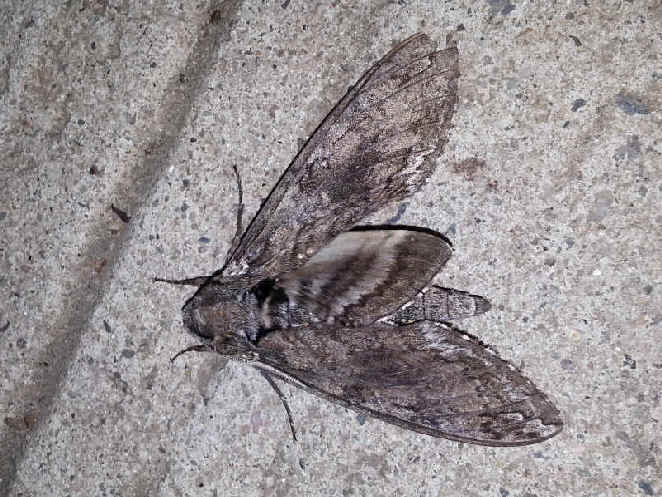
Waved Sphinx Moth
- Pawpaw Sphinx Moth ______ M#7784
MD NC NJ PA (NW:99)
(PM:5)
(PNE:259) (W:255)
Dolba hyloeus
The Pawpaw Sphinx Moth occurs from southern Ontario &
Maine to Florida, and west to Wisconsin & Texas. It is more common
southward. Adults fly Jun-Sep.
Caterpillar food: winterberry (in northern areas)
- Bald Cypress Sphinx Moth ______
M#7791 MD(rare)
NC
(W:255)
Isoparce cupressi
- Northern Pine Sphinx Moth ______
M#7817 MA MD
NC
NJ PA (NW:105) (PM:5) (PNE:263)
Lapara bombycoides
The Northern Pine Sphinx Moth occurs from Nova Scotia to Georgia, and
west to Manitoba & Wisconsin. It is locally common in Pines, favoring
Pitch, Red, and Scotch, and also American Larch. Adults fly Jun to mid-Jul.
Caterpillar food: pines (Jack, White, Red), also tamarack
The Northern Pine Sphinx Moth is similar to the Southern Pine Sphinx
Moth (below), but it is usually smaller, and its forewing lines are much heavier
and more distinct.
- Southern Pine Sphinx Moth ______
M#7816 MD NC
NJ PA (PM:5) (PNE:261) (W:254)
Lapara conferarum
The Southern Pine Sphinx Moth is locally common in pine forests from
southern New York to Florida, and west to Minnesota and Louisiana. It
favors, especially, Loblolly and Longleaf Pines in the South. Adults fly
late-Apr to Sep.
- Modest Sphinx Moth ______ M#7828
MD NC
NJ PA (NA:548) (NW:111) (PM:3) (PNE:265) (W:265)
Pachysphinx modesta
Pachysphinx modesta
is also called the Big Poplar Sphinx Moth.
The Modest, or Big Poplar Sphinx Moth occurs throughout eastern
North America. It can be locally common. Adults fly Jun-Jul in the north,
Mar-Sep further south.
Caterpillar food: poplars (especially) and willows
Pachysphinx modesta has one of
the largest wingspans of all the North American sphinx moths. The adult moths
somewhat resemble dried poplar leaves. When disturbed, they display their
maroon-red hindwing patches.
- Huckleberry Sphinx Moth ______ M#7826
MD
NC
NJ PA (PM:6) (W:260)
Paonias astylus
The Huckleberry Sphinx Moth occurs from Maine to Florida, and west to
Missouri & Mississippi. In the western part of its range, its
distribution is spotty. Overall, it is uncommon to rare. Adults fly in the
north in Jul, and in the south Mar-Jun and Sep in
Florida.
- Blinded Sphinx Moth (ph) ______
M#7824
MA MD NC NJ PA (NW:108)
(PM:6)
(PNE:263) (W:262)
Paonias excaecata
The Blinded Sphinx Moth has no black center in the blue eyespot,
hence the name "Blind".
Caterpillar food:
apple, birch, and variety of other trees.
The Blinded Sphinx Moth is common throughout eastern North America. Adults
fly May-Aug.
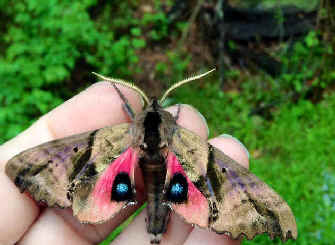
A Blinded Sphinx Moth photographed in the Smoky
Mountains in North Carolina in May 2015
Note in this photograph, all the fieldmarks: the violet shading in the
median area, the thick black bars in the inner median area, the rosy pink on
the hindwings, and the black-edged blue eyespots.
(photo by Amanda Hendricks)
Below: another Blinded Sphinx Moth,
from two different angles,
by a back porch in Cambridgeport, Massachusetts in late June 2014.
(photos by Eloy Martinez) Thank you Eloy!
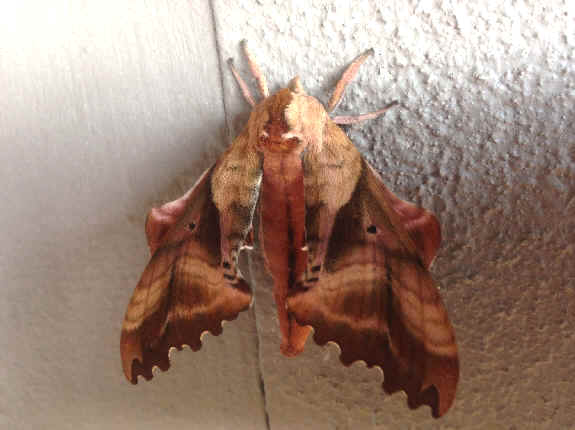
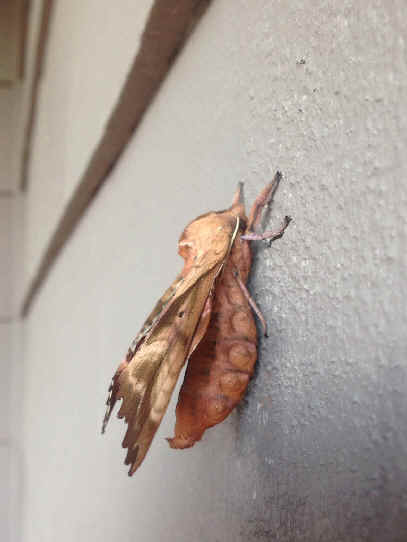
- Small-eyed Sphinx Moth (ph) ______
M#7825 MD
NC
NJ PA
(NW:109) (PM:6) (PNE:263) (W:263)
Paonias myops
The Small-eyed Sphinx Moth occurs commonly throughout eastern
North America. Adults fly May-Sep.
Caterpillar food: often cherry, also hawthorns, and juneberries.
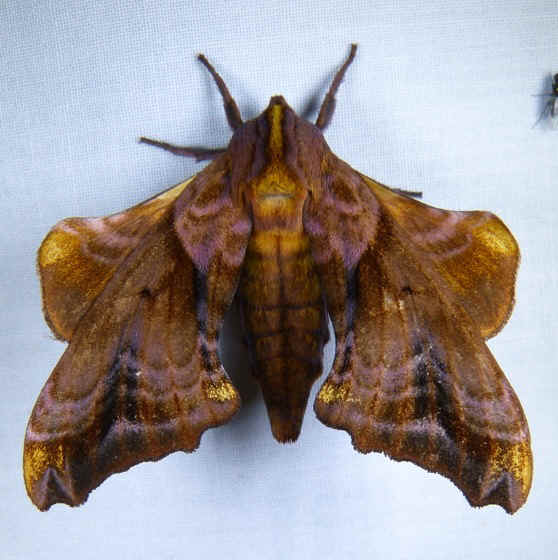
Above and below: the Small-eyed Sphinx Moth; below
with one of the "eyes"
(photos by Marcie O' Connor)
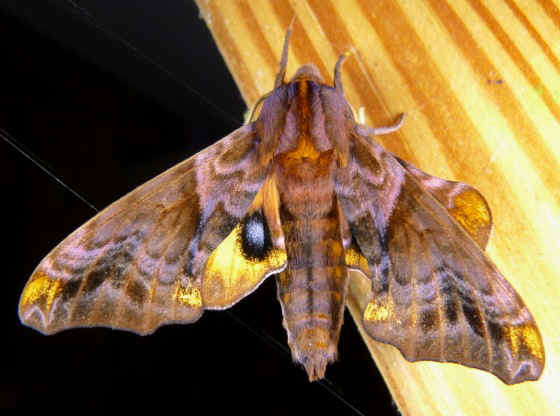
- Plebian Sphinx Moth ______ M#7793
MD
NC
NJ PA (PM:5) (PNE:259) (W:253)
Paratraea plebeja
Paratraea plebeja
is also called the Trumpet Vine Sphinx Moth.
The Plebian Sphinx Moth occurs commonly from Connecticut & New York to
Florida, and west to Minnesota, Kansas, & Texas. Adults fly
Apr-Oct.
- Canadian Sphinx Moth ______ M#7807
(PM:5) (PNE:261)
Lintneria canadensis (formerly Sphinx canadensis)
The Canadian Sphinx Moth occurs uncommonly from Newfoundland to
Kentucky, and west to Manitoba & Arkansas. Adults fly May-Sep.
The genus Sphinx is now said to be only
in the Old World.
- Great Ash Sphinx Moth ______
M#7802 MD
NC
NJ PA
(PM:4) (PNE:261) (W:256)
Lintneria chersis (formerly Sphinx chersis)
The Great Ash Sphinx Moth occurs throughout eastern North America. It
is generally uncommon, and more rare to the south. Adults fly
May-Oct.
- Wild Cherry Sphinx Moth ______ M#7812
MD
NC
NJ PA (NA:523) (PM:4) (PNE:261) (W:260)
Lintneria drupiferarum (formerly Sphinx drupiferarum)
The Wild Cherry Sphinx Moth occurs uncommonly from Newfoundland
to Georgia, and west to Manitoba & Arkansas. Adults fly
May-Jul.
Caterpillar food: the foliage
of wild or cultivated cherry, plum, and apple.
- Hermit Sphinx Moth (ph) ______
M#7796
MD NC PA (NW:101) (PM:5) (PNE:259) (W:257)
Lintneria eremitus (formerly Sphinx
eremitus)
The Hermit Sphinx Moth occurs from Nova Scotia to North Carolina, and
west to Manitoba and Arkansas. It is uncommon to rare southward, and
either not recorded or infrequently recorded in some states in its range.
Adult fly Jul-Aug.
Caterpillar food: herbs in the mint family, such as bergamot.
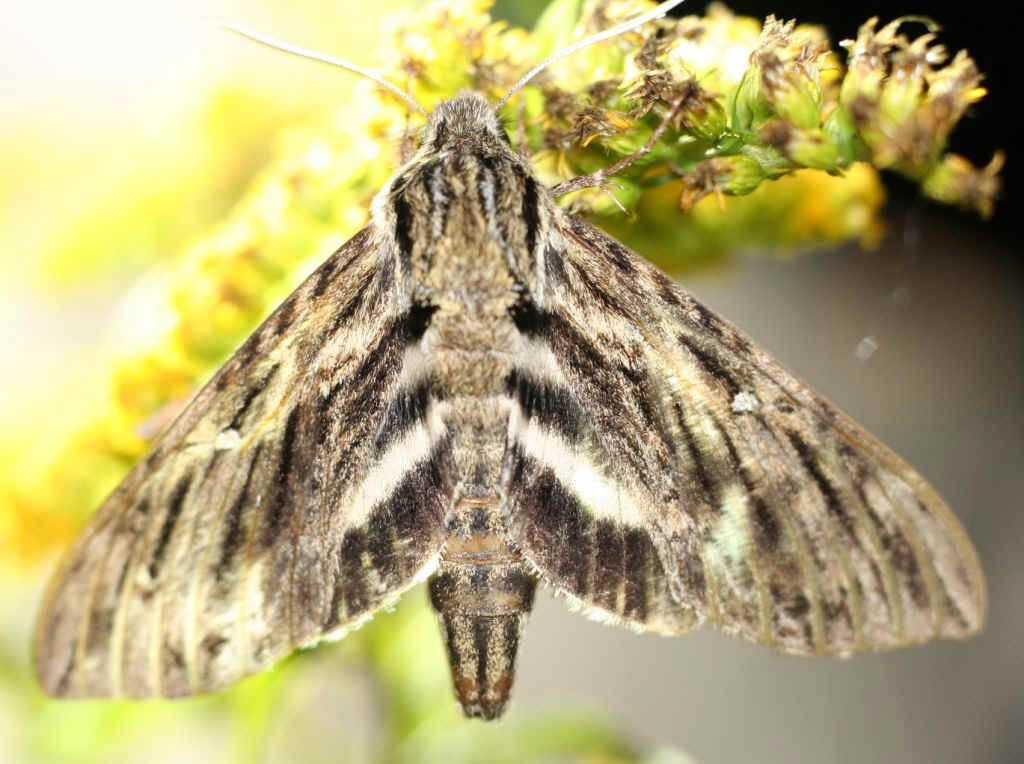
Hermit Sphinx Moth
(photo by Stephen Kloiber)
- Franck's Sphinx Moth ______ M#7808
MD(rare)
(PM:4)
Lintneria franckii (formerly Sphinx franckii)
The Franck's Sphinx Moth occurs from New Jersey to northern Florida, and
west to Missouri and Louisiana. It is local and uncommon, but less
rare than previously believed. Adults fly late Jun to mid-Jul, and again
Aug-Sep.
- Apple Sphinx Moth ______ M#7810
MD
NC
NJ PA (PM:5) (W:258)
Lintneria gordius (formerly Sphinx gordius)
The Apple Sphinx Moth occurs throughout eastern North America. It is
more common northward and rare further south. Adults fly May-Sep.
- Laurel Sphinx Moth ______ M#7809
MD NC NJ PA (NW:102)
(PM:4)
(PNE:261) (W:259)
Lintneria kalmiae (formerly
Sphinx kalmiae)
Lintneria kalmiae
is also called the Fawn Sphinx Moth.
The Laurel Sphinx Moth occurs
from Newfoundland to northern Florida, and west to Manitoba and Arkansas.
It is more common northward. Adults fly May-Aug.
In NC: in low and high mountains
Caterpillar food: often ash, also birches and lilac
- Clemen's Sphinx Moth
______ M#7811 PA
(NW:104) (PM:4) (PNE:261) (W:260)
Lintneria luscitiosa (formerly Sphinx luscitiosa)
The Clemen's Sphinx Moth occurs from Nova Scotia to New Jersey,
and west to Manitoba & Minnesota. It is uncommon to rare. Adults fly
Jun-Jul.
Caterpillar food: willows, birches, also bog rosemary, and
blueberries.
- Northern Apple Sphinx Moth ______
M#7810.1 (NW:103) (PNE:261)
Lintneria poecila (formerly Sphinx poecila)
Sphinx poecila
has long been conspecific with the more-southerly Apple Sphinx Moth, Sphinx
gordius. The Apple Sphinx Moth is best differentiated by
its having a contrastingly dark post-medial area of the forewing.
Caterpillar food: tamarack, sweet gale, meadowsweet, blueberries
- Tantalus Sphinx Moth (ph) ______
M#7847
Aellopos tantalus (in the
subfamily MACROGLOSSINAE)
The Tantalus Sphinx Moth occurs from southern Quebec to Florida, and
west to Michigan. Adults in the north fly in Jun.
Aellopos tantalus has one row of whitish spots on the forewing.
- Titan Sphinx Moth ______ M#7849
(PM:5)
Aellopos titan (in the subfamily MACROGLOSSINAE)
The Titan Sphinx Moth occurs from Maine to Florida, and west to South
Dakota & Texas. In the northern part of its range it is uncommon to rare
and adults fly Jun-Oct.
- Nessus Sphinx Moth ______ M#7873
MD
NC
NJ PA
(PM:6) (PNE:267) (W:272)
Amphion floridensis
The Nessus Sphinx Moth occurs
commonly throughout eastern North America. Adults fly Apr-Jul.
Amphion floridensis has been Amphion
nessus.
- Azalea Sphinx Moth (ph) ______
M#7886
MA MD NC NJ PA (NW:117)
(PM:6)
(PNE:267) (W:277)
Darapsa choerilus
(or pholus)
The Azalea Sphinx is common
throughout eastern North America. Adults fly Apr-Aug.
Caterpillar food includes: often viburnums, also blueberries
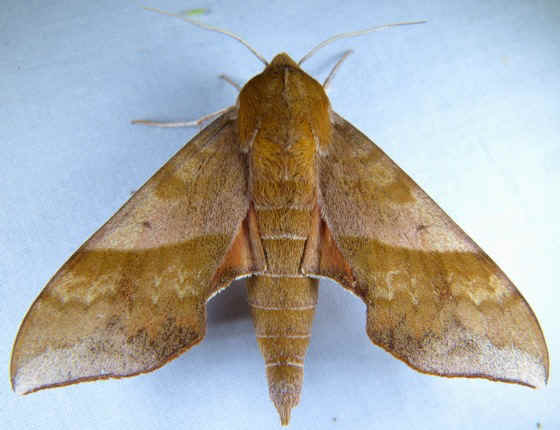
Azalea Sphinx Moth
(photo by Marcie O'Çonnor)
- Virginia Creeper Sphinx Moth (ph) ______
M#7885 MD
NC
NJ PA (NA:549) (NW:116) (PM:6) (PNE:267) (W:273)
Darapsa myron
Darapsa myron
is also called the Hog Sphinx Moth.
Unlike most adult moths, Darapsa
myron do not visit flowers but feed on decaying fruit and
fermenting tree sap.
Their caterpillars spin loose silken cocoons on the ground among soil litter
where they overwinter as pupae.
There are 2 generations per year. the fully grown caterpillar is often
parasitized by internal wasp larvae.
Darapsa myron is one of the most
common sphinxes. It occurs from southern Quebec to Florida, and wet to North
Dakota & Texas. Adults fly Apr-Sep.
Caterpillar food includes: grape, woodbine
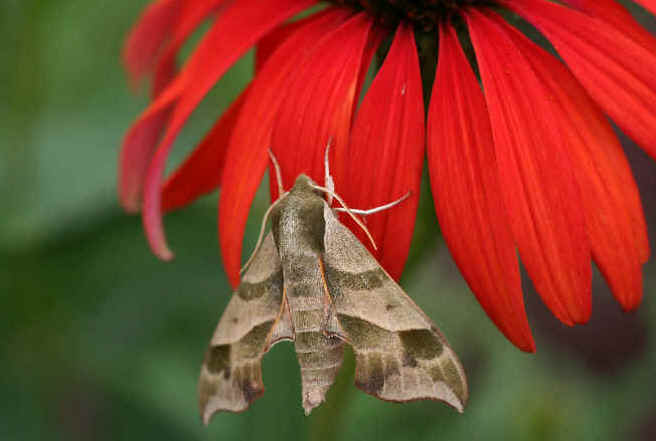
Virginia Creeper Sphinx Moth
(photo by Stephen Kloiber)
- Hydrangea Sphinx Moth ______ M#7884
MD NC NJ PA (PM:6)
(PNE:267) (W:277)
Darapsa versicolor
The Hydrangea Sphinx Moth occurs from
southern Quebec & Maine to Florida, and west to Michigan, Missouri, and
eastern Texas. It is uncommon to locally common. Adults fly Jun-Jul.
- Lettered Sphinx Moth (ph) ______
M#7871 MD
NC
NJ
PA (PM:6) (PNE:267) (W:271)
Deidamia inscriptum
The Lettered Sphinx Moth occurs
commonly from southern Quebec to Florida, and west to South Dakota,
Missouri, and Louisiana. Adults fly Mar-Jun.
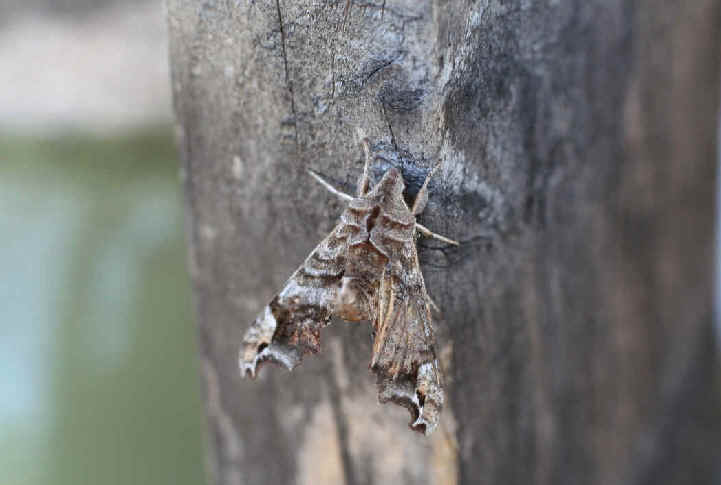
Above & below: Lettered Sphinx Moths
In the lower picture, on chimes in a backyard in Pittsburgh, Pennsylvania
(upper photo by Stephen Kloiber)
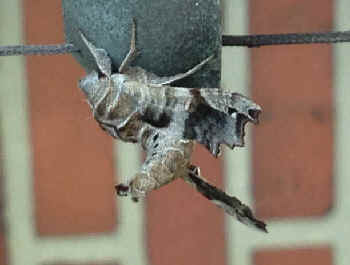
- Mournful Sphinx Moth (ph) ______
M#7851
NC PA (PM:5)
Enyo lugubris (in
the subfamily MACROGLOSSINAE)
The Mournful Sphinx Moth normally
ranges from North Carolina to Florida, and west to Texas. But it strays
north as far as southern Michigan, Aug-Oct. It occurs commonly all-year in
southern Florida.
- Alope Sphinx Moth
______ M#7832
(PM:30
(W:278)
Erinnyis alope (in the subfamily MACROGLOSSINAE)
The Alope Sphinx Moth is
normally Neotropical, in Latin America & the West Indies. It
occasionally strays northward to New Jersey. It occurs all-year in southern
Florida.
- Ello Sphinx Moth
______ M#7834 (PM:3)
(W:266)
Erinnyis ello (in the subfamily MACROGLOSSINAE)
The Ello Sphinx Moth is a
tropical moth, that strays as far north as New York and Michigan during
Apr-Oct.
- Obscure Sphinx Moth ______ M#7837
(PM:6)
Erinnyis obscura (in the
subfamily MACROGLOSSINAE)
The Obscure Sphinx Moth is a tropical moth that rarely strays north as
far as Pennsylvania during Aug-Sep. It occurs commonly in Florida &
Texas and rarely in Louisiana & Mississippi.
- Achemon Sphinx Moth ______ M#7861
MD
NC
NJ PA (PM:3) (PNE:267)
Eumorpha achemon
(in the subfamily MACROGLOSSINAE)
The Achemon Sphinx Moth occurs
from Massachusetts to Florida, and west to North Dakota & Texas. Adults
fly Jun-Aug.
- Banded Sphinx Moth ______ M#7865
MD NC PA (PM:3) (W:277)
Eumorpha fasciatus
(in the subfamily MACROGLOSSINAE)
The Banded Sphinx Moth is a tropical
species. It is sometimes common from Florida to Arkansas & Texas, and it
strays as far north as Michigan & Nova Scotia, flying Aug-Nov.
- Intermediate Sphinx Moth ______
M#7860 NC
Eumorpha intermedia
(in the subfamily MACROGLOSSINAE)
The Intermediate Sphinx Moth occurs
from coastal North Carolina to northern Florida, and west along the Gulf
Coast to Texas. Adults fly Apr-Oct.
- Gaudy Sphinx Moth (ph) ______
M#7866 (PM:3)
(species
described by Linnaeus in 1758)
Eumorpha labruscae (in the subfamily
MACROGLOSSINAE)
Eumorpha labruscae is a sphinx moth that can grow to the size of a
human hand. This migrating moth is commonly found in Central and South
America and the West Indies, and occasionally it occurs into the United
States and as far north as Canada, with strays occurring as far north as
Maine & Manitoba, flying Sep-Nov.
It is known as the Gaudy Sphinx Moth due to its remarkable markings and
the amazing array of colors on its wings.
It has a combination of green, blue, red, and yellow coloration on the
wings, thus explaining its flamboyant common name.
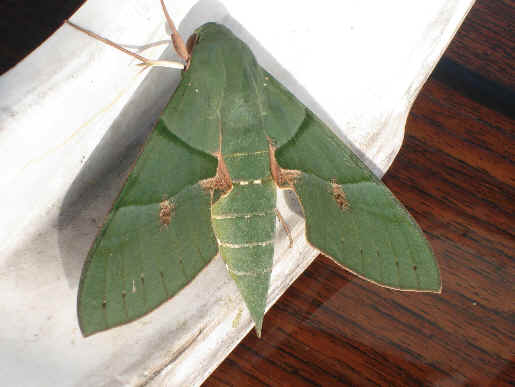
Above and below: Two photographs of a Gaudy
Sphinx Moth,
In the photo below, the colorful open wings
(photos by Helen Kyrk)
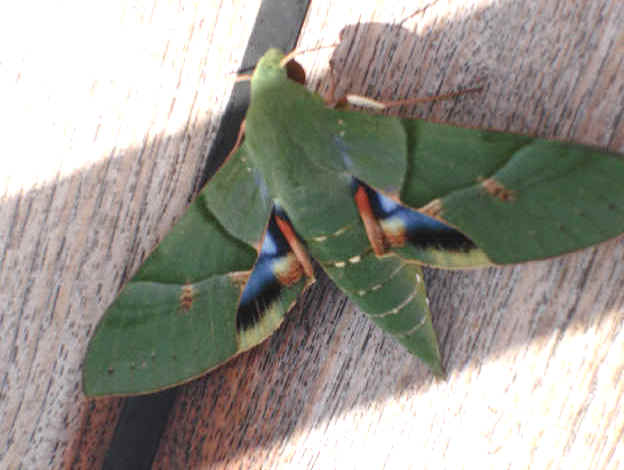
- Pandorus Sphinx Moth (ph) ______
M#7859 MD
NC
NJ
PA
(NA:547) (PM:3) (PNE:265) (W:269)
Eumorpha pandorus
(in the subfamily MACROGLOSSINAE)
The Pandorus Sphinx Moth visits flowers
at dusk and before dawn, but rarely feeds in total darkness,
Like most Sphinx Moths, it is strongly attracted to artificial lights.
This species was formerly was in the genus Pholus.
The Pandorus Sphinx Moth occurs commonly from Nova Scotia to
Florida, and west to Kansas and Texas. Adults fly Jun-Aug in the north,
and May-Oct in the deep south.
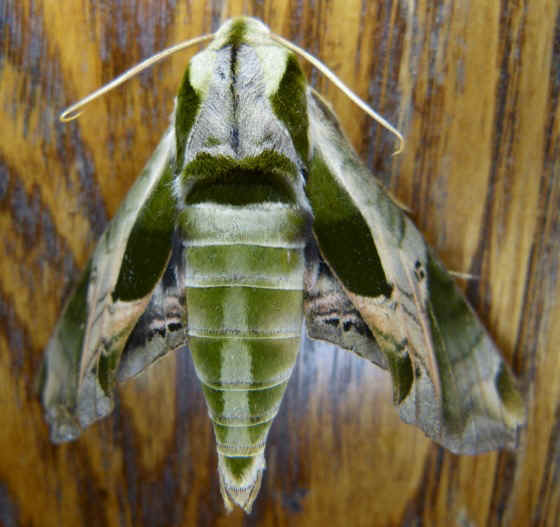
Pandorus Sphinx
- Vine Sphinx Moth ______ M#7864
(PM:3)
(species described by Linnaeus in 1758)
Eumorpha vitis (in the
subfamily MACROGLOSSINAE)
The Vine Sphinx Moth occurs from Massachusetts to Florida, and west to
Texas. In the north, it is a stray. In extreme southern Florida, it is
common, where there are 2 broods with adults flying Apr-May & Jul-Oct.
- Proud Sphinx Moth ______ M#7874
(PM:6) (W:277)
Proserpinus gaurae
The Proud Sphinx Moth occurs
from South Carolina to northern Florida, and west to Missouri and Texas.
it is local and rare, and in some states within its range there are either
infrequent records or none. Adults fly Apr-Aug.
- Abbott's Sphinx Moth ______ M#7870
MD NC PA (NW:114) (PM:6) (PNE:267) (W:270)
Sphecodina abbottii
The Abbott's Sphinx Moth occurs from
Maine to Florida, and west to Minnesota, Kansas, and Texas. It is locally
common. Adults fly Apr-Jul.
Sphecodina abbottii
comes to flowers, bait, and lights. The
male flies at dusk, while the female seems to fly around midnight.
Caterpillar food includes: grapes, woodbine.
- Pluto Sphinx Moth ______ M#7887
(PM:3) (W:276)
Xylophanes pluto (in the subfamily MACROGLOSSINAE)
The Pluto Sphinx Moth is
tropical, entering southern Florida & southern Texas, where it occurs
all-year and is sometimes common.
- Tersa Sphinx Moth (ph) ______
M#7890 MD
NC
NJ PA
(PM:6) (PNE:269) (W:276) (species described by Linnaeus in 1771)
Xylophanes tersa
(in the subfamily MACROGLOSSINAE)
The Tersa Sphinx Moth occurs
from southern Ontario & Massachusetts to Florida, and west to Wisconsin,
Kansas, and Texas. In the north, it is a stray, flying Jun-Oct. In the
south, it is common to abundant, flying Feb-Nov in Florida. It comes to
lights and flowers.
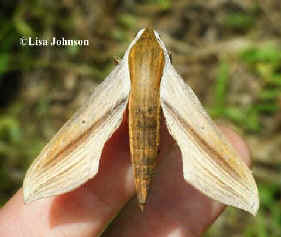
Tersa Sphinx Moth
(copyrighted photo by Lisa Johnson)
Family SATURNIIDAE: Giant Silk Moths
Giant Silk Moths, with wingspans of one
and one-eighths to five and seven-eighths inches (30 to 150mm) are the
largest moths in eastern North America.
Most are brightly colored, and some species have large, transparent eyespots
on their wings. The antennae are large and often feathery.
These moths do not have hearing organs, or tympana.
The short-lived adults have vestigal mouthparts and do not feed. They live off fat
and flesh laid down by the larvae.
They are usually seen at night, clinging to window screens or fluttering
like bats around streetlights.
Some species lay eggs singly. Others do so in small groups, and yet others
in large masses.
The caterpillars are smooth or spiny and generally feed on the foliage of
trees. In many species, the caterpillars spin a tough cocoon, which may be
attached to a twig or hidden in fallen leaves. In a few cases, however, the
pupa occupy a small chamber in soil instead of a cocoon. Most species
overwinter as pupae.
These large moths are not closely related to the true Asiatic silkworm.
- Regal Moth (ph) ______ M#7706
MD
NC
NJ
PA (NA:28,568) (PM:1,9) (PNE:251) (S:218) (W:231)
Citheronia regalis (in the subfamily CERATOCAMPINAE)
Citheronia regalis is also called the Royal Walnut Moth.
It is an attractive moth, but its slightly alarming caterpillar is commonly called the Hickory
Horned Devil. The caterpillar is so-called because of its
black-striped orange horns.
The species pupates without a cocoon in an earthen cell. There is 1
generation a year.
The Regal Moth occurs from Massachusetts to Florida, and west
to Kansas & Texas. It is common southward and rare northward. Adults fly
Jun-Sep.
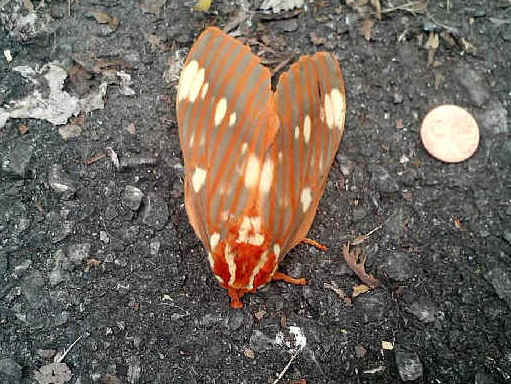
A Regal Moth, next to a US 1-cent
coin
(photo courtesy of Steve Trimble)
- Pine-devil Moth ______ M#7708
MD
NC
NJ PA (PM:9) (PNE:251) (W:230)
Citheronia sepuloralis (in the
subfamily CERATOCAMPINAE)
The Pine-Devil Moth occurs from Maine to Florida, and west to
Kentucky and Mississippi. It is common southward. Adults fly Jun-Aug.
The caterpillars of Citheronia
sepuloralis feed on pines.
- Imperial Moth (ph) ______
M#7704
MD NC NJ PA
(NA:19,550) (NW:91) (PNE:249) (S:219) (W:232)
Eacles imperialis (in the subfamily CERATOCAMPINAE)
Eacles imperialis pini ______ Pine Imperial Moth
Imperial Moth caterpillars pupate in earthen chambers.
Adults often fly to artificial lights, basking in the illumination until
dawn. Many also remain there throughout the day and are eaten by birds, so
unfortunately the species is becoming rare in areas where artificial lights
are common.
Caterpillar food, in the northern part of its range: conifers, especially
Red Pine, White Pine.
Close relatives of the Imperial Moth inhabit Latin
America.
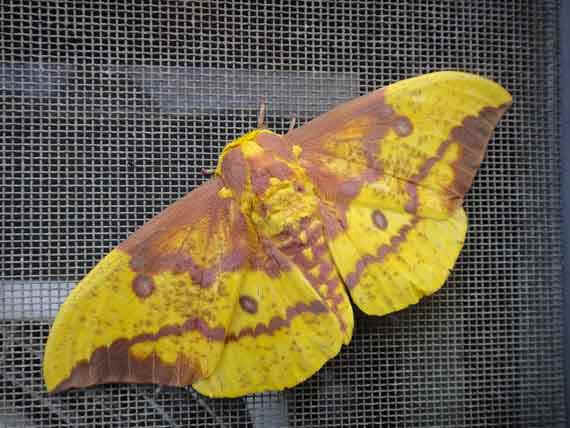
Above and below: the Imperial Moth
In the photo below, in Georgia in July 2014, a pen gives size reference.
(lower photo courtesy of Heather Zimmer)
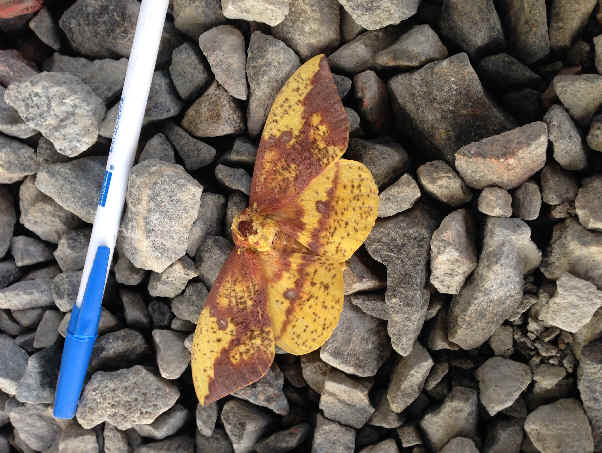
- Promethea Moth (ph) ______
M#7764 MD
NC
NJ
PA (NA:563) (NW:94) (PM:1,2,10) (PNE:255) (S:219) (W:243) Callosamia promethea
(in the subfamily SATURNIINAE)
Callosamia promethea
is also called the Spicebush Silkmoth.
The Promethea Moth occurs from southern Quebec & Maine to
northern Florida, and west to Minnesota & eastern Texas. It is common in
most of its range. Adults fly Jun-Jul northward with 1 brood, and Mar-May
& Jul-Aug southward with 2 broods.
Male Promethea Moths fly in the afternoon like butterflies. Females
fly only at night.
The caterpillars spin silken cocoons on plant stems, incorporating leaves.
They were once considered as being a possible source of raw silk, but
finding cheap labor to unreel the cocoons proved impractical in North
America and so the idea was abandoned.
Caterpillar food: often Black Cherry and ashes
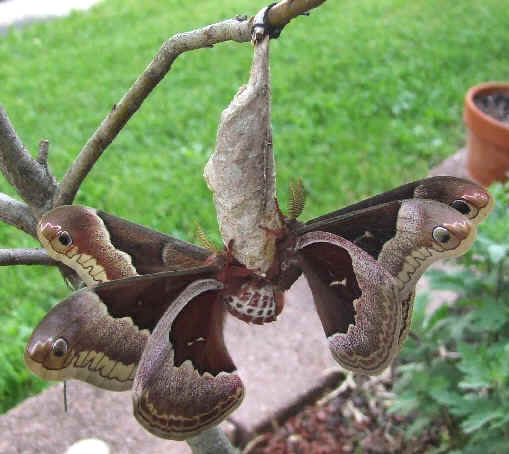
Promethea Moths
(photo by Stephen Kloiber)
- Tuliptree Silkmoth (ph) ______ M#7765
MD
NC
NJ
PA (PM:2,10) (PNE:255) (W:244)
Callosamia angulifera
(in the subfamily SATURNIINAE)
The Tuliptree Silkmoth
resembles the Promethea in pattern, but it is slightly larger. Both
sexes have prominent spots on the basal half of the wings. Its caterpillars
feed on Tulip Tree foliage.
The Tuliptree Silkmoth occurs from Massachusetts to northern Florida,
and west to Michigan & Mississippi. Adults fly in the north Jun-Aug with
1 brood, and in the south Apr-May & Jul-Aug with 2 broods. Both males
& females are active at night.
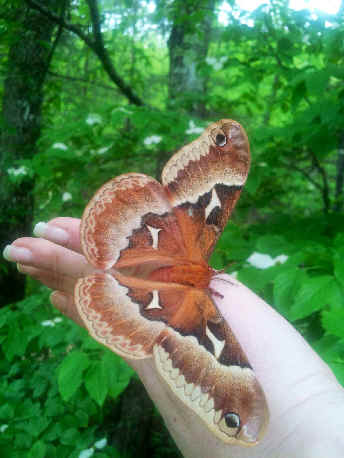
A Tuliptree Silkmoth
photographed in North Carolina in May 2015
(photo by Amanda Hendricks)
- Sweetbay Silkmoth ______ M#7766
MD
NC
(PM:2,10) (W:246)
Callosamia securifera
(in the subfamily SATURNIINAE)
The Sweetbay Silkmoth
occurs from Maryland to central Florida, west to Mississippi, in low
coastal swamps & pine flatlands. It is locally common. Adults fly
Apr-May & Jul-Sep. Males fly during the day. Females fly both day &
night.
- Io Moth (ph) ______ M#7746
MD
NC
NJ
PA
(NA:27,566) (NW:92) (PM:1,2,10) (PNE:253) (S:220) (W:238)
Autormeris io
(in the subfamily HEMILEUCINAE)
In eastern North America, the Io Moth occurs from southern Quebec
& Maine to Florida (& south to Costa Rica), and west to Manitoba,
Colorado, & Texas. At places, it is
common. Adults fly May-Sep, with 1 brood northward, and 2 or 3 in the
south.
Caterpillar food: many broad-leaved woody plants, also corn, clover
The spines of the Autormeris io
caterpillar cause a painful stinging if they penetrate human skin. The
caterpillar spins a thin, rather flimsy cocoon among debris on the
ground.
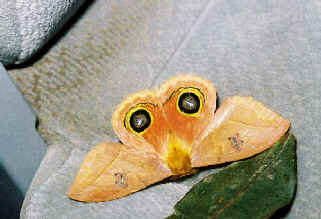
Above & below: Io Moths
In the upper picture, one photographed during a FONT tour
in the lower picture, a female in North Carolina in June 2015
(upper photo by Alan Brady, lower photo by Amanda
Hendricks)
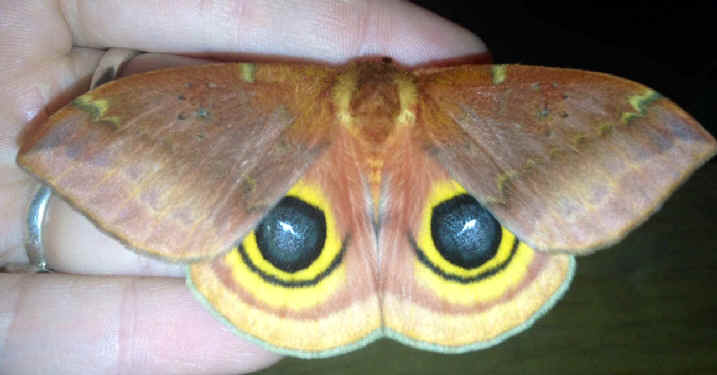
Followed here by another photograph of an Io Moth
in North Carolina in June 2015 (again, photo by Amanda
Hendricks)
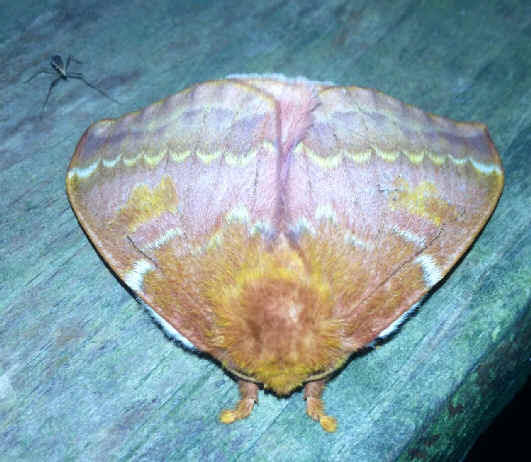
Below: caterpillars and eggs of the Io Moth
(photo, again, by Amanda Hendricks)
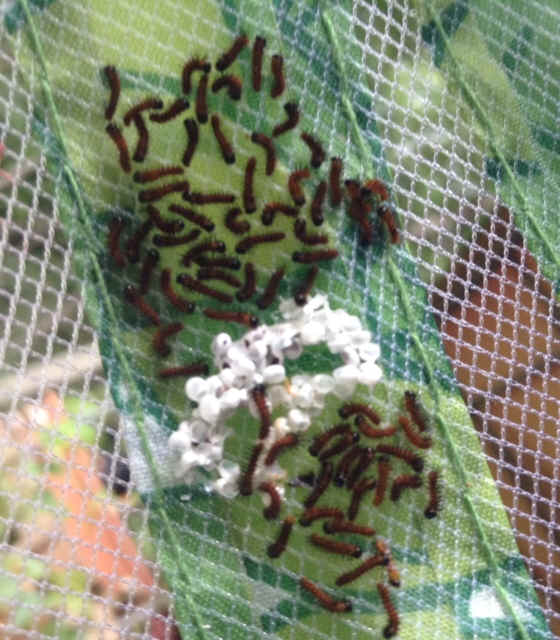
- Luna Moth (ph) ______ M#7758
MA MD
NC
NJ
PA (NA:24,573) (NW:97) (PNE:255) (S:222) (W:241) (species described
by Linnaeus in 1758)
Actias luna
(in the subfamily SATURNIINAE)
Another name for Actias luna
is the American Moon Moth. By whatever name, it is
normally nocturnal.
This beautiful moth is only
found in North America. it is now considered an endangered species as many
have been killed by pollutants and pesticides.
The caterpillar pupates in a thin cocoon, which may include a flexible leaf,
usually loose on the ground.
There are two well-defined generations a year in most of its range.
The Luna Moth occurs throughout eastern North America. Adults fly
May-Jul northward with 1 brood, and Mar-Sep southward with up to 3
broods.
Caterpillar food includes: Paper Birch
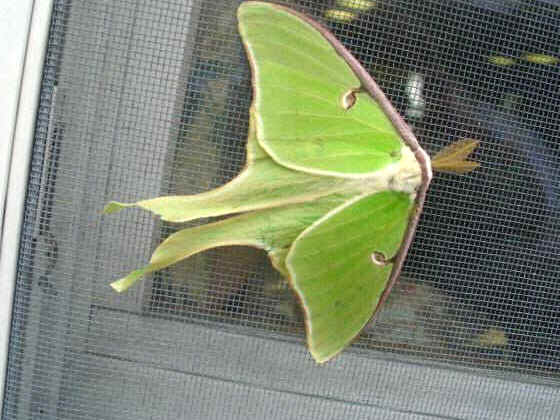
Above and below: Luna Moths
(upper photo by Kenneth Herbert,
lower photo by Amanda Hendricks, in North Carolina in May 2015)
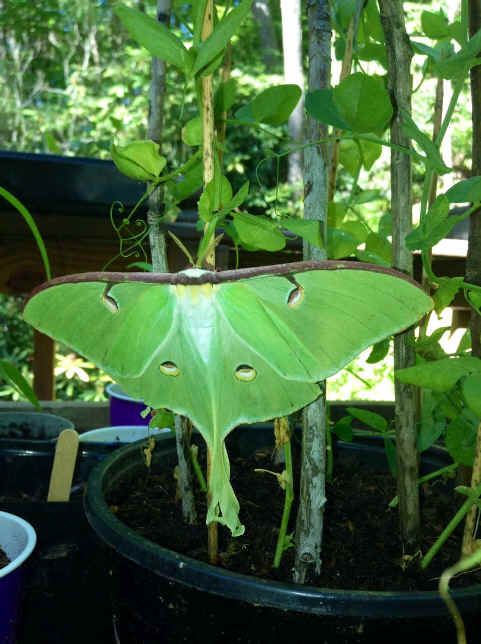
-
Polyphemus Moth (ph) ______
M#7757
MD NC NJ PA
(NA:23.567) (NW:96) (PM:1,2,9) (PNE:255) (S:225) (W:242)
Antheraea polyphemus (in the
subfamily SATURNIINAE)
Antheraea polyphemus is the most common member of the SATURNID
family in North America. It is common throughout eastern North America.
Adults fly in the north during May-Jul with 1 brood, and in the south
Apr-Sep with 2 broods.
Because of the conspicuous eyespot on each hind wing, this moth
is named after Polyphemus, the one-eyed giant of Greek myths.
At night, adults often fly to artificial lights.
The fully-grown caterpillars spin rough egg-shaped cocoons, which may remain
attached to branches, but usually fall with the leaves in late autumn.
Caterpillar food: birch, willow, maple, oak
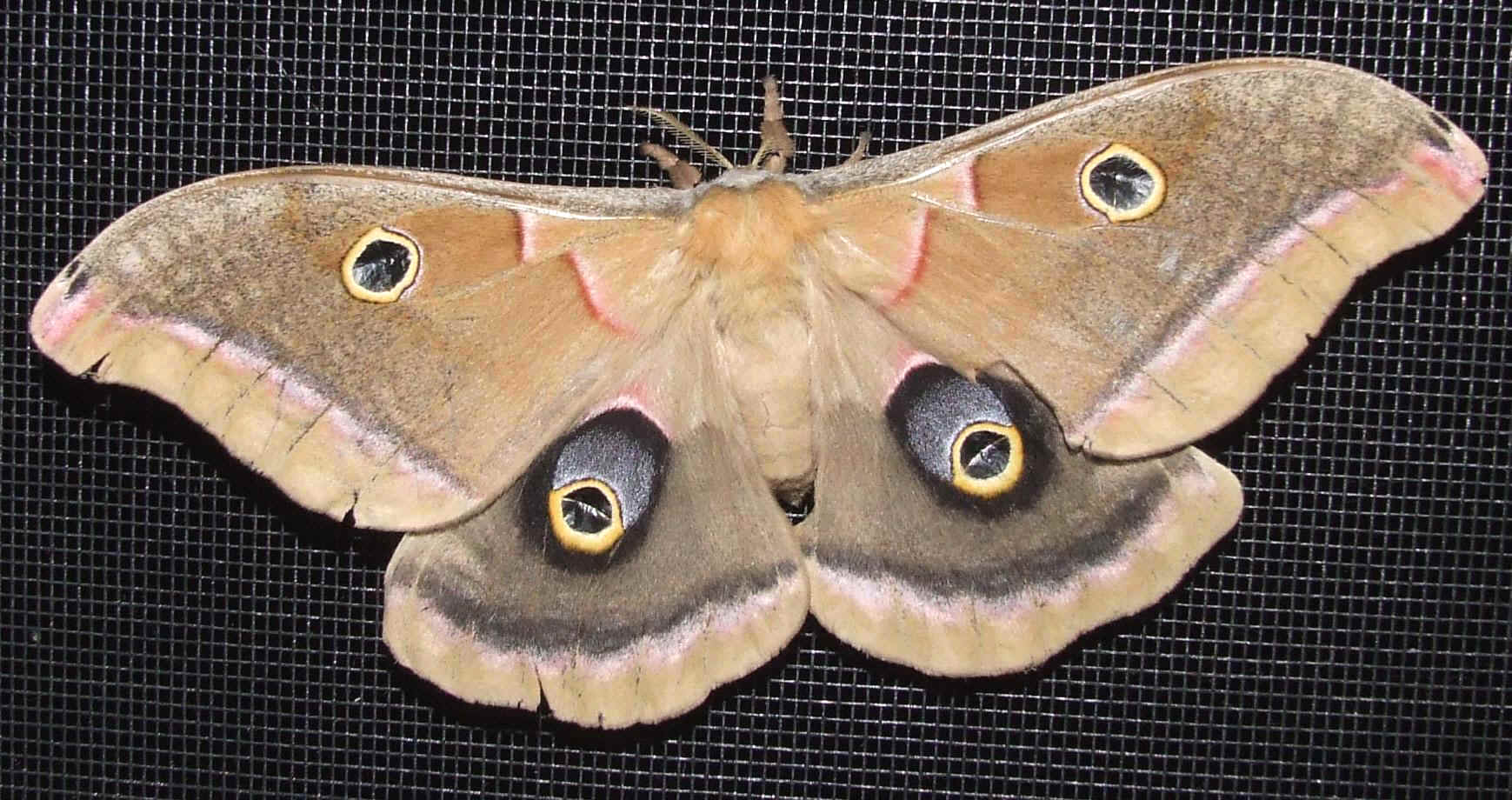
Above & below: Polyphemus Moths,
the lower photo in North Carolina in 2015
(upper photo by Stephen Kloiber; lower photo by Amanda Hendricks)
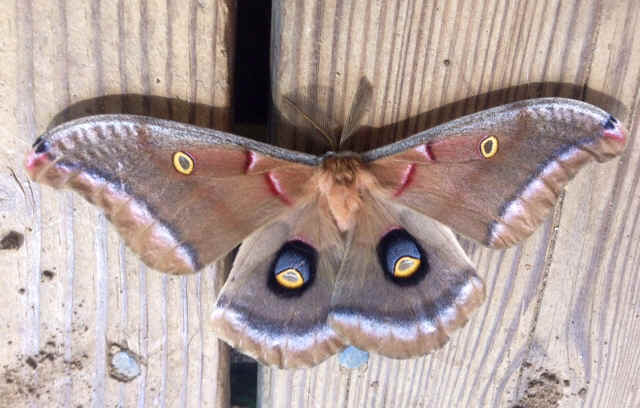
Below: 2 photos of a female Polyphemus Moth in Manhattan, New York City,
photographed in June 2015.
In the photo at right, it can be seen that she is laying eggs.
(photos below by Fred Mogul)
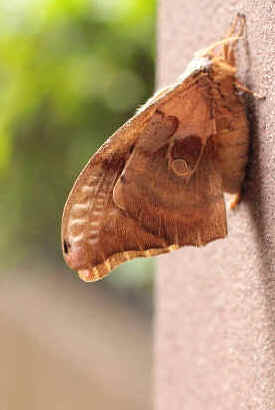

- Cecropia Moth (ph) ______
M#7767
MD
NC
NJ
PA
(NA:20,564) (NW:95) (PM:1,2,10) (PNE:257) (S:227) (W:245) (species described by Linnaeus in
1758)
Hyalophora cecropia (in the subfamily SATURNIINAE)
Hyalophora cecropia is also called the Robin Moth.
It is North America's largest moth and is common
throughout eastern North America. Adults fly May-Jul. Although they do fly
to lights at night, they also fly during the day, and they occur in urban
& surburban areas.
Its caterpillars spin large brown cocoons that weather to gray. The cocoon
is attached along one side of a branch, sometimes incorporating the branch
and even twigs into its structure. There is 1 generation a year.
Caterpillar food: favors maples, also tamarack, spruces
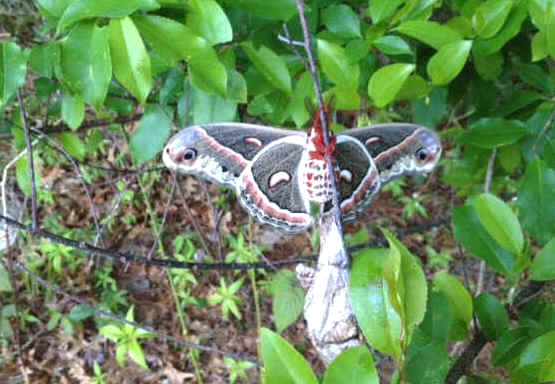
This photo of a Cecropia Moth, just recently
emerged from a cocoon,
was sent to us on May 29, 2014 by David Hubbard. With it, in an e-mail. he
wrote:
"I have lived in southeast Massachusetts for 49
years and this is the first I have ever seen.
Was pretty amazing. When I first saw it, the wings were closed and I did not
think twice about it.
Then, when I accidentally moved the bush that it was on, the wings opened.
Incredible!"
And the following photograph was sent to us a few weeks later, on July
12, 2014,
from Hudson, Ohio, where these 2 Cecropia Moths were in a backyard.
(photo courtesy of Richard Kazmier, taken by his wife. Sorry, don't know
her name)
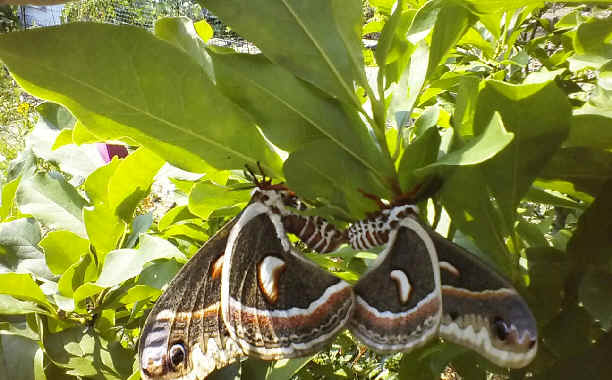
- Columbia Silkmoth ______ M#7768
(PM:10)
(PNE:257) (W:246)
Hyalophora columbia (in the subfamily SATURNIINAE)
The Columbia Silkmoth occurs from Nova Scotia to Maine and New
Hampshire, and west to Minnesota. It is found only in boggy northern forests
with acidic soil and many larch trees. Adults fly Jun to early-Jul.
- New England Buck Moth ______ M#7732
PA
(PM:9) (W:240)
Hemileuca lucina (in the subfamily HEMILEUCINAE)
Hemileuca lucina
is very local in boggy or wet meadows in Maine, New Hampshire, and Massachusetts. Adults fly in Sep, emerging earlier than
Hemileuc maia.
- Nevada Buck Moth complex ______
M#7731 NJ (W:240)
Hemileuca nevadensis
(complex) (in the subfamily HEMILEUCINAE)
- Eastern Buck Moth ______ M#7730
MD
NC
NJ PA
(NW:93) (PM:9) (PNE:253) (W:239)
Hemileuca maia (in the subfamily HEMILEUCINAE)
The Eastern Buck Moth occurs from Maine to Florida, and west to
Wisconsin, Kansas, and Texas. Adults fly Oct-Nov, in Sep northward, in Dec
in Florida.
Caterpillar food: often willows and polars, also bog buckbean
Hemileuca maia is a rapid
day-flier, best found between noon & 2pm in sunny days in oak
forests.
- Peigler's Oakworm Moth ______ M#7720
NC
Anisota peigleri (in the subfamily CERATOCAMPINAE)
The Peigler's Oakworm Moth occurs from North Carolina to northern
Florida. It is common in the Piedmont area. Adults fly Jul-Aug.
- Clear Oakworm Moth ______
M#7723.1 (said to be a subspecies of Anisota
virginiensis)
Anisota pellucida
(in the subfamily CERATOCAMPINAE)
The Clear Oakworm Moth occurs from North Carolina to Florida, and
west to Louisiana. Its favors oaks, especially Spanish and Water Oaks.
Adults fly Apr-Oct.
- Orange-tipped Oakworm Moth
______ M#7719 MD NC NJ PA
(PM:8) (PNE:251) (W:235)
Anisota senatoria (in the subfamily CERATOCAMPINAE)
The Orange-tipped Oakworm Moth occurs from Massachusetts to
Georgia, and west to Minnesota & eastern Texas. Adults fly Jun-Jul
northward, and May-Sept in the south.
Anisota senatoria
is a day-flier, and not easily collected.
- Spiny Oakworm Moth ______
M#7716 MD
NC
NJ PA
(PM:8) (PNE:251) (W:236)
Anisota stigma (in the subfamily CERATOCAMPINAE)
The Spiny Oakworm Moth occurs from southern Ontario and Massachusetts to Florida, and west to Minnesota, Kansas, and Texas. Adults
fly Jun-Jul in the north, and May-Aug southward.
- Pink-striped Oakworm Moth
______ M#7723 MD NC NJ PA
(NW:90) (PM:8) (PNE:253) (W:237)
Anisota virginiensis (in the subfamily CERATOCAMPINAE)
The Pink-striped Oakworm Moth occurs commonly from Nova Scotia to
Virginia, and west to Manitoba and Arkansas. Adults fly in the north Jun-Jul
with 1 broods, and in the south May-Oct with 2 broods.
Caterpillar food: oaks, especially Red Oak.
- Rosy Maple Moth (ph) ______
M#7715 MD
NC NJ
PA (NA:572) (NW:89) (PM:8) (PNE:251) (W:234)
Dryocampa rubicunda (in the subfamily CERATOCAMPINAE)
The Rosy Maple Moth occurs commonly from Nova Scotia to Florida,
and west to Nebraska & Texas. Adults fly May-Aug in the north, and
Apr-Sep in the south.
The caterpillar of Dryocampa rubicunda
is called the Green-striped Mapleworm. They are sometimes so abundant that they strip trees of all their
foliage.
Caterpillar food includes: red maple, sugar maple, silver maple
Adult Rosy Maple Moths emerge in the late afternoon or evening.
Mating occurs about 10pm to midnight. Pairs remain together through the next
day.
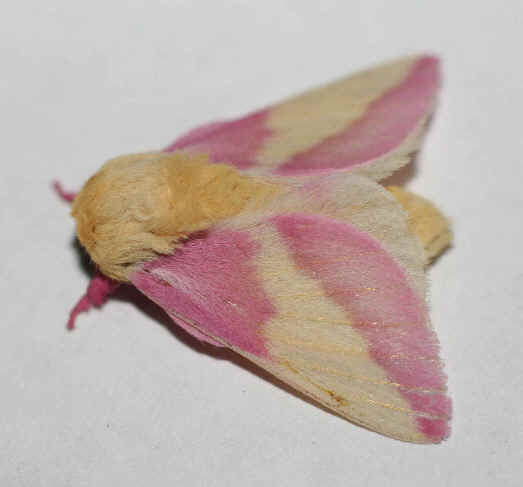
Rosy Maple Moth
(photo by Stephen Kloiber)
- Bicolored Honey Locust Moth
______ M#7709 NC
(PM:8) (PNE:251) (W:233)
Syssphinx bicolor (formerly Sphingicampa bicolor) (in the subfamily
CERATOCAMPINAE)
Syssphinx bicolor
is also called simply the Honey Locust Moth.
The Honey Locust Moth occurs commonly from New Jersey to
Georgia, and west to Nebraska & Texas. Adults fly Apr-Sep.
There are usually 3 broods:
The 1st brood is grayish. The 2nd brood is pale yellow to brown. The 3rd
brood is a darker brown with heavy spotting.
- Bisected Honey Locust Moth
______ M#7712 (PNE:251) (W:240)
Syssphinx bisecta
(formerly Sphingicampa bisecta) (in the subfamily
CERATOCAMPINAE)
- Cynthia Moth (i) ______
MD PA
(NA:12,562) (PM:10) (also called
Ailanthus Silkmoth)
Samia cynthia
The Cynthia Moth is native
to the Orient. It was introduced into Philadelphia in the 1860s. From there,
it spread with the Ailanthus Tree to other cities in eastern North America.
The caterpillars devour shed skins and pupate in cocoons wrapped in leaves
fastened with silk to branches. There is 1 generation a year.
And there is no closely-related moth occurring in the New World.
Family LASIOCAMPIDAE:
Lappet Moths & Tent Caterpillars
In the family LASIOCAMPIDAE,
the heavy-bodied, dull brown moths have wingspans from seven-eighths of an
inch to four and one-eighth inches (22 to 105mm).
Unlike the OWLET MOTHS, the adults do not feed and have only a very
small proboscis or none at all. They ahve shorter wings and more feathery
antennae.
The males' antennae are bipectinate, having two feathery branches on each
segment.
The caterpillars (from 1 and a half to 3 inches, 37 to 75mm) are slender and
hairy. In many species they are social, living together in silken tents and
feeding on the foliage of trees. The cocoon is frequently spun in some
protected place, such as in an eave of a house, or in loose
bark. .
- Dot-lined White Moth ______ M#7683
NJ
PA
(PM:11) (PNE:247) (W:224)
Artace cribraria
The Dot-lined White occurs from Long Island, New York
to Florida, and west to Kentucky & southeastern Texas. It is common in
the south, and uncommon to rare northward. Adults fly Jun-Oct.
- Riley's Lappet Moth ______ M#7685
(PM:11) (PNE:249) (W:225)
Heteropacha rileyana
The Riley's Lappet Moth occurs from southern Ontario
to Florida, and west to Wisconsin & Texas. It is modrately common, and
its favored food is Honey Locust. Adults fly Mar-Nov.
- Eastern Tent Caterpillar Moth (ph) ______
M#7701 NJ PA (NW:85)
(PM:1,11)
(PNE:249) (S:207) (W:226)
Malacosoma americanum
Malacosoma americanum
is widespread in eastern North America. It lays eggs in cuff-like
clusters around twigs of apple, pear, wild cherry, and hawthorn trees. Its
caterpillars defoliate and sometimes kill a tree, emerging only at intervals
from large communal silken tents. Adults fly May-Jun.
Caterpillar food: especially Black Cherry, and members of the rose family
Eastern Tent Caterpillars are chemically defended, and are so shunned
by many birds, except Yellow-billed and Black-billed Cuckoos,
whose local populations increase during times of tent caterpillar
outbreaks.
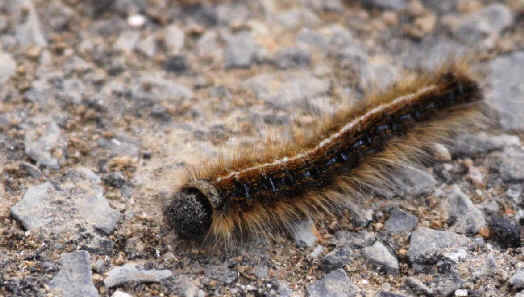
Above: the Eastern Tent Caterpillar
Below: the moth that it becomes
(upper photo by Marie Gardner, lower photo by Stephen Kloiber)
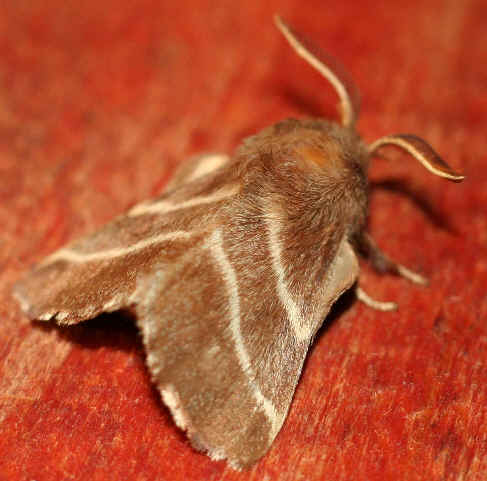
- Western Tent Caterpillar Moth
______ M#7702 (W:225)
Malacosoma
californicum
The Western Tent Caterpillar
occurs from British Columbia
to Quebec, and south in the East to upstate New Hampshire and New York.
- Forest Tent Caterpillar Moth ______
M#7698
PA
(NW:86) (PM:11) (PNE:249) (W:227)
Malacocoma disstria
The Forest Tent Caterpillar
Moth occurs throughout eastern North America. It is often common
locally, with adults moving as they seek fresh food sources. Adults fly
Apr-Sep.
Caterpillar food: often aspens and maples, but not Red Maple
Unlike other tent caterpillars, Malacocoma
disstria do not make tent-like webs.
- American Lappet Moth ______ M#7687
PA
(NW:84) (PM:8) (PNE:249) (W:228)
Phyllodesma americana
The Lappet Moth occurs from Nova Scotia to Georgia, and
west across southern Canada and south to Texas. It is rare to locally
common. Adults fly Mar-Sep. Adults fly Mar-Apr, & as early as Jan in
Florida.
Caterpillar food: often aspen and willow
- Southern Lappet Moth
______ M#7686
Phyllodesma
occidentalis (formerly carpinifolia)
The Southern Lappet Moth
occurs from coastal South Carolina to Florida, and west to Kentucky &
Texas.
- Larch Tolype ______ M#7673
(PNE:247)
Tolype laricis
The Larch Tolype occurs from Nova Scotia to New York, and west
across Canada & the northern US states.
Favored caterpillar food includes: larches,
firs, pines, and other conifers. Adults fly Jul-Sep.
- Southern Tolype ______ M#7675
Tolype minta
The Southern Tolype occurs from coastal South Carolina to
Florida. Adults fly Apr-Dec.
- Small Tolype ______ M#7674
(PM:8) (PNE:247)
Tolype notialis
The Small Tolype occurs from northern Virginia to Florida, and
west to Kentucky. It is common southward. Adults fly Jun-Sep.
The Small Tolype is very similar to the Large Tolype (below),
but it is usually much smaller and more variable in color. Records have been
confused with those of the Large Tolype.
- Large Tolype (or "Veiled
Moth") (ph) ______ M#7670
PA
(NW:83) (PM:8) (PNE:247) (S:209)
(W:223)
Tolype velleda
The Large Tolype occurs commonly from Nova Scotia to central
Florida, and west to Minnesota & Texas. Aduls fly Sep-Oct.
Family APATELODIDAE:
Apatelodid Moths,
including BOMBYCIDAE: the
Silkworm Moths
- Spotted Apatelodes ______ M#7663
NJ PA (PM:8)
(PNE:245)
Apatelodes torrefacta
The Spotted Apatelodes occurs commonly from southern Ontario & Maine to
Florida, and west to Wisconsin, Missouri, Texas. Adults fly May-Aug, with 2
broods southward.
- The Angel ______
M#7665 MA (PM:8)
(PNE:247)
Olceclostera angelica
The Angel
occurs from southern Ontario & Maine to South Carolina, and
west to Wisconsin & Missouri. It is uncommon. Adults fly May-Sep.
Family MIMALLONIDAE: Sack-bearers
- Melsheimer's Sack-bearer ______
M#7662
(PM:8) (PNE:245)
Cicinnus melsheimeri
The Melsheimer's Sack-bearer occurs from southern Ontario &
Massachusetts to Florida, and west to Wisconsin & Texas. It is most
common in sandy, oak-barren habitats. Adults fly May-Jul.
- Scalloped Sack-bearer ______ M#7659
NJ PA (PM:11) (PNE:245)
Lacosoma chiridota
The Scalloped Sack-bearer occurs from southern Ontario & New Hampshire
to Florida, and west to Iowa & Texas. Adults fly Apr-Sep. Males rarely
come to lights.
Subfamily EPIPLEMINAE (in the Family URANIIDAE):
Scoopwings
- Brown Scoopwing ______ M#7653
PA (NW:81) (PNE:179)
Calledapteryx dryopterata
Caterpillar food:
viburnums
- Gray Scoopwing
______ M#7650 (PNE:179)
Callizzia amorata
Family DREPANIAE: Hooktip Moths
- Arched Hooktip ______ M#6251
PA
(NW:25) (PNE:177) (S:189) (W:140) (the Masked Birch Caterpillar)
Drepana arcuata
Caterpillar food:
alders and birches
- Two-lined Hooktip ______ M#6252
(NW:26) (PNE:179)
Drepana bilineata
Caterpillar food:
Paper Birch and alders, also aspens and elms
- Northern Eudeilinia ______ M#6253 (PNE:179)
Eudeilinia herminiata
- Dogwood Thyatirid ______ M#6240
(NW:24) (PNE:177)
Euthyatira pudens
Caterpillar food: dogwoods
- Glorious Harbrosyne (*) ______ M#6236
PA (PNE:177)
Habrosyne gloriosa
PA: 2015, Jul 25
- Lettered Harbrosyne ______ M#6235
PA
(NW:23) (PNE:177) (S:188)
Habrosyne scripta
Caterpillar food: birches, blackberries, raspberries
- Rose Hooktip (ph) ______
M#6255 NC PA (NW:27)
(PNE:179)
(W:139)
Oreta rosea
Caterpillar food: viburnums, especially
Nannyberry; also birches
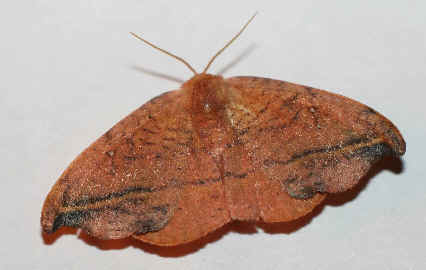
Rose Hooktip
(photo by Stephen Kloiber)
- Tufted Thyatirin Moth ______ M#6237
PA (PNE:177)
Pseudothyatira
cymatophoroides
Family GEOMETRIDAE:
Geometer Moths, including Loopers, Inchworms, Spanworms
Moths in the large and varied family GEOMETRIDAE
are rather delicate with slender bodies and broad, flimsy wings spanning
three-eighths to two and a half inches (8 to 65mm).
They are easily recognized by their habit of spreading their wings out when
at rest, exposing a similarly patterned fore and hind wings.
In a few species, the females are wingless. Some species feed as adults.
Some do not.
The larvae are the familiar measuringworms or inchworms -
slender caterpillars with 1 or 2 pairs of prolegs at the end of the abdomen
and a characteristic looping method of locomotion. They feed on many
different plants and are often seen hanging by a strand of silk from the
foliage of trees.
- Olive-and-black Carpet Moth ______
M#7635
MD (PNE:197)
Acasis viridata
- Four-barred Gray Moth ______ M#6570
MD NC (PM:52) (PNE:217)
Aethalura intertexta
The Four-barred Gray Moth occurs uncommonly from Newfoundland to Florida, and
west to Manitoba & Missouri. Adults fly Apr-Jul, with 2 broods
southward.
- Fall Cankerworm Moth ______
M#6258 MD (NW:29) (PNE:209)
Alsophila pometaria
Caterpillar food:
new foliage of many broad-leaved woody plants
- Common Gray Moth (ph) ______
M#6590 MD
NC NJ PA
(PNE:219) (W:195)
Anavitrinella pampinaria
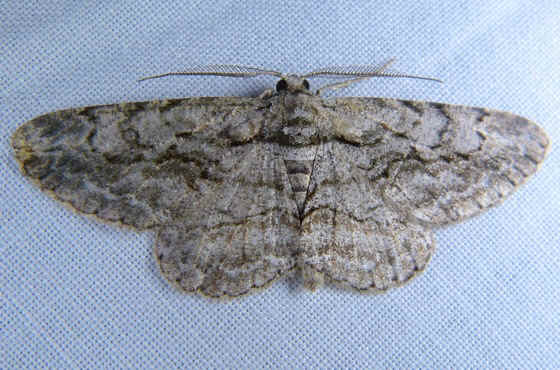
Common Gray Moth
(photo by Marcie O'Connor)
- Variable Antepione ______ M#6987
NC PA
(PNE:243) (W:195) In NC: low
mountains
Antepione thisoaria
- Many-lined Carpet ______ M#7330 (PNE:189)
Anticlea multiferata
- Variable Carpet ______
M#7329 PA (NW:73)
(PNE:187)
Anticlea vasiliata
- The Infant ______ M#6256
(PM:46) (PNE:207)
Archiearis infans
The Infant
occurs from Nova Scotia to New Jersey & Pennsylvania, and
west through Canada and south to Minnesota. Adults fly Mar to early-May, on
warm afternoons in birch forests.
- Fall Cankerworm Moth ______
(PM:46,47) (S:190) (W:144)
Asophilo
(formerly Msophila)
pometaria
The Fall Cankerworm Moth occurs commonly from Nova Scotia to northern
Florida, and west to Manitoba & Kansas. Adults fly Sep-May, mostly
Oct-Dec northward.
- Straw Besma Moth ______ M#6884
MD NC PA (PNE:239)
Besma endroplaria
Caterpillar food: maple, notably Sugar Maple, also alder,
birch, oak.
- Oak Besma Moth (ph) ______ M#6885
MD NC NJ PA (NW:52)
(PNE:239)
(W:185) In NC: low mountains
Besma quercivoraria
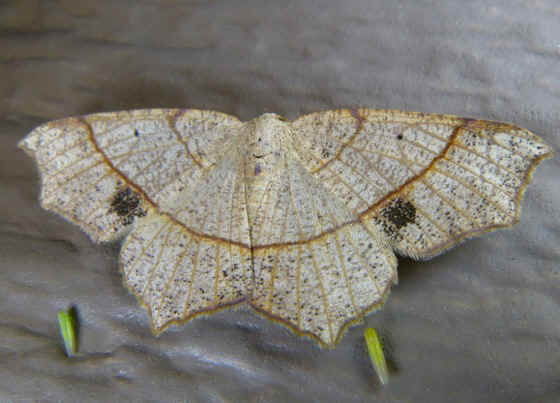
Oak Besma Moth
(photo by Marcie
O'Connor)
- Pepper and Salt Geometer (ph) ______
M#6640 MD PA
(NW:35) (PNE:221) (W:161)
Biston betularia
The caterpillar of Biston
betularia is called the Cleft-headed Looper. The adult
is also called the Peppered Moth.
Caterpillar food: many plants but often
Paper Birch and willows

Pepper-and-Salt Geometer
(photo by Marcie O'Connor)
- Yellow-dusted Cream Moth ______
M#6677 PA
(NW:40) (PNE:225) (W:170)
Cabera erythemaria
Caterpillar food: often willows, also
poplars
- The Vestal ______ M#6678
(PNE:227)
Cabera variolaria
- Cross-lined Wave Moth ______ M#7147
PA
Calothysanis amaturaria
- Pale Beauty (ph) ______ M#6796
MD NJ
PA
(NW:44) (PNE:229) (W:176)
(caterpillar called the Fringed Looper)
Campaea perlata
The Pale Beauty occurs commonly from
Labrador to western North Carolina & Tennessee, and west across Canada,
south to Missouri. Adults fly May-Sep, with 2
broods. Abundance can fluctuate greatly from year to year.
Caterpillar food: birch, White Spruce, tamarack, blueberry, cranberry

Pale Beauty
(photo by Rise Hill)
- Brown Pine Looper Moth ______
M#6867 MD
(PNE:239)
Caripeta angustiorata
- Southern Pine Looper Moth
______ M#6869 NC
In NC: low mountains
Caripeta aretaria
- Gray Spruce Looper Moth ______ M#6863
MD (PNE:239)
Caripeta divisata
Caterpillar food:
Eastern Hemlock, spruces, firs, tamarack
- Northern Pine Looper Moth ______
M#6864 PA
(NW:51) (PNE:239) (W:184)
Caripeta piniata
Caterpillar food: especially pines
- Scallop Moth ______
M#6835 (NW:49) (PNE:235)
Cepphis armataria
- Dark Scallop Moth ______ M#6834 (PNE:235)
Cepphis decoloraria
- Blackberry Looper Moth (ph) ______
M#7071 MD NJ PA
(NW:63) (PNE:207) (W:197)
Chlorochlamys
chloroleucaria
Chlorochlamys chloroleucaria
is an "Emerald".
Caterpillar food: fruits and flowers of
blackberries and raspberries

Blackberry Looper Moth
(photo by Marcie O'Connor)
- Chain-dotted Geometer (ph) ______
M#6898 MD PA
(PNE:241) (W:187)
Cingilia catanaria
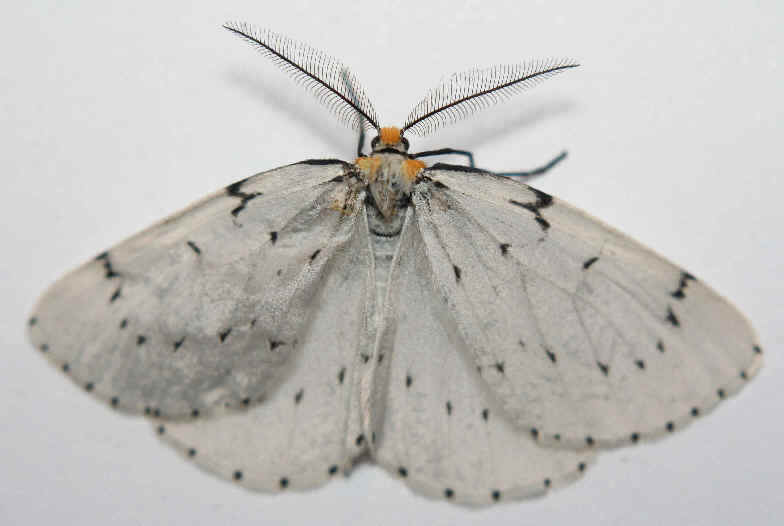
Chain-dotted Geometer Moth
(photo by Stephen Kloiber)
- The Scribbler ______ M#7639
MD (NW:79) (PNE:197)
Cladara atroliturata
Caterpillar food:
alders, Paper Birch, maples, willows
- Mottled Gray Carpet ______ M#7637
MD PA
(PNE:197) (W:212)
Cladara
limitaria
The caterpillar of Cladara
limitaria is called the Yellow-lined Conifer Looper.
- Double-lined Gray Moth (ph) ______
M#6594 MD NJ PA (PNE:219)
(W:155)
Cleora sublunaria
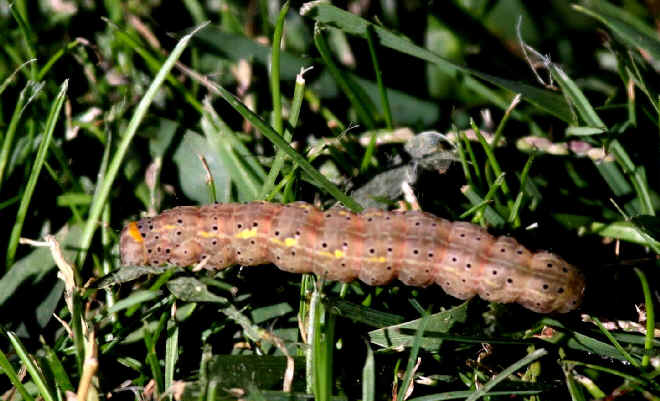
Notice the black spots on this caterpillar of the Double-lined Gray Moth
(photo by Marie Gardner)
- Barberry Geometer Moth ______ M#7290
NJ PA
(PNE:185) (W:208)
Coryphista
meadii
The caterpillar of Coryphista
meadii is called the Barberry Looper.
- Bent-line Carpet Moth ______ M#7416
NJ
PA
(PNE:191) (W:215)
Costaconvexa (or
Orthonama) centrostrigaria
- Wax Myrtle Wave ______ MD
(W:205)
Cyclophora myrtaria
- Cyclophora nanaria
______ MD
- Packard's Wave Moth ______ M#7136
MD NJ PA (PNE:201)
Cyclophora packardi
- Sweetfern Geometer Moth ______ M#7139
MD PA
(PNE:201) (W:202) (a Wave)
Cyclophora
pendulinaria
- Showy Emerald ______ M#7053
MD PA (PNE:205) (W:198)
Dichorda Iridaria
- Curve-lined Angle Moth ______ M#6362
MD NJ PA (NW:33)
(PM:50)
(PNE:215) (W:149)
Digrammia continuata
(has been Macaria
continuata,
was Macaria orillata)
The Curve-lined Angle Moth occurs from
Maine to Florida, and west to Manitoba & Texas. It is locally common.
Adults fly Mar-Oct.
- Hollow-spotted Angle Moth ______ M#6405
MD (PNE:215)
Digrammia gnophosaria
- Yellow-lined Angle Moth ______
M#6397 (NW:33) (PNE:215)
Digrammia mellistrigata
- Faint-spotted Angle Moth (ph) ______
M#6386 MD PA
(PM:51) (PNE:215) (W:150)
Digrammia ocellinata
The Faint-spotted Angle occurs from
Quebec and Maine to Florida, and west to Nebraska & Louisiana. It is
common to abundant. Adults fly Apr-Oct.
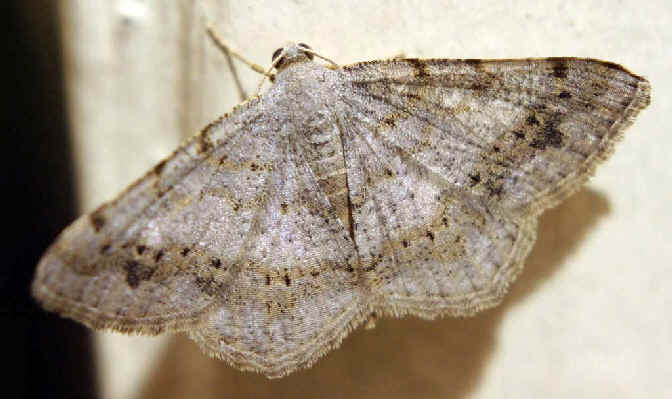
Faint-spotted Angle Moth
(photo by Stephen Kloiber)
- Somber Carpet ______ M#7417
NJ (PNE:191)
Disclisioprocta stellata
- The Bad Wing (ph) ______ M#7648
MD NC PA (PNE:199)
In NC: low mountains
Dyspteris abortivaria

The Bad Wing
(photo by Marcie O'Connor)
- Dark Marbled Carpet ______ M#7182
MD (PNE:181)
Dysstroma citrata
- Orange-barred Carpet ______
M#7189 MD
(NW:68) (PM:49) (PNE:181)
Dysstroma hersiliata
The Orange-barred Carpet occurs commonly from Labrador to
Pennsylvania mountains, and west across Canada, south to Minnesota. Adults
fly Jun-Aug.
Caterpillar food: currants and gooseberries
- Marbled Carpet ______ (PM:49)
Dysstroma truncata
The Marbled Carpet is Holarctic. In eastern North America, it
occurs from Labrador to North Carolina, and west through Canada, south to
Missouri. It is common northward. Adults fly Jun-Aug.
- Dark-banded Geometer ______ MD
(PM:47)
Ecliptopera atricolorata
The Dark-banded Geometer occurs from southern Quebec to northern
Florida, and west to Arkansas. It is locally common. Adults fly May-Jul.
- Small Phoenix ______ M#7213 (PNE:183)
Ecliptoperea silaceata
The Small Phoenix occurs from Labrador to Maine, and west to
Manitoba and Wisconsin. It is uncommon. Adults fly May-Sep.
- Pale-veined Econista ______
(PM:50)
Econista dislocaria
The Pale-veined Econista occurs uncommonly from Ontario & western
Pennsylvania to South Carolina & Mississippi, and west to South Dakota
& Texas. Adults fly Apr-Jun.
- Small Engrailed Moth (*) ______ M#6597
MD PA
(NW:34) (PNE:219) (W:156)
Ectropis crepuscularia
The caterpillar of Ectropis
crepuscularia is called the Saddleback Looper.
PA: 2015, July 25
- Cranberry Spanworm Moth ______ M#6436
(PM:50)
(PNE:217)
Ematurga amitaria
The Cranberry Spanworm Moth occurs from Nova Scotia to
Pennsylvania, west to Minnesota. It is locally common. Adult fly May-Aug.
The species is a day-flier in bogs and wet meadows.
- Maple Spanworm Moth (ph) ______
M#6797 MD PA
(NW:45) (PNE:231) (W:177)
Ennomos magnaria
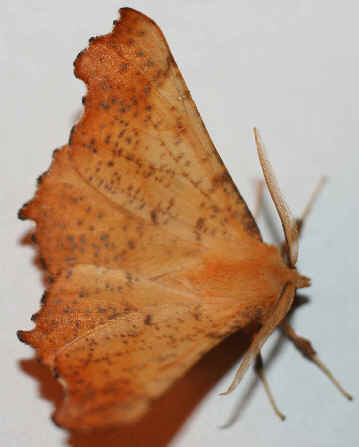
Maple Spanworm Moth
(photo by
Stephen Kloiber)
- Elm Spanworm Moth (ph) ______
M#6798 MD PA
(PNE:231) (S:199) (W:178)
Ennomos subsignaria
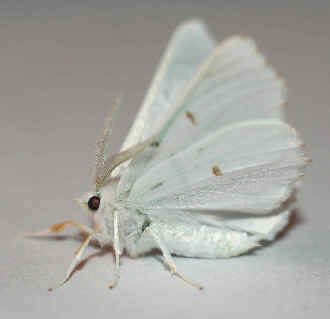
Elm Spanworm Moth
(photo by Stephen Kloiber)
- Black-banded Orange ______
M#6321 (NW:33) (PNE:211)
Epelis truncataria (or Macaria truncataria)
- Tulip-tree Beauty (ph) ______ M#6599
MD NJ PA (NA:560) (PNE:219) (S:200) (W:158)
Epimecis hortaria
The Tulip Tree Beauty is
one of the largest geometrids in North America. It rests with its wings
fully spread and pressed flat against the bark of a tree, where it is so
well camouflaged that it is almost invisible.
In 1936, the caterpillars of the Epimecis
hortaria severely defoliated Sassafras Trees in
Connecticut.
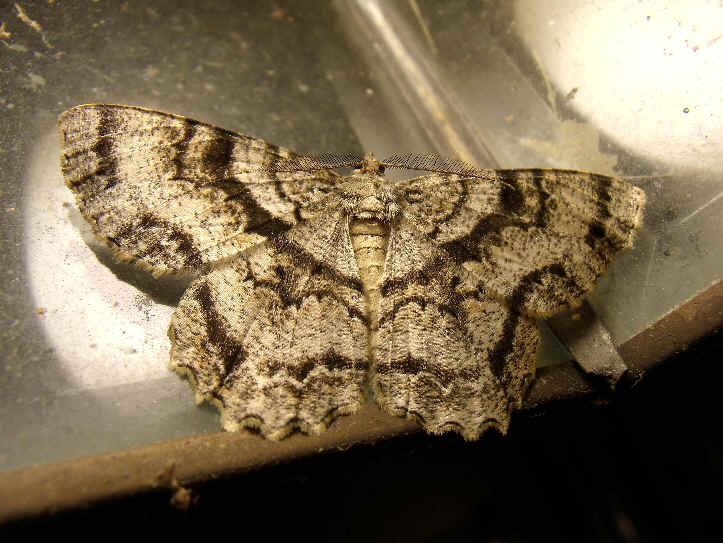
Tulip-tree Beauty
(photo courtesy of Claudine Iannucci)
- White-banded Toothed Carpet Moth (ph)
______ M#7394 PA
(PNE:189) (W:215)
Epirrhoe alternata
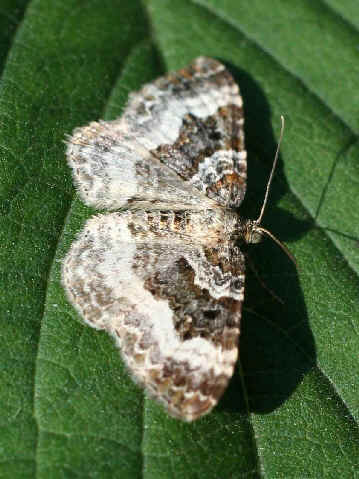
White-banded Toothed Carpet Moth
(photo by Stephen Kloiber)
- Autumnal Moth ______
M#7433 (PNE:193)
Epirrita autumnata
- Linden Looper ______
M#6665 PA
(NW:39) (PNE:225) (W:168)
Erannis tiliaria
Other names for
Erannis tilaria are Basswood Looper and Winter
Moth.
In the northeastern US, Erannis
tiliaria is one of the most common moths at porch lights in
the late autumn.
- The Beggar ______ M#7440
PA
(NW:76) (PNE:193) (W:215)
Eubaphe mendica
Caterpillar food: violets
- The Little Begger ______
M#7441 (PNE:193)
Eubaphe meridiana
- Deep Yellow Euchlaena Moth ______
M#6733
MD NC NJ PA
(PNE:227)
Euchlaena amoenaria
- Least-marked Euchlaena Moth ______
M#6739 MD NJ (PNE:227)
Euchlaena irraria
- Johnson's Euchlaena Moth ______
M#6729
MD
(NW:58) (PNE:227)
Euchlaena johnsonaria
- Muzaria Euchlaena Moth ______ M#6725
MD (PNE:227)
Euchlaena muzaria
- Obtuse Euchlaena Moth ______ M#6726
MD NJ PA
(W:172)
Euchlaena obtusaria
- The Saw-wing ______ M#6724
MD (PNE:227)
Euchlaena serrata
- Mottled Euchlaena Moth ______
M#6737 MD (PNE:227)
Euchlaena tigrinaria
- Sharp-lined Powder Moth ______ M#6639
MD (PNE:221)
Eufidonia discospilata
- Powder Moth ______ M#6638
MD PA
(PNE:221) (W:160)
Eufidonia notataria
- Snowy Geometer ______
(NW:59)
Eugonobapta nivosaria (the only known
member of its genus)
Caterpillar food: basswood, maples, cherries, dogwoods,
meadow-rue
- Lesser Grapevine Looper Moth (ph) ______
M#7196 MD PA
(NW:69) (PM:49) (PNE:181) (W:206)
Eulithis
diversilineata
Eulithis diversilineata
is a "Carpet" moth.
The Lesser Grapevine Looper
occurs commonly throughout eastern North America. Adults fly from late-May
to Oct.
Caterpillar food: specializes on grape and woodbine
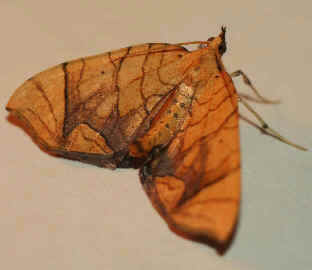
Lesser Grapevine Looper Moth
(photo by Stephen Kloiber)
- White Eulithis ______
M#7206 MD (PM:47)
(PNE:183)
Eulithis explanata
The White Eulithis occurs from Labrador to the North Carolina
mountains, and west across Canada south to Minnesota. It is locally common.
A favored food is the blueberry. Adults fly Jun-Sep.
- Greater Grapevine Looper Moth
______ M#7197 MD
NJ (NW:69) (PNE:181)
Eulithis gracilineata
The range of the Greater Grapevine Looper Moth is the same as
that of the Lesser Grapevine Looper Moth.
Caterpillars
of both specialize on grape and woodbine.
- Dimorphic Eulithis ______
M#7203 MD
(PNE:183)
Eulithis molliculata
The Dimorphic Eulithis occurs from Quebec to Pennsylvania, and
west to Minnesota. Adults fly Jun-Aug.
- Serrated Eulithis ______ M#7208 (PNE:183)
Eulithis serrataria
- Chevron Moth ______ M#7201
(PNE:181)
Eulithis testata
The Chevron Moth occurs from Newfoundland to New Jersey, and west
across Canada, south to Minnesota. Adults fly Jun-Sep.
- Brown-bordered Geometer ______
M#6272 MD (NW:30) (PM:50)
(PNE:209)
Eumacaria madopata
The Brown-bordered Geometer occurs from Gaspe, Quebec to Florida, and west
to South Dakota & eastern Texas. It is locally common. Adults fly
Apr-Sep.
Caterpillar food: cherries, apples, plums (in the Rose family)
- Sharp-angled Carpet (ph) ______
M#7399
(NW:73) (PNE:189)
Euphyia intermediata
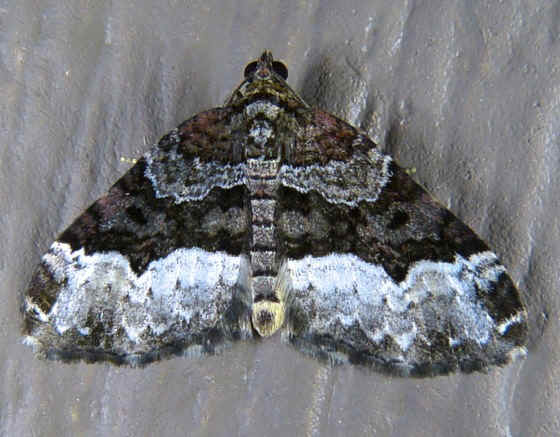
Sharp-angled Carpet
(photo by Marcie O'Connor)
- Wormwood Pug ______ M#7586.1 (PNE:195)
Eupithecia absinthiata
- Columbia Pug ______ M#7459
MD (PNE:195)
Eupithecia columbiata
- Juniper Pug ______ M#7551
(PNE:195)
Eupithecia interruptofasciata
- Common Pug ______ M#7474
MD NJ PA
(NW:78) (PNE:195) (W:211)
Eupithecia miserulata
Another name for Eupithecia
miserulata is Common Eupithecia.
- Cloaked Pug ______ M#7575
(PNE:195)
Eupithecia mutata
- Tawny Pug ______ M#7605
(NW:78)
(PNE:197) (another name is Great Variegated Pug)
Eupithecia ravocostaliata
Caterpillar food:
often willows, also poplars, cherries, viburnums
- White-spotted Pug ______
M#7488 (PNE:195)
Eupithecia tripunctaria
- Confused Eusarca ______ M#6941
NJ PA
(PNE:241) (W:189)
Eusarca confusaria
- Black-banded Carpet ______ M#7210
(PM:47) (PNE:183)
Eustroma semiatrata
The Black-banded Carpet occurs from Labrador to the Catskill
Mountains in New York, and west across Canada. Adults fly Jul-Aug.
- Curved-toothed Geometer ______ M#6966
NC NJ PA (NW:60)
(PNE:243)
(W:191)
Eutrapela
clemataria
The caterpillar of Eutrapela
clemataria is called the Purplish-brown Looper.
- Fine-lined Gray Moth ______
MD (PM:50)
Exelis pyrolaria
The Fine-lined Gray Moth occurs from New York to central Florida, and west to
Illinois & Louisiana. It is locally common. Adults fly mar-Aug. Favored
foods are Persimmon and Common Pipsisewa.
- Dotted Gray Moth ______ M#6449
MD NC NJ PA
(PM:52) (PNE:217) (W:151) In NC: low mountains
Glena cribrataria
The Dotted Gray Moth occurs uncommonly from southern Ontario to southern
Virginia, and wet Wisconsin & Texas. Adults fly Apr-May.
- Blueberry Gray Moth ______ (PM:54)
Glena cognataria
The Blueberry Gray Moth occurs from coastal Nova Scotia to Florida, and west to
Louisiana, in bogs and blueberry barrens. It is uncommon northward. Adults
fly May-Aug, with probably 2 broods.
- Dainty Gray Moth ______ MD
(W:195)
Glena plumosaria
- Texas Gray Moth ______ M#6443
MD NJ PA (PM:52)
Glenoides texanaria
The Texas Gray Moth occurs commonly from New Jersey to Florida, and west to
Missouri and Texas. Adults fly Jun-Oct.
- Chickweed Geometer (ph) ______
M#7146 MD NJ
PA (PNE:201) (W:205)
Haematopis grataria
The Chickweed Geometer occurs
from southern Ontario to northern Florida, and west to Manitoba & Texas.
It is abundant in most of its range, and often flies in fields during the
day-time. Adults fly Apr-Nov.
Caterpillar food: chickweeds, clovers, smartweeds, and many others
Further west, in the Ohio River Valley & the upper Mississippi River
Valley, in the "annettearia"
form of Haematopis grataria, the
wings are entirely pink.
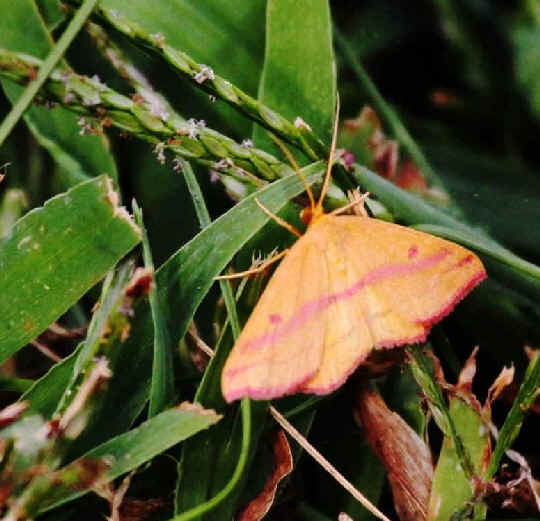
Chickweed Geometer
(photo by Marie Gardner)
- Common Spring Moth ______ M#6261
MD PA
(PM:49) (PNE:209) (W:195)
Heliomata cycladata
The Common Spring Moth occurs commonly from Quebec and Maine to North
Carolina, and wet to Wisconsin & Arkansas. It is a day-flier, but also
comes to lights after dark. Adults fly Apr-Jun, Jul northward.
- Rare Spring Moth ______ MD
(PM:49)
Heliomata infulata
The Rare Spring Moth occurs rarely from Long Island, New York to North
Carolina, and west to western Pennsylvania. Adults fly May-Jul. It is a
day-flier.
- Sulphur Wave ______ M#6431
MD
(PM:51) (PNE:217) (also called Sulphur Moth)
Hesperumia sulphuraria
The Sulphur Wave occurs from Nova Scotia to western Virginia, and west
across Canada and south to Missouri. It is locally common. Adults fly
Jun-Aug.
- Three-patched Bigwing ______ M#7645
MD (PNE:197)
Heterophleps refusaria
- Three-spotted Fillip Moth (ph)
______ M#7647 MD
PA (PNE:199)
Heterophleps triguttaria

Three-spotted Fillip Moth
- Pistachio Emerald ______ M#7084
MD PA (PNE:207) (W:201)
Hethemia pistasciaria
- Pale Homochlodes ______
M#6812 MD (PNE:231)
Homochlodes fritillaria
- Brown Bark Carpet Moth ______ M#7445
MA NJ PA
(NW:77) (PNE:193) (W:215)
Horisme intestinata
Caterpillar food: Virgin's Bower,
and possibly other Clematis species
- Fragile White Carpet Moth (ph) ______
M#7423
PA (PNE:191)
Hydrelia albifera
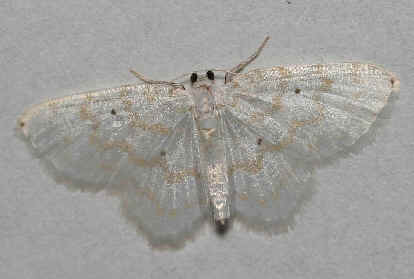
Fragile White Carpet Moth
(photo by Stephen Kloiber)
- Unadorned Carpet Moth ______ M#7422
NC PA
(PNE:191) (W:215) In NC: low mountains
Hydrelia inornata
- Black-dashed Hydriomena ______
M#7235 (PNE:185)
Hydriomena divisaria
- Renounced Hydriomena ______
M#7236 (PNE:185)
Hydriomena renunciata
- Transfigured Hydriomena ______ M#7237
NJ
(PNE:185) (W:207)
Hydriomena
transfigurata
- Esther Moth ______ M#6655
NJ PA
(W:163)
Hypagyrtis esther
- Pine Measuringworm Moth ______
M#6656 (PNE:223)
Hypagyrtis piniata
- One-spotted Variant Moth ______
M#6654 NJ PA
(PNE:223) (W:164)
Hypagyrtis unipunctata
- Umber Moth ______ M#6583
MD NJ PA (PM:52)
Hypomecis umbrosaria
The Umber Moth occurs commonly from Maine to Florida, and west to Wisconsin
and eastern Texas. Adults fly Apr-Aug.
- Idaea bonifata
______ M#7102 PA
- Red-bordered Wave ______
M#7114 MD NJ
Idaea demissaria
- Single-dotted Wave ______ M#7126
NJ
Idaea dimidiata
- Straw Wave ______ M#7115
MD NJ (W:205)
Idaea eremiata
- Diminutive Wave Moth ______ M#7105
MD PA
Idaea scintillularia
- Black-dotted Ruddy Moth ______ M#6711
NJ (PNE:225)
Ilecta intractata
- Brown-shaded Gray Moth ______ M#6586
MD NJ PA (PM:52)
Iridopsis defectaria (formerly Anacamptodes defectaria)
The Brown-shaded Gray Moth occurs commonly from New Jersey to
Florida, and west to Kansas & Texas. It may be abundant southward.
Adults fly Feb-Nov.
- Pale-winged Gray Moth (ph) ______
M#6583 MD NJ PA (PNE:217)
Iridopsis ephyraria
(formerly
Anacamptodes ephyraria)
The Pale-winged Gray Moth is common throughout eastern
North America. Adults fly Jun-Sep.
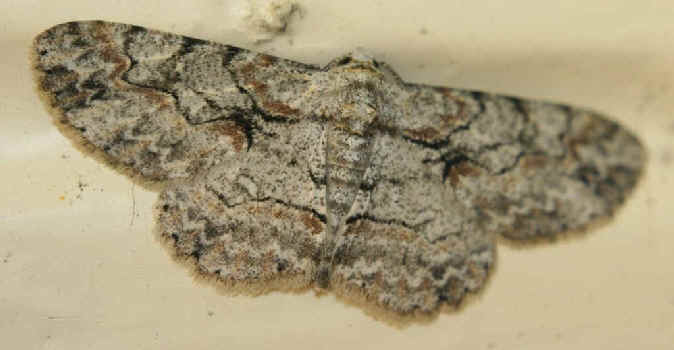
Pale-winged Gray Moth
(photo by Stephen Kloiber)
- Small Purplish Gray Moth ______
M#6584 MD
(PM:52)
(PNE:217) (W:152)
Iridopsis humaria (formerly
Anacamptodes humaria)
The Small Purplish Gray Moth is common
throughout eastern North America. Adults fly Apr-Sep.
- Bent-line Gray Moth ______ M#6588
MD NC NJ PA
(PNE:219) (W:153) In NC: low mountains
Iridopsis larvaria
- Black-shouldered Gray Moth ______
MD
(W:196)
Iridopsis
pergracilis
The caterpillar of Iridopsis
pergracilis is called the Cypress Looper.
- Large Purplish Gray Moth ______
M#6582 MD NJ
PA
(PM:52) (PNE:217) (W:154)
Iridopsis vellivolata
(formerly Anacamptodes vellivolata)
The Large Purplish Gray Moth occurs throughout eastern North America. It is locally common in coniferous
forests, especially in the south. Adults fly Apr-Aug.
- Mousy Itame ______
Itame argillacearia
The range of the Mousy Itame is the same as that of the Drab
Itame. Both species are common.
- Four-spotted Itame ______ (NW:33)
(PM:50)
Itame coortaria (or Macaria coortaria)
The Four-spotted Itame occurs uncommonly from Maine & Ontario to
Florida, and west to Manitoba and Texas. Adults fly May-Aug.
- Drab Itame ______
(PM:51)
Itame evagaria
The Drab Itame occurs commonly from Quebec and Maine to
Pennsylvania west to Missouri. Adults fly Jun to early-Aug.
- Lesser Maple Spanworm Moth
______ (PM:48) (W:146)
Itame pustularia
The Lesser Maple Spanworm Moth occurs from Newfoundland to Florida, and west
to Manitoba, Nebraska, Mississippi. It may be locally abundant. Adults fly
May-Jul.
- Currant Spanworm Moth ______ (NW:31)
(PM:51)
(W:147)
Itame ribearia (or Macaria ribearia)
The Currant Spanworm occurs uncommonly from Quebec and Maine to New
Jersey, and west to Missouri. Adults fly May-Jul.
Caterpillar food: currants and gooseberries
- Barred Itame ______ (NW:32)
(PM:50)
Itame subcessaria (or Macaria subcessaria)
The Barred Itame occurs uncommonly from Newfoundland to Kentucky, and west
to South Dakota. Adults fly in Jul.
Caterpillar food: currants and gooseberries
- Sulphur Itame (or Sulphur
Angle) ______
(NW:33) (W:196)
Itame
sulphurea (or
Macaria sulphurea)
The caterpillar of Itame
sulphurea is called the Green Spanworm.
- Southern Itame ______
(PM:52)
Itame varadaria
The Southern Itame from coastal South Carolina to southern Florida, and west
along the Gulf Coast to Texas. It is locally common. Adults fly all-months
southward, and with spring & summer broods in South
Carolina.
- Spring Hemlock Looper Moth
______ NC In NC: in
mountains in ridgetop hardwoods and mesic stands of riparian or cove
forest.
Lambdina athasaria
Lambdina athasaria has been a
subspecies of Lambdina fervidaria (below).
Caterpillar food:
hemlock, spruce, fir
- Lambdina
canitiaria ______ M#6893
NC if a valid species,
seemingly rare in NC
Lambdina canitiaria is similar to Lambdina
athasaria (above), but it is smaller and with no
yellow on the head and much less on the thorax and abdomen.
All NC records of Lambdina canitiara
in NC have been in mesic montane forests at relatively low
elevations.
- Curve-lined Looper Moth ______ M#6894
MD NC
PA (NW:54) (PNE:241) (W:186)
In NC: in Piedmont upland dry hardwood forest
Lambdina fervidaria
Caterpillar food: maples, oaks, birches,
American Hornbeam, Hop-hornbeam
- Hemlock Looper Moth ______
M#6888 MD NC (NW:53) (PNE:241)
In NC: mountains
Lambdina fiscellaria
Caterpillar food:
conifers, sometimes defoliating northern forests.
- Yellow-headed Looper Moth ______
M#6892 MD NC NJ In
NC: coastal plain
Lambdina pellucidaria
Caterpillar food:
pines
- Light-ribboned Wave ______ M#7180 (PNE:203)
Leptostales ferruminaria
- Scarce Infant ______ M#6257 (PNE:207)
Leucobrephos brephoides
- Drab Brown Wave ______ M#7094
MD NJ
Lobocleta ossularia
- Powdered Bigwing ______ M#7640
MD PA
(PNE:197) (W:213) (caterpillar called Two-lined Asper
Looper)
Lobophora
nivigerata
- Gray Spring Moth ______ M#6668
NJ (PNE:225)
Lomographa glomerana
- Bluish Spring Moth (ph) ______
M#6666 PA (PNE:225)
Lomographa semiclarata
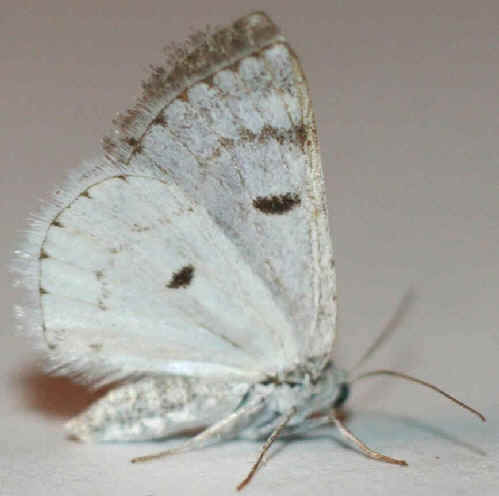
Bluish Spring Moth
(photo by Stephen Kloiber)
- White Spring Moth ______ M#6667
NC PA (PNE:225) (W:169)
In NC: low mountains
Lomographa vestaliata
- Stout Spanworm Moth ______ M#6651
(NW:36) (PNE:221)
Lycia ursaria
- Woolly Gray ______ M#6652
NJ
(W:162)
Lycia ypsilon
- Lytrosis heitzmanorum
______ M#6722
NC
In NC: western Piedmont
Lytrosis heitzmanorum is one of
three very similar species which have been confused. It is found in
oak-hickory forest.
It is said to have a short flight period, so without a new moon during that
flight period, it could easily be missed.
Lytrosis heitzmanorum is said to
come to light.
- Common Lytrosis (ph) ______ M#6720
NJ PA (NW:41)
(PNE:227)
(W:171)
Lytrosis unitaria
Caterpillar food: often Sugar Maple and
hawthorns
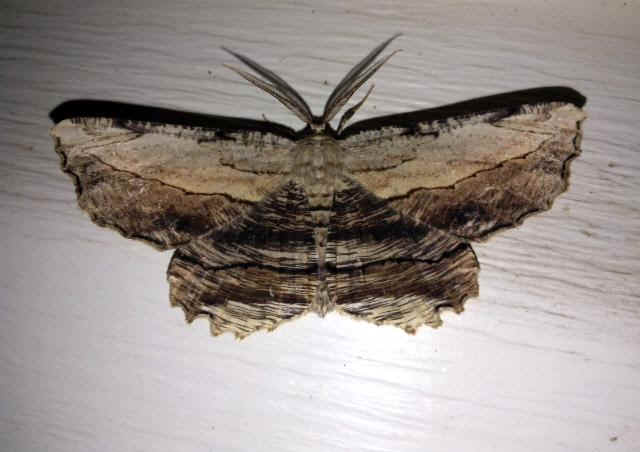
A Common Lytrosis in North Carolina in June 2015
(photo by Amanda Hendricks)
The following now in
the genus MACARIA were in SEMIOTHISA.
- Common Angle Moth ______ M#6326
MA MD NC NJ PA (NW:33)
(PNE:211)
Macaria aemulataria
The Common Angle Moth occurs commonly from Nova Scotia to
Florida, and west to South Dakota and Texas. Adults fly Apr-Sep.
- Woody Angle Moth ______ MD
(PM:49)
Macaria aequiferaria
The Woody Angle Moth occurs from New Hampshire to Florida, and west to
Wisconsin and Texas. It is common southward and rare in the north. Adults
fly Apr-Oct.
- Bicolored Angle Moth ______ M#6341
MD NJ (PNE:213)
Macaria bicolorata
The Bicolored Angle Moth occurs commonly from New York to
Florida. Adults fly May-Aug.
- Red-headed Inchworm Moth ______
M#6342 MD NJ PA (NW:33)
(PM:50)
(PNE:213)
Macaria bisignata
The Red-headed Inchworm Moth occurs from Newfoundland to
North Carolina, and west to Minnesota & Missouri. It is locally common.
Adults fly May-Aug, with 2 broods.
- Southern Chocolate Angle Moth ______
(PM:50)
Macaria distribuaria
The Southern Chocolate Angle Moth occurs commonly from coastal North
Carolina to Florida, and west to eastern Texas. Adults fly
all-year.
- Three-lined Angle Moth ______
(PM:50)
Macaria eremiata
The Three-lined Angle Moth occurs from New Hampshire to Florida, and west to
South Dakota & Mississippi. It is uncommon to rare. Adults fly May-Sep.
- Hemlock Angle Moth ______ M#6348
MD (PM:50)
(PNE:215)
Macaria fissinotata
The Hemlock Angle Moth occurs from Nova Scotia to the Georgia
mountains, and west to Ontario & Kentucky It is locally common. Adults
fly May-Sep, with 2 broods..
- Hollow-spotted Angle Moth ______ M#6405
PA (PM:50)
Macaria gnophosaria (or Digrammia gnophosaria)
The Hollow-spotted Angle Moth occurs from Ontario to Florida, and west to
Wisconsin & Texas. It is common to abundant, southward. Adults fly
Apr-Sep.
- Granite Angle Moth ______ M#6352
MD NC (PM:49)
In NC: low mountains
Macaria granitata
The Granite Angle Moth occurs commonly from southern Maine to South
Carolina, and west to Kentucky. Adults fly May-Sep, with 2
broods.
- Minor Angle Moth ______ M#6340
MD NJ PA (PM:51)
(PNE:213)
Macaria minorata
The Minor Angle Moth occurs commonly from Nova Scotia to
western North Carolina, and west to South Dakota. Adults fly May-Aug, with 2
broods.
- Many-lined Angle Moth (ph) ______
M#6353 MD PA (PM:51)
Macaria multilineata
The Many-lined Angle Moth occurs from Massachusetts to Florida, and west to
Arkansas. It is locally common. Adults fly Apr-Sep.
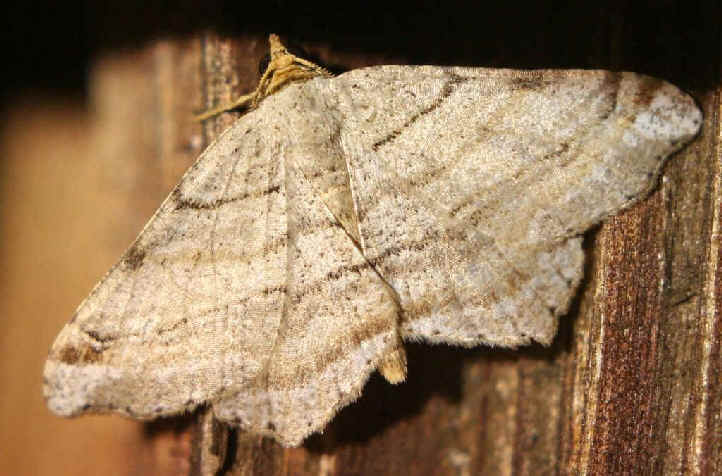
Many-lined Angle Moth
(photo by Stephen Kloiber)
- Birch Angle Moth ______ M#6330
MD NC NJ PA (PNE:213)
Macaria notata
- Owen's Angle Moth ______ M#6351
(NW:33) (PNE:215) (another name is Lesser Larch
Angle)
Macaria oweni
- White Pine Angle Moth ______ M#6347
MD PA
(W:148) (PM:50) (PNE:213)
Macaria pinistrobata
The White Pine Angle Moth occurs from
Nova Scotia to western North Carolina, and west to Ontario and Michigan.
It is common where White Pine trees are common. Adults fly late-May to
Aug.
- Promiscuous Angle Moth ______ M#6331
MD NJ PA (PM:49)
Macaria promiscuata
The Promiscuous Angle Moth occurs commonly from Maryland to Florida,
and west to Missouri and Texas. Adults fly Apr-Sep.
- Four-spotted Angle Moth ______
(PM:48)
Macaria quadrinotaria
The Four-spotted Angle Moth occurs from Ohio and Virginia to Florida, and west
to Kansas and Arkansas. it is locally common in deepwoods. Adults fly
Apr-Jul & Sep,
- Lesser Larch Angle Moth ______ M#6343
MD
PA
(PNE:213) (W:196)
Macaria
sexmaculata
Another name for Macaria
sexmaculata is the Six-spotted Angle Moth. The
caterpillar is called the Green Larch Looper.
- Pale-marked Angle Moth ______ M#6344
MD NJ (PM:50)
(PNE:213)
Macaria signaria
The Pale-marked Angle Moth occurs commonly from Labrador to
the North Carolina mountains, and west across Canada, south to South Dakota.
Adults fly May-Sep.
- Blurry Chocolate Angle Moth ______
M#6339 MD NJ
(PM:51) (PNE:213)
Macaria transitaria
The Blurry Chocolate Angle Moth occurs from Nova Scotia to
South Carolina, and west to Wisconsin and Louisiana. It is locally common.
Adults fly May-Sep.
- Canadian Melanolophia ______
M#6620 MD NJ PA
(PNE:219) (W:159)
Melanolophia canadaria
- Signate Melanolophia
______ M#6621
MD PA (PNE:221)
Melanolophia signataria
- Orange Wing ______
M#6271.1 MD
(PM:49) (PNE:209)
Mellilla xanthometata
The Orange Wing occurs abundantly from New Jersey to South Carolina, and
west to Nebraska and Texas. It is active both day and night. Adults fly
Apr-Oct.
- White-ribboned Carpet Moth (ph) ______
M#7294 (NW:72) (PNE:187)
Mesoleuca ruficillata
Caterpillar food:
the leaves of birches, and blackberries and
raspberries
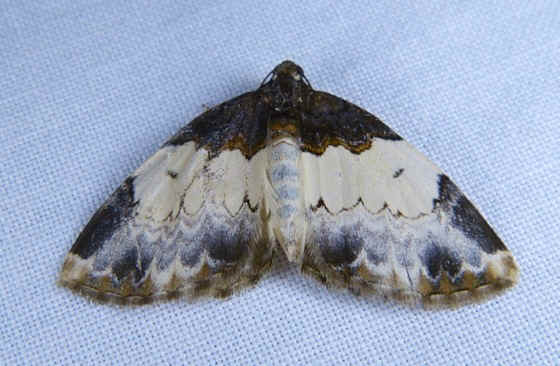
White-ribboned Carpet Moth
(photo by Marcie O'Connor)
- Dark Metanema ______
M#6820 MD (NW:47) (PNE:233)
Metanema determinata
Caterpillar food: often willows, also aspens and ash
- Pale Metanema ______
M#6819 MD PA (NW:47) (PNE:233) (W:180)
Metanema inatomaria
- Angled Metarranthis ______ M#6823
MD NJ (NW:48)
(PNE:235)
Metarranthis angularia
Another name for Metarranthis
angularia is Scalloped Metarranthis.
- Ruddy Metarranthis ______ M#6822
MD NJ (NW:48)
(PNE:233)
Metarranthis duaria
Caterpillar food: favors blueberries and cherries
- Purplish Metarranthis ______ M#6828
MD PA
Metarranthis homuraria
- Common Metarranthis ______ M#6826
MD NJ PA
(NW:48) (W:181)
Metarranthis
hypochraria
- Pale Metarranthis ______ M#6825
MD PA
Metarranthis indeclinata
- Yellow-washed Metarranthis
______ M#6832 (PNE:235)
Metarranthis obfirmaria
- Wartner's Metarranthis ______ M#6821 (PNE:233)
Metarranthis warneri
- Filament Bearer ______
M#7010 PA
(NW:62) (PNE:245) (W:194)
Nematocampa resistaria
Nematocampa resistaria
is also called the Horned Spanworm
Moth.
- White-barred Emerald ______ (W:201)
Nemoria bibilata
- Red-fringed Emerald (ph) ______
M#7046 MD NJ PA (PNE:205)
(W:199)
Nemoria bistriaria
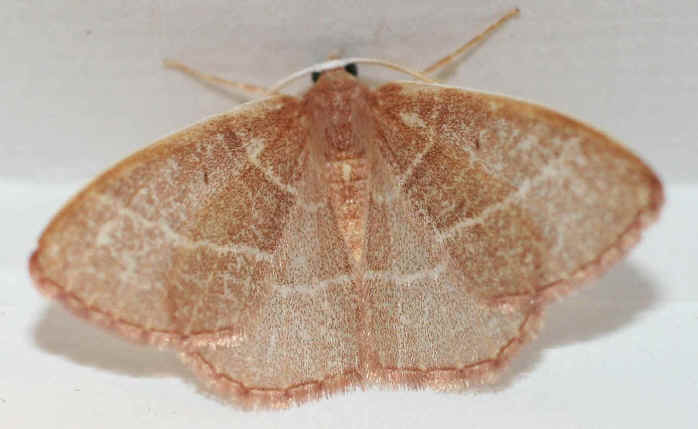
A Red-fringed Emerald, as in the spring broods
(photo by Stephen Kloiber)
- Cypress Emerald ______ MD
(W:201)
Nemoria elfa
- Red-bordered Emerald (ph)
______
M#7033 MD NJ
(PNE:203) (W:201)
Nemoria lixaria
Another name for Nemoria
lixaria is the Ocellate Emerald.
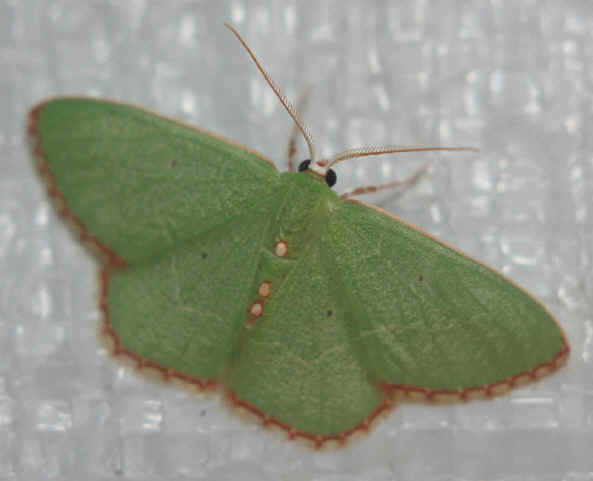
Red-bordered Emerald
(photo by Stephen Kloiber)
- White-fringed Emerald (ph) ______
M#7048 MD (PNE:205)
Nemoria mimosaria
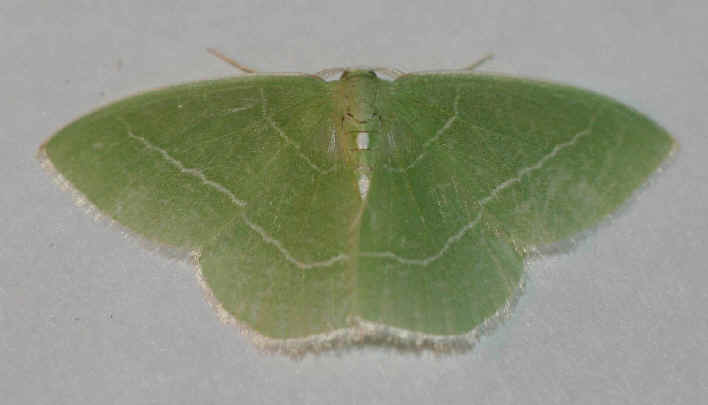
White-fringed Emerald
(photo by Stephen Kloiber)
- Red-fronted Emerald ______ M#7047
MD
(NW:64) (PNE:205)
Nemoria rubrifrontaria
Caterpillar food:
Sweet Fern, Sweet Gale, New Jersey Tea, sumacs
- False Hemlock Looper Moth (ph) ______
M#6906 MD PA
(NW:55) (PNE:241)
Nepytia canosaria
Caterpillar food:
various conifers
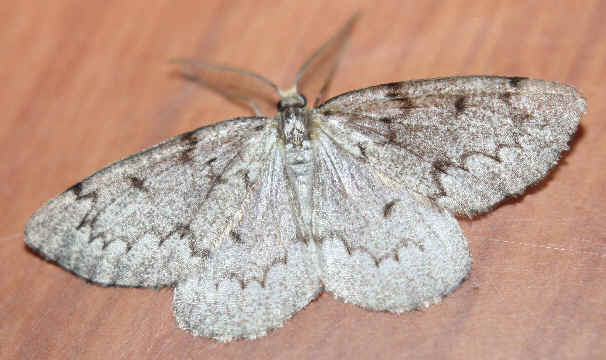
False Hemlock Looper Moth
(photo by Stephen Kloiber)
- Festive Pine Looper ______ (W:188)
Nepytia pellucidaria
- The Bruce Spanworm ______
M#7437 PA
(PNE:193) (W:210)
Operophtera bruceata
- Yellow-veined Geometer ______ M#6430 (PNE:215)
Orthofidonia flavivenata
- Bent-line Carpet ______ (PM:50)
Orthonama centrostrigaria
The Bent-line Carpet is common throughout eastern North America.
Adults fly Mar-Oct.
- The Gem ______ M#7414
NJ PA (PM:49)
(PNE:191)
Orthonama obstipata
The Gem occurs worldwide. It is very common. It dies out in colder areas
each year, but repopulates rapidly the following spring. Adults fly Apr-Oct,
with several broods.
- White-spotted Cankerworm Moth
______ M#6663 PA
Paleacrita merriccata
- Spring Cankerworm ______ M#6662
NJ PA
(PNE:223) (W:167)
Paleacrita vernata
- Green Pug (ph) ______ M#7625
MD NJ PA (PNE:197)
Pasiphila rectangulata

Green Pug
(photo by Stephen Kloiber)
- Juniper-twig Geometer Moth ______
M#6974 NJ PA
(PNE:243) (W:192)
Patalene olyzonaria
- Small Rivulet ______ M#7320 (PNE:187)
Perizoma alchemillata
- Hubner's Pero ______ M#6748
MD PA (W:174)
Pero ancetaria (or
hubneraria)
- Honest Pero ______ M#6753
MD PA (NW:43)
(PNE:229)
Pero honestaria
- Morrison's Pero ______ M#6755
MD NC NJ (PNE:229)
In NC: low mountains
Pero morrisonaria
- Northern Petrophora ______ M#6804
MD (PNE:231)
Petrophora subaequaria
- Oak Beauty Moth ______ M#6763
MD NC PA (PNE:229) (W:175)
In NC: low mountains
Phaeoura quernaria
- Toothed Phigalia ______
M#6659 NJ (PNE:223)
Phigalia denticulta
- Small Phigalia ______ M#6660
PA (NW:37) (PNE:223) (W:165)
Phigalia strigataria
- The Half-Wing ______ M#6658
PA
(NW:38) (PNE:223) (W:166)
Phigalia titea
The caterpillar of
Phigalia titea is called the Spiny Looper.
- Hollow-spotted Plagodis ______ M#6844
MD NC NJ PA
(NW:50) (PNE:239) (W:183) In NC: low mountains
Plagodis alcoolaria
- Fervid Plagodis ______ M#6843
MD NJ PA (NW:50)
(PNE:237)
Plagodis fervidaria
- Purple Plagodis ______
M#6841 MD (NW:50) (PNE:237)
Plagodis kuetzingi
- Straight-lined Plagodis ______
M#6842 MD NJ PA (NW:50)
(PNE:237)
Plagodis phlogosaria
- American Barred Umber Moth ______
M#6836 MD NJ (PNE:235)
Plagodis pulveraria
- Lemon Plagodis ______
M#6840 MD NC (PNE:237)
In NC: low mountains
Plagodis serinaria
- George's Carpet ______ M#7216 (PNE:183)
Plemyria georgii
- Common Tan Wave Moth ______ M#7132
MD NJ PA
(W:203)
Pleuroprucha
insulsaria
- Alien Probole ______ M#6837
PA
(PNE:237) (W:182)
Probole alienaria
- Friendly Probole ______ M#6838
NC (PNE:237)
In NC: low mountains
Probole amicaria
- Large Maple Spanworm Moth (ph)
______ M#6982 NJ
PA (NA:14,539) (NW:61) (PNE:243) (S:202) (W:193)
Prochoerodes lineola (or
Prochoerodes transversata)
Caterpillar food: maples, oaks, aspens, birches, fir, Northern White
Cedar
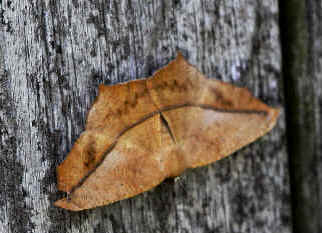
Large Maple Spanworm Moth
(photo by Marie Gardner)
- Virgin Moth ______ MD
PA (PM:48) (W:145)
Protitame virginalis
The Virgin Moth occurs from Nova Scotia to Virginia, and west to Manitoba
and Louisiana. It is locally common. Adults fly late-Apr to Aug.
- Porcelain Gray Moth ______ M#6598
MA MD NJ PA
(PNE:219) (W:157)
Protoboarmia porcelaria
The caterpillar of Protoboarmia porcelaria
is called the Dash-lined Looper.
- Spear-marked Black Moth ______ M#7293
(PNE:187)
Rheumaptera hastata
- Cherry Scallop Shell Moth ______
M#7292 MA PA
(NW:71) (PNE:187) (W:209)
Rheumaptera prunivorata (or Hydria prunivorata)
Caterpillar food: cherries, especially Black Cherry
- Spear-marked Black Moth ______ (NW:70)
Rheumaptera hastata
The Spear-marked Black Moth and the White-banded Black Moth
(below) are confusingly similar and only identifiable by internal anatomy.
Caterpillar food of Rheumaptera hastata:
alders, birches; also blueberries, Sweetfern, Sweetgale.
Caterpillars of this and the following species feed inside webbed leaf
shelters.
- Ferguson's Scallop Shell Moth
______ M#7292
NC In NC: low mountains
Rheumaptera prunivorata
- White-banded Black Moth ______ M#7294 (PNE:187)
Rheumaptera subhastata
- Frosted Tan Wave ______ M#7157
MD (PNE:201)
Scopula cacuminaria
- Frigid Wave ______
M#7166
(PNE:203)
Scopula frigidaria
- Soft-lined Wave Moth ______ M#7169
MD PA (PNE:203)
Scopula inductata
- Simple Wave ______ M#7164
MD
(PNE:203)
Scopula junctaria
- Large Lace Border Moth (ph) ______
M#7159 MD NC NJ PA
(NW:67)
(PNE:201)
(W:204) In NC: low mountains
Scopula limboundata
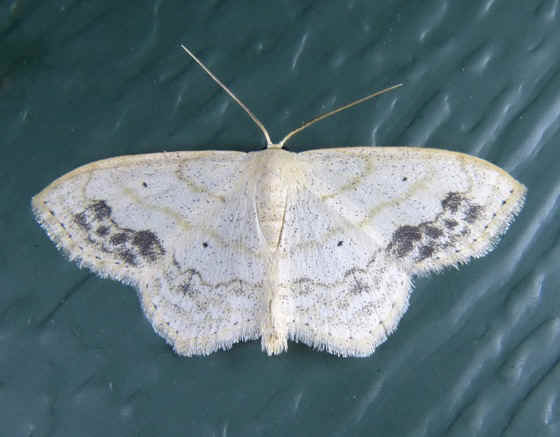
Large Lace Border Moth
(photo by Marcie O'Connor)
- Four-lined Wave ______ M#7165 (PNE:203)
Scopula quadrilineata
- Northern Thorn Moth ______
M#6817 (NW:46) (PNE:233)
Selenia alciphearia
Another name for Selenia alciphearia
is Northern Selenia.
Caterpillar food:
willows and other broad-leaved woody plants
- Kent's Geometer ______ M#6818
MD PA
(PNE:233) (W:179)
Selenia kentaria
- Sharp-lined Yellow Moth ______ M#6912
MD
(NW:56) (PNE:241)
Sicya macularia
Caterpillar food:
many plants, but often aspens, willows, alders
- Double-banded Carpet ______ M#7312
(NW:73) (PNE:187)
Spargania magnoliata
- Split-lined Granite ______ M#6304 (PNE:211)
Speranza bitactata
- Rannoch Looper ______ M#6286 (PNE:211)
Speranza brunneata
- Four-spotted Granite ______ M#6299 (PNE:211)
Speranza coortaria
- Speckled Granite ______
M#6292 (PNE:211)
Speranza exauspicata
- Lesser Maple Spanworm Moth
______ M#6273
MD PA (NW:33) (PNE:209)
Speranza pustularia (formerly Macaria pustularia)
- Currant Spanworm ______ M#6274
MD (PNE:209)
Speranza ribearia
- Barred Granite ______ M#6303
MD (PNE:211)
Speranza subcessaria
- Sulphur Granite ______ M#6283 (PNE:211)
Speranza sulphurea
- Shiny Gray Carpet ______ M#7333 (PNE:189)
Stamnodes gibbicostata
- Wavy-lined Emerald (ph) ______
M#7058 MD NJ PA
(NW:65) (PNE:205) (W:200)
(caterpillar called the Camoflaged Looper)
Synchlora aerata
The caterpillar of Synchlora aerata
is called the Camouflaged Looper.
Caterpillar food:
often flowers of aster family plants
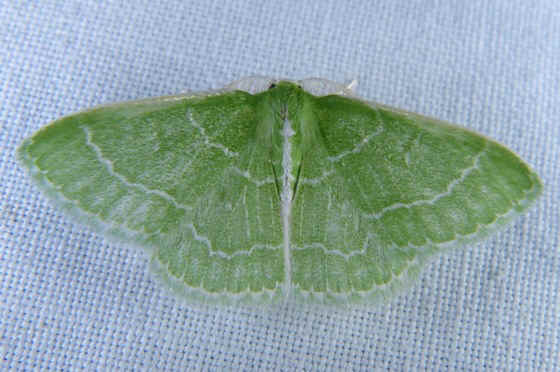
Wavy-lined Emerald
(photo by Marcie O'Connor)
- Southern Emerald ______
M#7059 MD (PNE:205)
Synchllora frondaria
- Northern Pale Alder Moth ______
M#6806 (PNE:231)
Tacparia atropunctata
- Pale Alder Moth ______ M#6807
MD (PNE:231)
Tacparia detersata
- White Slant-line Moth ______
M#6964 NC PA
(PNE:243) (W:190) In NC: low mountains
Tetracis cachexiata
- Yellow Slant-line Moth ______ M#6963
NC PA (NW:57)
(PNE:241) In NC: low mountains
Tetracis crocallata
Caterpillar food: willows, alders, sumacs, Red
Elderberry
- Early Juniper Carpet ______ M#7218
(PNE:185)
(W:215)
Thera contractata
The caterpillar of Thera contractata
is called the Contracted Spanworm.
- Juniper Carpet _____ M#7217 (PNE:183)
Thera juniperata
- Black-dotted Ruddy ______
(W:196)
Thysanopyga intracrata
The caterpillar of Thysanopyga intracrata
is called the Holly Looper.
- Cross-lined Wave ______
M#7147 MD
(PNE:201) (W:205)
Timandra amaturaris
- Dimorphic Gray Moth ______ MD
(PM:50)
Tornos scalopacinarius
The Dimorphic Gray Moth occurs commonly from southern Connecticut to southern
Florida, and west to Wisconsin & Texas. Adults fly Feb-Nov.
- White-striped Black Moth (ph) ______
M#7430 PA
(NW:75) (PNE:193) (W:215)
Trichodezia albovittata
The White-striped Black Moth occurs from Labrador to North Carolina, and
west to Manitoba & Missouri. It is a common day-flier in woodlands.
Adults fly Apr-Sep, with 2 broods.
Caterpillar food: touch-me-nots, willow herbs, meadow-rues
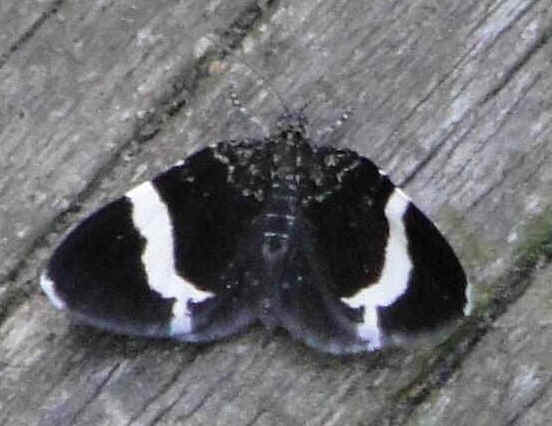
A White-striped Black Moth
(photo by Harry McGarrity)
- Tissue Moth ______ M#7285
PA
(PNE:185) (W:215)
Triphosa haesitata
- The Welsh Wave ______
M#7425 (PNE:191)
Venusia cambrica
- Brown-shaded Carpet ______
M#7428 (PNE:193)
Venusia comptaria
- Red Twin-Spot (ph) ______
M#7388
(NW:73) (PNE:189)
Xanthorhoe ferrugata
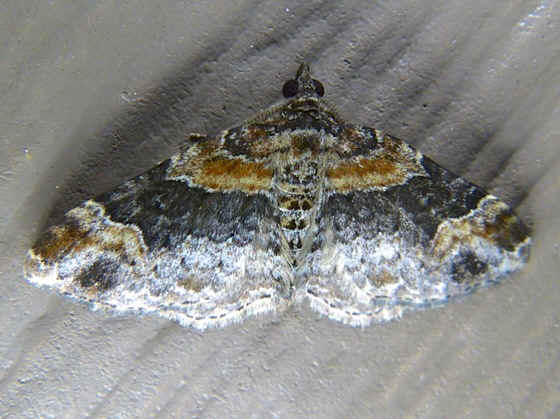
Red Twin-Spot
(photo by Marcie O'Connor)
- Labrador Carpet ______
M#7368 (PNE:189)
Xanthorhoe labradorensis
- Toothed Brown Carpet ______ M#7390
NJ PA (NW:73)
(PNE:189)
Xanthorhoe lacustrata
- Crocus Geometer ______ M#6743
MD PA
(NW:42) (PNE:229) (W:173)
Xanthotype sospeta
Xanthotype sospeta
is said to be a paler yellow and less marked with brown than Xanthotype
urticaria. But the species can only be differentiated with
certainty by internal reproductive anatomy.
- False Crocus Geometer ______ M#6740
MD PA (NW:42) (PNE:229)
Xanthotype urticaria
Caterpillar food: many broad-leaved plants,
including Poison Ivy
Family NOTODONTIDAE: Prominents
The Prominents are common,
medium-sized moths, from 1 to 2 and 3/8ths inches long (25-60mm), with
varying shades of brown, gray, olive-green, or yellowish tan. They are often
spotted or streaked with black. In some species, the fore-wings have a
tooth-like projection at the middle of the inner margin, which shows
prominently when the wings are folded roof-like over the body at rest.
Many members if this family somewhat resemble NOCTUIDS but can be
distinguished by the venation of the forewings.
The caterpillars are mottled or striped and many have lumpy tubercles on
their backs. They feed on the foliage of many kinds of trees and shrubs.
Most feed singly. A few do so in large groups. Some of the caterpillars are
serious orchard and forest pests. If disturbed, the caterpillars often
"freeze", raising the front and rear of the body and holding on to
their support by 4 pairs of prolegs.
- Double-toothed Prominent ______
M#7929
NC NJ PA
(NW:127) (PNE:273) (S:248) (W:289)
Nerice bidentata
Caterpillar food:
elms
- Plain Schizura ______ NC
NJ PA
Schizura apicalis
- Chestnut Schizura ______ M#8006
NC
NJ PA
(NW:139) (PNE:283) (W:310)
Schizura badia
Caterpillar food: viburnums
- Red-humped Appleworm Moth ______
M#8010 NJ
PA (NA:8) (PNE:285) (W:311)
Schizura concinna
Caterpillars of Schizura
concinna feed on the foliage of apple, cherry, pear, rose,
blackberry, and other members of the rose family, as well as many other
trees.
They spin loose silken cocoons on the ground among litter, and overwinter
and pupate in the late spring. There is one generation a year.
- Morning Glory Prominent
______ M#8005 NC NJ PA (PNE:283)
(S:249)
(W:316)
Schizura ipomoeae
Another name for Schizura
ipomoeae is Checker-fringed Prominent.
- Black-blotched Schizura ______ M#8011
NC
NJ PA
(PNE:285) (W:312)
Schizura leptinoides
- Unicorn Caterpillar Moth ______
M#8007 NC NJ PA (NW:138)
PNE:283)
(W:313)
Schizura unicornis
- Black-etched Prominent ______ M#7942
NC
NJ (NA:29) (NW:132) (PNE:277) (W:282) ("Puss Moth")
Cenura scitscripta
The plump caterpillar of Cenura
scitscripta can retract its head so far into its body that it
seems to disappear.
When disturbed, it extends whiplike filaments from each of the two fleshy
horn-like projections at the tip of the abdomen and waves them. It can eject
an irritating fluid from glands on the thorax.
The caterpillar pupates in a tough, brown silken cocoon mixed with woodchips
in a cavity in rotten wood or bark.
Caterpillar food: aspen and willow, also cherry
- Sigmoid Prominent ______
M#7895 NJ
PA
(NW:115) (PNE:271) (S:250) (W:280)
Clostera albosigma
Caterpillar food:
aspens & willows, also alders, birches, maples,
elms
- Apical Prominent ______ M#7901
PA
(PNE:271) (W:319) (also called Toothed
Clostera)
Clostera apicalis
- Angle-lined Prominent ______ M#7896
NC
NJ PA (PNE:271) (W:281) (the caterpillar called the Poplar
Tentmaker)
Clostera inclusa
- Striped Chocolate Tip ______ M#7898
NJ
(PNE:271)
Clostera strigosa
- Black-spotted Prominent ______ M#7957
NC PA
(NW:134) (W:315)
Dasylophia anguina
Caterpillar food: many legumes such as clovers and bush
clovers
- Gray-patched Prominent ______ M#7958
NC (PNE:287) (W:316)
Dasylophia thyatiroides
- Angus' Datana Moth (ph) ______
M#7903
NC NJ PA (PNE:277) (W:297)
Datana angusii
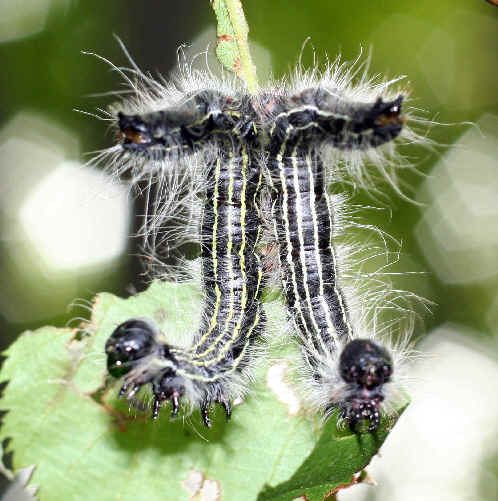
Above & below: Datana angusii
Above: 2 caterpillars, below: the moth
(photos by Stephen Kloiber)

- Contracted Datana ______ M#7906
PA
(PNE:277) (W:294)
Datana contracta
- Drexel's Datana ______ M#7904
PA
(PNE:277) (W:297)
Datana drexelii
- Yellow-necked Caterpillar Moth
______ M#7902 NJ
PA (NW:120) (PNE:277) (S:250)
Datana ministra
- Walnut Caterpillar Moth (ph) ______
M#7907
NC
PA
(PNE:277) (W:295)
Datana integerrima
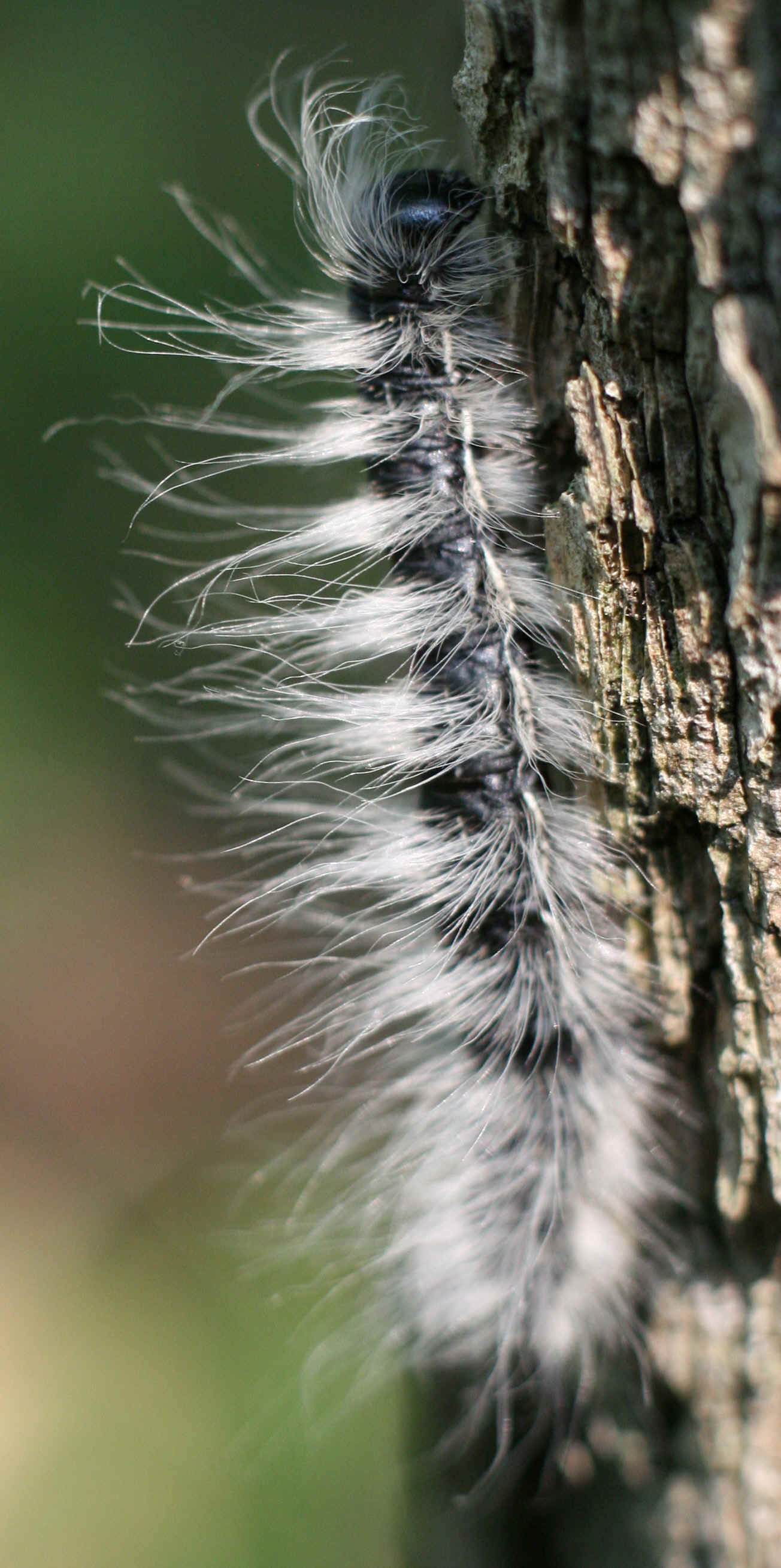
The caterpillar of the
Walnut Caterpillar Moth
(photo by Stephen Kloiber)
- Major Datana ______
(W:298)
Datana major
- Yellow-necked Caterpillar
______ PA (W:296)
Datana ministra
- Spotted Datana ______
M#7908 NC
PA (PNE:279) (W:297)
Datana perspicua
- Post-burn Datana ______
(W:297)
Datana ranaeceps
- Silvered Prominent
______ (W:319)
Didugua argentilinea
- Linden Prominent ______ M#7930
NC
NJ PA
(NW:128) (PNE:279) (W:285)
Ellida caniplaga
Caterpillar food: basswood
- White Furcula ______ M#7936
NC
NJ PA (NW:130) (PNE:275) (W:283)
Furcula borealis
Caterpillar food: cherries
- Gray Furcula ______ M#7937
NC
PA (NW:131) (PNE:275) (W:284)
Furcula cinerea
- Modest Furcula ______ M#7941
NJ (NW:131) (PNE:275)
Furcula modesta
- Western Furcula ______ M#7939
NJ
PA (NW:131) (PNE:275) (W:319)
(also called Double-lined Furcula)
Furcula occidentalis
- Hourglass Furcula ______ PA
(W:319) (also called Zigzag
Furcula Moth)
Furcula scolopendrina
- Four-spotted Gluphisia ______ M#7933
NJ
(PNE:275)
Gluphisia avimacula
- Lintner's Gluphisia ______ M#7934
(PNE:275) (W:320)
Gluphisia lintneri
- Common Gluphisia ______ M#7931
NJ
PA
(NW:129) (PNE:273) (W:286)
Gluphisia
septentrionis
Caterpillar food: poplars
- Wavy-lined Heterocampa Moth ______
M#7995 NC
NJ PA (PNE:281) (W:299)
In NC: low mountains
Heterocampa biundata
- Saddled Prominent (ph) ______
M#7994 NC
NJ PA
(PNE:281) (W:300) (also called
Maple Prominent)
Heterocampa guttivitta
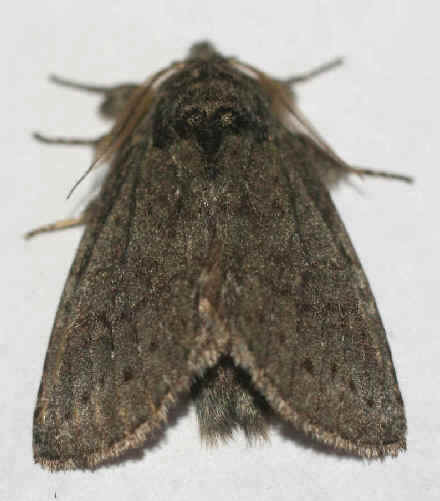
Saddled Prominent
(photo by Stephen Kloiber)
- Oblique Heterocampa Moth ______
M#7983 NC
NJ PA (NW:136) (PNE:281) (W:301)
Heterocampa oblqua
Caterpillar food: oaks
- Small Heterocampa Moth ______ M#7985
NJ PA
(PNE:281) (W:320)
Heterocampa subrotata
- White-blotched Heterocampa Moth (ph)
______ M#7990 NC NJ PA
(PNE:281) (W:302) In NC: low mountains
Heterocampa umbrata
The White-blotched Heterocampa Moth occurs
commonly from Nova Scotia to Florida, and west to Manitoba and Arkansas.
Adults fly Apr-Sep. It feeds in oaks.
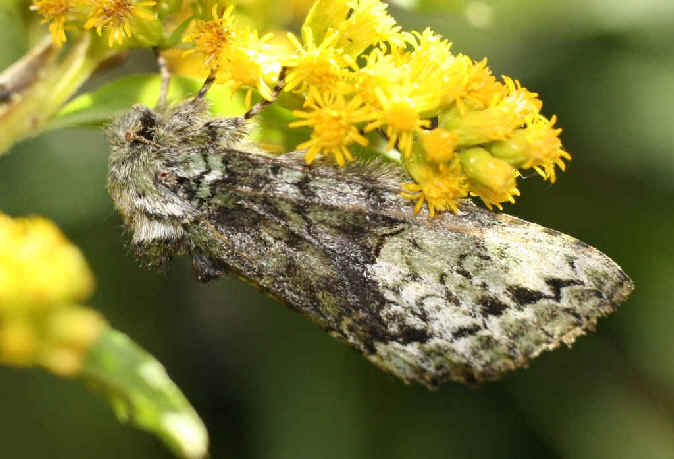
White-blotched Heterocampa Moth
(photo by Stephen Kloiber)
- Heterocampa varia
______ NJ
- Pink Prominent ______ M#8022
NC
NJ PA (PNE:285) (W:305)
Hyparpax aurora
- Georgian Prominent ______ M#7917
NC
NJ PA (PNE:271) (W:287)
Hyperaeschra georgica
- Double-lined Prominent ______ M#7999
NC NJ PA (NW:137) (PNE:283) (W:303)
Lochmaeus bilineata
Caterpillar food: elms and
Basswood
- Variable Oakleaf Caterpillar Moth
______ M#7998 NC NJ PA
(PNE:283) (W:304)
Lochmaeus manteo
The defensive spray of the Variable
Oakleaf Caterpillar Moth can blister human skin, as it ahs formic
acid contents of 20 to nearly 40 per cent by volume.
Lochmaeus manteo has caused
widespread defoliation of oak forests in the Midwest
US.
- Mottled Prominent ______ M#7975
NC
NJ PA (NW:135) (PNE:281) (W:306)
Macrurocampa marthesia
Caterpillar food: mostly oaks
- Drab Prominent ______ M#7974
NC
NJ PA
(PNE:279) (W:307)
Misogada unicolor
- White-dotted Prominent ______ M#7915
NC NJ PA (NW:121) (PNE:279) (W:288)
Nardata gibbosa
Caterpillar food: often oaks, also
birches, alders, willows
- Finned-Willow Prominent ______ M#7926
NJ
(PNE:273)
Notodonta scitipennis
- Northern Finned Prominent
______ M#7928 PA (NW:126)
(PNE:273)
(W:290)
Notodonta torva
(or simplaria)
Caterpillar food: poplars and willows
- Elegant Prominent ______ M#7924
NJ
PA (NW:125) (PNE:273) (W:291)
Odontosia elegans
Caterpillar food: poplars
- White-streaked Prominent ______
M#8017 NC NJ (NW:141)
(PNE:285)
(W:308) (or Lace-capped
Caterpillar)
Oligocentria
lignicolor
Caterpillar food: oaks and other
broad-leaved woody plants
- Red-washed Prominent ______ M#8012
NC
NJ
(NW:140) (PNE:285) (W:309)
Oligocentria
semirufescens
Caterpillar food: poplars and willows
- Angulose Prominent (ph) ______
M#7920 NC
NJ PA
(NW:122) (PNE:279) (W:292)
Peridea angulosa
The Angulose Prominent occurs from
Nova Scotia to Florida, and west to Manitoba & Texas. It is uncommon to
common. Adults fly May-Oct.
Caterpillar food: mostly oaks
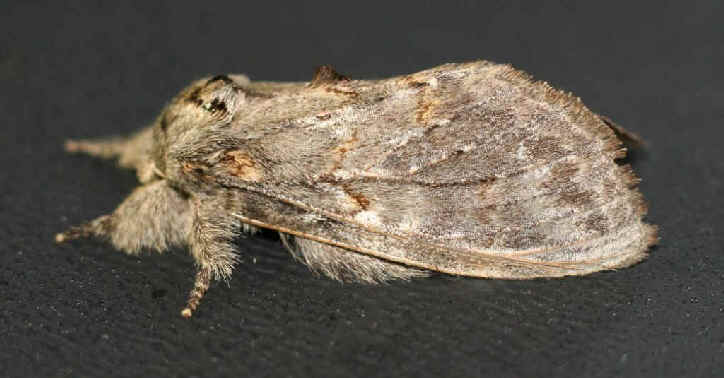
Angulose Prominent
(photo by Stephen Kloiber)
- Oval-based Prominent ______ M#7919
NC
NJ PA (PNE:279) (W:320)
Peridea basitriens
- Chocolate Prominent ______ M#7921
NC
NJ PA (NW:123) (PNE:279) (W:320)
Peridea ferruginea
Caterpillar food: mostly birches
- Black-rimmed Prominent (ph) ______
M#7922 NJ
PA (NW:124) (PNE:273) (W:293) (also called False Sphinx)
Pheosia rimosa
The Black-rimmed Prominent occurs
from Newfoundland to North Carolina, and west to Manitoba and Nebraska.
During some years, it is locally common. Adults fly Apr-Oct.
Caterpillar food: poplars, willows
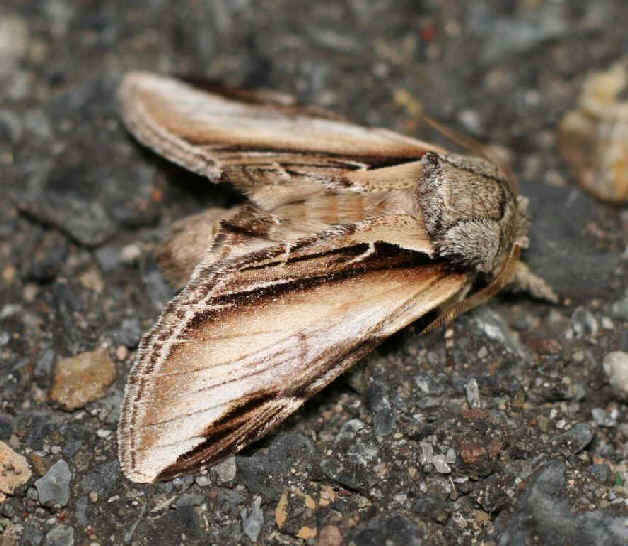
Black-rimmed Prominent
(photo by Stephen Kloiber)
- White-headed Prominent ______ M#7951
NC NJ
PA (PNE:287)
Symmerista albifrons
- Red-humped Oakworm Moth ______ M#7952
(NW:133)
(PNE:287)
(W:317)
Symmerista canicosta
Caterpillar food: oaks
- Orange-humped Mapleworm Moth ______
M#7953 PA
(PNE:287) (W:318)
Symmerista leucitys
Family LIMACODIDAE: Slug Caterpillar
Moths
Moths in the family LIMACODIDAE
are stout, and rather hairy, with stumpy rounded wings. Most are brownish
with green, white, or silver markings, and with wingspans of three-eighths
to one and one-eighths inches (10-30mm).
The caterpillars are short and stocky and do not have prolegs. they creep
about on leaves in a slug-like manner. In some species, they have tufts of
short, stinging bristles that protect them from predators. Those bristles
are incorporated into a firm-walled cocoon, so that the pupa are similarly
protected.
Adults do not eat. The caterpillars feed on many plants.
- Saddleback Caterpillar Moth
______ M#4700
PA (PNE:77)
Acharia stimulea
- Purple-crested Slug Moth ______
M#4685 PA
(PNE:75) (W:47)
Adoneta spinuloides
- Shagreened Slug Moth ______ M#4669
NJ PA
(PNE:73) (W:41)
Apoda biguttata
- Yellow-collared Slug Moth (ph) ______
M#4667
PA (PNE:73) (another name is Inverted Y
Slug Moth)
Apoda y-inversum
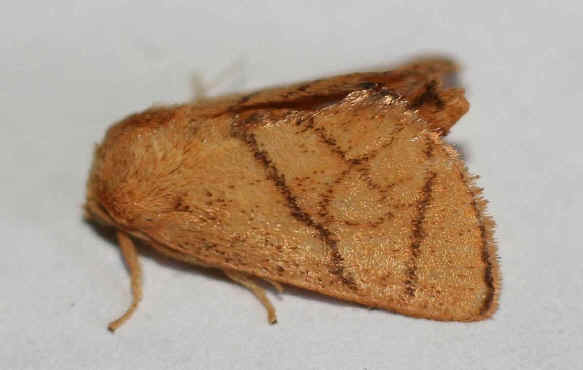
Yellow-collared Slug Moth
(photo by Stephen Kloiber)
- Spiny Oak Slug Moth ______ M#4697
NJ PA
(NW:261) (PNE:75) (W:49)
Euclea delphinii
- Red-eyed Button Slug Moth ______ PA
(W:38)
Heterogenea shurtleffi
- Crowned Slug Moth ______ M#4681
PA
(PNE:75) (W:46)
Isa textula
- Spun Glass Slug Moth ______ M#4675
(PNE:73) (W:43)
Isochaetes beutenmuelleri
- Yellow-shouldered Slug Moth (ph) ______
M#4665
NJ PA (NW:261) (PNE:73) (W:40)
Lithacodes fasciola
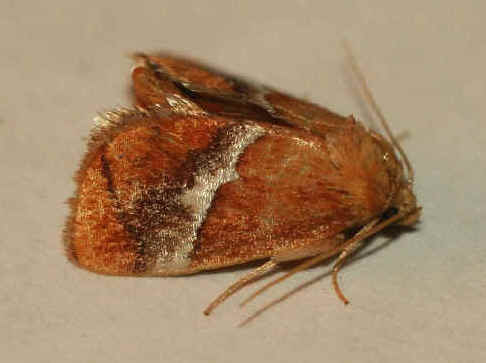
Yellow-shouldered Slug Moth
(photo by Stephen Kloiber)
- Lithacodes fiskeanus
______ M#4663
NJ
- Pin-striped Vermilion Slug Moth
______ (W:48)
Monoleuca semifascia
- Nason's Slug Moth ______
(W:45)
Natada nasoni
- Elegant Tailed Slug Moth ______
M#4661 PA
(PNE:73) (W:39)
Packardia elegans
- Jewel Tailed Slug
Moth ______
M#4659
NJ (PNE:73)
Packardia geminata
- Smaller Parasa ______ M#4698
NJ PA
(PNE:75) (W:50)
Parasa chloris
- Stinging Rose Caterpillar Moth
______ M#4699 PA (PNE:75)
(W:51)
Parasa indetermina
- Hag Moth
______ M#4677 PA (PNE:75)
(W:44)
Phobetron pithecium
The caterpillar of Phobetron pithecium is
called Monkey Slug.
- Skiff Moth ______ M#4671
NJ PA
(PNE:73) (W:42)
Prolimacodes badia
- Saddleback Moth ______ (S:287)
(W:52)
Sibine stimulea
The Saddleback caterpillars are easier to recognize than
the adult moths. The spines on their sides are mildly poisonous, and, if
touched, sting.
- Abbreviated Button Slug Moth
______ M#4654 NJ
(PNE:71)
Tortricidia flexuosa
- Red-crossed Button
Slug Moth ______ M#4653
MA PA (W:36)
Tortricidia pallida
- Early Button Slug Moth
______ M#4652 NJ
PA (PNE:71) (W:37)
(also called Warm-chevroned Moth)
Tortricidia testacea
Family ZYGAENIDAE: Smoky Moths or Leaf
Skeletonizers
This family was formerly known as PYROMORPHIDAE.
Smoky Moths
are small, black or brightly-colored, and have wingspans
from five-eighths to one and one-eighths inches (16-30mm).
They have rounded wings with a thin covering of scales and a well-developed
proboscis.
Some species are nocturnal. Members of diurnal species visit flowers and
strongly resemble CRENUCHIDS, but they can be distinguished by wing
venation.
Most caterpillars feed on the foliage of Virginia Creeper or grape. Several
often eat side by side, devouring an entire leaf before moving on to another
one.
- Clemens' False Skeletonizer Moth
______ PA
Acoloithus falsarius
- Grapeleaf Skeletonizer Moth
______ M#4624 MD
PA (PNE:71) (PNP:103
moth & caterpillar) (S:290) (W:57)
Harrisina americana
Tiny caterpillars of Harrisina americana
often line up side by side to feed on leaves. while young, they do not eat
veins, but leave them as a skeleton, hence their common name.
As they grow, the caterpillars eat small veins, leaving only the coarse
ones.
Fully grown caterpillars disperse over the vine, and then spin tough, flat
white cocoons, emerging as adults about 2 weeks later. There are probably 2
generations a year.
Among other plants, the Grapeleaf Skeletonizer Moth visits Wild
Quinine for nectar in the late spring.
Adults are all-black with an orange or red collar.
The range of the species is in the eastern US from central Minnesota south
to Texas and east.
The caterpillars of Harrisina americana
feed on grape leaves, Vitis spp.,
and on Virginia Creeper and woodbine, Parthenocissus
spp.
Their long hairs and bright yellow and black coloration help
protect them from predation.
If the caterpillar is handled, the hairs can cause a
skin rash.
The Grapeleaf Skeletonizer Moth can be mistaken for a member of the
Tiger Moth family, the Yellow-collared Scrape Moth.
- Orange-patched Smoky Moth
______ M#4639 NJ
PA (PNE:71)
Pyromorpha dimidiata
The Orange-patched Smoky Moth can be mistaken for a member of the
Tiger Moth family, the Black-and-yellow Lichen Moth.
Family CHOREUTIDAE:
Metalmark Moths
- Appleleaf Skeletonizer Moth
______ M#2560 (PNE:81)
Choreutis pariana
Family COSSIDAE: Cossid & Carpenter Moths
- Poplar Carpenterworm Moth
______ M#2675 (PNE:83)
Acossus centerensis
- Little Carpenterworm Moth
______ M#2694 MA (PNE:83)
Prionoxystus macmurtei
- Robin's Carpenterworm Moth ______
M#2693
NC NJ
PA
(NW:258) (PNE:83) (S:292)
Prionoxystus robiniae
- Leopard Moth (ph) ______ M#2700
MA NJ
PA (PNE:83)
Zeuzera pyrina
The Leopard Moth was
introduced into eastern North America from Europe in the mid 19th Century.
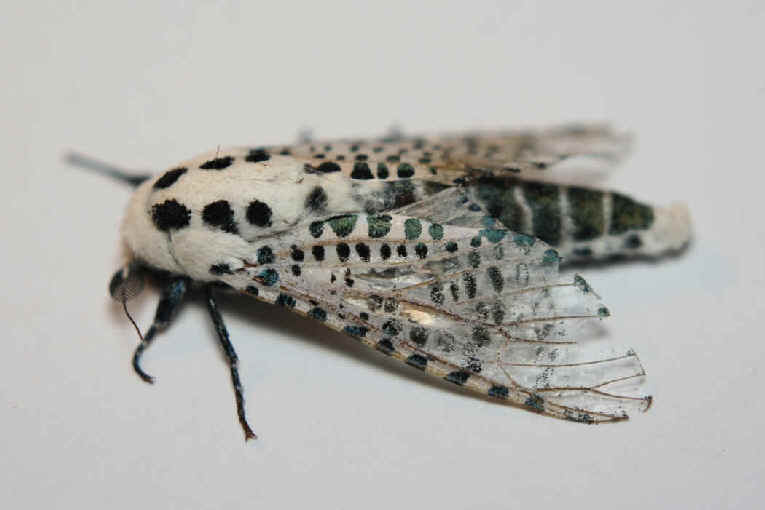
Leopard Moth
(photo by Stephen Kloiber)
Family HEPIALIDAE: Ghost Moths
- Graceful Ghost Moth ______ M#0031
PA (PNE:29)
(another name is Conifer Swift Moth)
Korscheltellus gracilis
- Lupulina Ghost Moth ______ M#0031.1 (PNE:29)
Korscheltellus lupulina
- Silver-spotted Ghost Moth
______ M#0018 (NW:255)
(PNE:27) (S:297)
Sthenopis argenteomaculatus
- Gold-spotted Ghost Moth ______
M#0022
PA (PNE:29)
Sthenopis auratus
- Four-spotted Ghost
Moth ______ M#0019 (NW:255) (PNE:27)
Sthenopis purpurascens
Another name for Sthenopis
purpurascens is Purplish Ghost Moth.
- Willow Ghost Moth
______ M#0021 (NW:255) (PNE:27)
Sthenopis thule
Family PTEROPHORIDAE: Plume Moths
- Mountain Plume Moth ______ M#6157 (PNE:129)
Adaina montanus
- Geranium Plume Moth ______ M#6118 (PNE:129)
Amblyptilia pica
- Rose Plume Moth ______ M#6105 (PNE:127)
Cnaemidophorus rhododactyla
- Lobed Plume Moth ______ M#6102 (PNE:127)
Dejongia lobidactylus
- Morning Glory Plume Moth ______ M#6234
NJ PA (PNE:131)
Emmelina monodactyla
The Morning Glory Plume Moth is common throughout eastern North America.
Adults fly Mar-Sep.
- Buck's Plume Moth ______
M#6093 (PNE:127)
Geina bucksi
- Grape Plume Moth ______ M#6091
PA (PNE:127)
Geina periscelidactylus
- Shepard's Plume Moth ______
M#6091.1 PA
Geina sheppardi
- Yarrow Plume Moth
______ M#6107 (PNE:129)
Gillmeria pallidactyla
- Plain Plume Moth
______ M#6203 (PNE:131)
Hellinsia homodactylus
- Black-marked Plume
Moth ______ M#6186 (PNE:129)
Hellinsia inquinatus
- Eupatorium Plume
Moth ______ M#6168 (PNE:129)
Oidaematophorus eupatorii
- Artichoke Plume
Moth (ph) ______ M#6109 PA (PNE:129)
Platyptilia caduidactyla
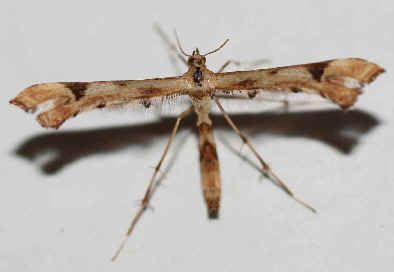
Artichoke Plume Moth
(photo by Stephen Kloiber)
Family ALUCITIDAE:
Many-plumed Moths
- Six-plume Moth (ph) ______ M#2313
(PNE:125)
Alucita montana

Six-plume Moth
Family THYRIDIDAE: Window-winged Moths
- Spotted Thyris ______ M#6076
PA (PNE:175)
Thyris maculata
- Mournful Thyris ______ M#6077
NC NJ (PNE:177)
In NC: coastal plain
Pseudothyris sepulchralis
Family
PYRALIDAE: Pyralid Moths
In this grouping, what has been the family
CRAMBIDAE: the Crambid Snout Moths
- Garden Webworm Moth ______ M#4975
NJ PA (PM:56)
(PNE:167) (a Crambid moth)
Achyra rantalis
The Garden Webworm Moth occurs commonly from southern Quebec &
Maine to Florida, west to Kansas & Texas. Adults fly Apr-Nov, with 4 or
more broods.
The larvae (Garden Webworm) feeds on: alfalfa, beans, clover, corn,
peas, strawberries, and many other low plants.
- Hickory Leafstem Borer Moth (ph)
______ M#5673
PA (PNE:139) (a Pyralid moth)
Acrobasis angusella

Hickory Leafstem Borer Moth
(photo by Stephen Kloiber)
- Pigeon Acrobasis ______
M#5670 (PNE:139) (a Pyralid moth)
Acrobasis auroella
- Hickory Shoot Borer Moth ______ M#5664 (PNE:139)
(a Pyralid moth)
Acrobasis caryae
- Walnut Shoot Moth ______ M#5674 (PNE:139) (a Pyralid moth)
Acrobasis demotella
- Leaf Crumpler Moth ______
M#5651 (PNE:137) (a Pyralid moth)
Acrobasis indigenella
- Pecanleaf Casebearer Moth ______ M#5661 (PNE:139)
(a Pyralid moth)
Acrtobasis juglandis
- Mantled Acrobasis ______ M#5659 (PNE:139) (a Pyralid moth)
Acrobasis palliolella
- Tricolored Acrobasis ______
M#5655 (PNE:139) (a Pyralid moth)
Acrobasis tricolorela
- Cranberry Fruitworm Moth ______ M#5653 (PNE:139)
(a Pyralid moth)
Acrobasis vaccinii
- Stored Grain Moth ______ M#5517 (PNE:133)
(a Pyralid moth)
Aglossa caprealis
- Calico Pyralid ______ M#5511 (PNE:133)
(a Pyralid moth)
Aglossa costiferalis
- Grease Moth ______ M#5518
(PNE:133) (a Pyralid moth)
Aglossa cuprina
- Pink-masked Pyralid ______ M#5512
NJ (PNE:133) (a Pyralid moth)
Aglossa
disciferalis
- Large Tabby Moth ______ M#5516
NJ PA (PNE:133)
(a Pyralid moth)
Aglossa pinguinalis
- Lesser Vagabond Sod Webworm Moth
______ M#5399
PA (PNE:151) (a Crambid moth)
Agriphila ruricolellus
- Vagabond Crambus Moth ______
M#5403 NC (PNE:151) (a Crambid moth)
In NC: Piedmont
Agriphila vulgivagellus
- Yellow-spotted Webworm Moth
______ M#5176 NJ
PA (PNE:173) (a Crambid moth)
Anageshna primordialis
- White-spotted Sable Moth (ph) ______
M#4958 PA
(NW:263) (PNE:167) (a Crambid moth)
Anania funebris
The White-spotted Sable Moth has a Holarctic distribution. In
eastern North America, it occurs commonly from Newfoundland to southern North
Carolina, and west to Minnesota. Adults fly May to earl-July.
It is found in fields during the day. Food includes goldenrod.
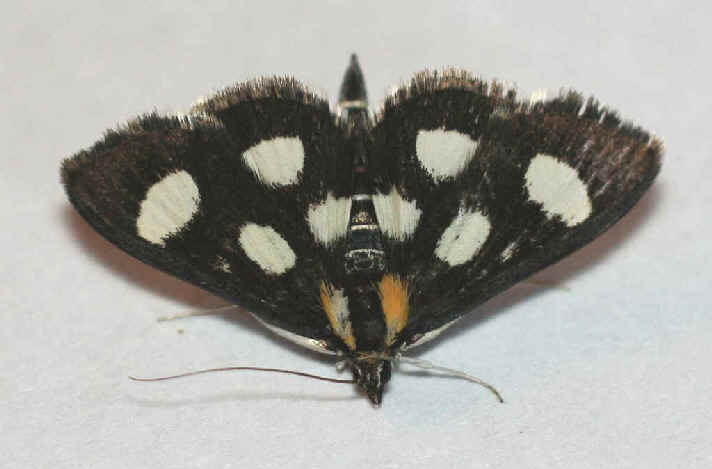
White-spotted Sable Moth
(photo by Stephen Kloiber)
- Bee Moth ______ M#5629
(PNE:137)
Aphomia sociella
- Checkered Apogeshna ______ M#5177
NJ
Apogeshna stenialis
- Two-striped Apomyelois ______ M#5721 (PNE:141) (a Pyralid moth)
Apomyelois bistriatella
- Hollow-spotted Blepharomastix ______
M#5182
NC NJ PA (PM:57) (PNE:173) (a Crambid moth)
Blepharomastix ranalis
Blepharomastix ranalis occurs commonly
from Ontario to Florida, and west to Missouri & Texas. Adults fly Apr-Oct.
In NC: in low mountains
- Three-spotted Crambus ______
M#5408 (PNE:151) (a Crambid moth)
Catoptria latiradiellus
- Sooty-winged Chalcoela ______ M#4895
NJ PA (PNE:163) (a Crambid moth)
Chacoela iphitalis
- Pegasus Chalcoela ______ M#4896
(PNE:163) (a Crambid moth)
Chacoela pegasalis
- Topiary Grass-veneer (ph) ______
M#5391 PA
(PNE:151) (a Crambid moth)
Chrysoteuchia topiaria

Topiary Grass-veneer
(photo by Stephen Kloiber)
- Trumpet Vine Moth ______
M#5563 NC In NC:
Piedmont
Clydonopteron sacculana
- Drab Condylolomia ______ M#5571 (PNE:135)
(a Pyralid moth)
Condylolomia participalis
- Small White Grass-veneer ______
M#5361 NJ PA
(PNE:149) (a
Crambid moth)
Crambus albellus
- Double-banded Grass-veneer ______
M#5362 NC NJ PA
(PM:58) (PNE:149) (a Crambid moth)
In NC: Piedmont
Crambus agitatellus
- Biden's Grass-venneer ______
M#5342 (PNE:147) (a Crambid moth)
Crambus bidens
- Girard's Grass-veneer ______
M#5365 (PNE:149) (a Crambid moth)
Crambus girardellus
- Eastern Grass-veneer (ph) ______
M#5378 PA
(PNE:151) (a Crambid moth)
Crambus laqueatellus
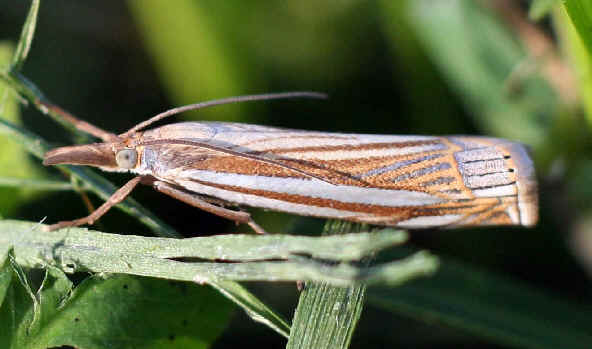
Eastern Grass-veneer
(photo by Stephen Kloiber)
- Leach's Grass-veneer ______
M#5357 (PNE:149) (a Crambid moth)
Crambus leachellus
- Immaculate Grass-veneer ______
M#5343 (PNE:149) (a Crambid moth)
Crambus perlella
- Common Grass-veneer ______ M#5355
NJ (PNE:149)
(a Crambid moth)
Crambus praefectellus
- Large-striped Grass-veneer ______
M#5369 NJ (a
Crambid moth)
Crambus quinquareatus
- Pasture Grass-veneer ______
M#5363 PA
(PNE:149) (a Crambid moth)
Crambus saltuellus
- Wide-striped Grass-veneer ______
M#5344 (PNE:149) (a Crambid moth)
Crambus unistriatellus
- Pale-winged Crocidophora ______ M#4945
PA (PNE:165)
(a Crambid moth)
Crocidophora tuberculalis
- Grape Leaffolder Moth (*) ______
M#5159 NJ PA (PM:56)
(PNE:171)
(a Crambid moth)
Desmia funeralis
The Grape Leaffolder Moth is common throughout eastern North
America. It is often seen in the daytime, but also comes to lights at night.
Adults fly Apr-Sep, with 2 or 3 broods.
PA: 2015, Jul 25
- White-headed Grape
Leaffolder Moth ______ M#5160
NJ PA (PM:56)
(a Crambid moth)
Desmia maculalis
Desmia maculalis is said to be less
common than Desmia funeralis. It occurs from Virginia to Florida, and west to
Kentucky, but probably more widely as records confused. Adults fly May-Sep.
- Dark Diacme Moth ______ M#5143
(PNE:171) (a Crambid moth)
Diacme adipaloides
- Paler Diacme Moth (ph) ______
M#5142 NJ (PM:57)
(PNE:171) (a Crambid moth)
Diacme elealis
The Paler Diacme Moth occurs from New Jersey to Florida, and west
to Kentucky & Texas. It is more common southward. Adults fly Apr-Sep.
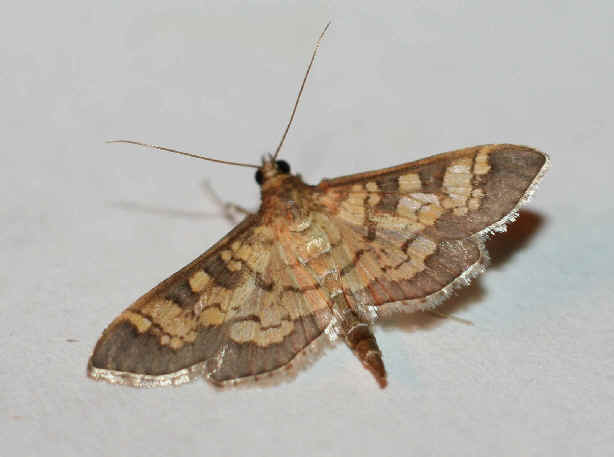
Paler Diacme Moth
(photo by Stephen Kloiber)
- Melonworm Moth (ph) ______ M#5204 (PNE:173)
(a Crambid Moth)
Diaphania hyalinata
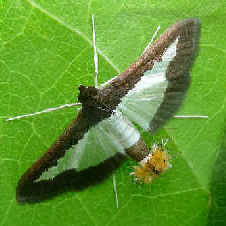
Melonworm Moth
- White-spotted Brown Moth ______ M#5255
PA (PNE:175) (a Crambid moth)
Diastictis ventralis
- Harlequin Webworm Moth ______ M#5175 (PNE:173)
(a Crambid moth)
Diathrausta harlequinalis
- Julia's Dicymolomia ______ M#4889
PA (PNE:163) (a Crambid moth)
Dicymolomia julianalis
- Evergreen Coneworm Moth ______
M#5841 (PNE:143) (a Pyralid moth)
Dioryctria abietivorella
- Webbing Coneworm Moth ______
M#5847 (PNE:143) (a Pyralid moth)
Dioryctria disclusa
- Spruce Coneworm Moth ______ M#5843 (PNE:143)
(a Pyralid moth)
Dioryctria reniculelloides
- Zimmerman Pine Moth ______
M#5852 (PNE:143) (a Pyralid moth)
Dioryctria zimmermani
- Yellow-fringed Dolichomia (*)
______ M#5533
MA PA (PNE:135) (a Pyralid moth)
Dolichomia olinalis
PA: 2015, Jul 25
- Long-beaked Donacaula ______ M#5319 (PNE:155)
(a Crambid moth)
Donacaula longirostrallus
- Delightful Donacaula ______ M#5316 (PNE:155)
(a Crambid moth)
Donacaula melinellus
- Brown Donacaula ______
M#5321 NJ
(PNE:155) (a Crambid
moth)
Donacaula roscidellus
- Donacaula sordidella
______ M#5313 NJ
PA (a Crambid moth)
- Lesser Cornstalk Borer Moth
______ M#5896 (PNE:145) (a Pyralid moth)
Elasmopalpus lignosellus
- Water Lily Borer Moth ______
M#4751 PA
(PNE:157) (a Crambid moth)
Elophila gyralis
- Pondside Crambid ______ M#4748 (PNE:157)
(a Crambid moth)
Elophila icciusalis
- Plevie's Aquatic Moth ______ M#4787 (PNE:159)
(a Crambid moth)
Eoparargyractis plevie
- Dimorphic Epipaschia
______ M#5577 (PNE:135) (a Pyralid moth)
Epipaschia superatalis
- Gold-banded Etiella
______ M#5744 (PNE:141) (a Pyralid moth)
Etiella zinckenella
- Belted Grass-veneer
______ M#5454 (PNE:153) (a Crambid moth)
Euchromius ocelleus
- Eudonia heterosalis ______
M#4739 NJ
- Striped Eudonia ______ M#4738
NJ (PNE:147)
Eudonia strigalis
- Broad-banded Eulogia ______ M#5999
PA (PNE:145) (a Pyralid moth)
Eulogia ochrifrontella
- Small Magpie ______
M#4952
(PNE:167) (a Crambid moth)
Eurrhypaa hortulata
- Spotted Peppergrass Moth (ph) ______
M#4794
NJ PA (PM:48) (PNE:161) (a Crambid moth)
Eustixia pupula
The Spotted Peppergrass Moth occurs commonly from southern Ontario to
Florida, and west to Missouri & Texas. Adults fly May-Aug, with 2 broods.
Foods include peppergrass, cabbage,
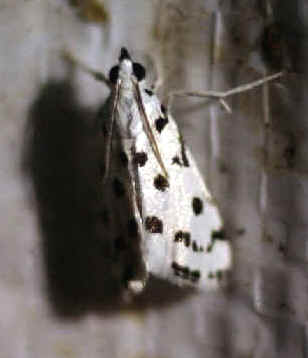
Spotted Peppergrass Moth
(photo by Stephen Kloiber)
- Root Collar Borer Moth ______ M#5997
NC (PNE:145) (a Pyralid moth)
In NC: Piedmont
Euzophera ostricolorella
Euzophera ostricolorella
is also known as the Tuliptree Borer.
- American Plum Borer Moth ______ M#5995 (PNE:145)
(a Pyralid moth)
Euzophera semifuneralis
- Purple-backed Cabbageworm Moth ______
M#4897 PA
(PM:57) (PNE:163) (a Crambid moth)
Evergestis pallidata
- Cross-striped Cabbageworm Moth ______
M#4898 NJ
Evergestis rimosalis
- Large-spotted Evergestis ______ M#4901 (PNE:165)
(a Crambid moth)
Evergestis unimacula
Evergestis unimacula occurs uncommonly from southern Ontario to North
Carolina, and west to Arkansas. Adults fly May-Aug.
- Changeable Grass-veneer ______ M#5435 (PNE:153) (a Crambid moth)
Fissicrambus mutabilis
- Mint Root Borer Moth ______ M#4950 (PNE:167)
Fumibotys fumalis
- Boxwood Leaftier ______ M#5552
PA (PNE:135)
(a Pyralid moth)
Galasa nigrinodis
- Greater Wax Moth ______ M#5622 (PNE:137)
(a Pyralid moth)
Galleria mellonella
- Black-patched Glaphyria ______ M#4873
NJ (PNE:163) (a Crambid moth)
Glaphyria fulminalis
- Common Glaphyria Moth ______ M#4869
NJ
Glaphyria glaphyralis
- White-roped Glaphyria ______ M#4870
PA (PNE:161)
(a Crambid moth)
Glaphyria sequistrialis
- Silvered Haimbachia
______ M#5488 (PNE:155) (a Crambid moth)
Haimbachia albescens
- Cabbage Webworm
Moth ______ M#4846 (PNE:161)
(a Crambid moth)
Hellula rogatalis
- Helvibotys helvialis
______
M#4980 PA (a Crambid moth)
- Herpetogramma abdominalis ______
M#5276
PA (a Crambid moth)
- Serpentine Webworm Moth ______ M#5280
PA (a Crambid moth)
Herpetogramma aeglealis
- Bold Feathered Grsss Moth ______ M#5275
PA (PNE:175) (a Crambid moth)
Herpetogramma pertextalis
- Zigzag Herpetogramma ______ M#5277
PA (PNE:175) (a Crambid moth)
Herpetogramma thestealis
- Spotted Beet Webworm Moth ______
M#5169 PA
(PNE:171) (a Crambid moth)
Hymenia perspectalis
- Clover Hayworm Moth ______ M#5524
PA (PNE:133) (a Pyralid moth)
Hypsopygia costalis
- Black-banded Immyrla ______ M#5766 (PNE:141)
(a Pyralid moth)
Immyrla nigrovittella
- Sooty Lipocosmodes ______ M#4888 (PNE:163)
(a Crambid moth)
Lipocosmodes fuliginosalis
- Alfalfa Webworm Moth ______ M#5017 (PNE:169)
(a Crambid moth)
Loxostege cereralis
- Beet Webworm Moth ______
M#5017 (PNE:169) (a Crambid moth)
Loxostege sticticalis
- Merrick's Crambid ______ M#5117 (PNE:169)
(a Crambid moth)
Loxostegopsis merrickalis
- Bog Lygropia ______ M#5250
(PNE:175) (a Crambid moth)
Lygropia rivulalis
- Zeller's Macalla ______ M#5579 (PNE:135)
(a Pyralid moth)
Macalla zelleri
- Oystershell Metrea ______ M#4789 (PNE:161)
(a Crambid moth)
Metrea ostreonalis
- Gold-striped Grass-veneer (*) ______ M#5419
PA (PNE:151)
(a Crambid moth)
Microcrambus biguttellus
PA: 2015, Jul 25
- Elegant Grass-veneer (ph) ______
M#5420 NC PA (PNE:153) (a Crambid moth)
In NC: Piedmont
Microcrambus elegans
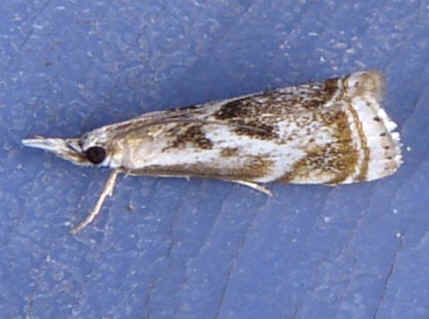
Elegant Grass-veneer
(photo by Marcie O'Connor)
- Yellow-veined Moth ______ M#4796 (PNE:161)
(a Crambid moth)
Microtheoris ophionalis
- Rufous-banded Crambid ______ M#4826 (PNE:161)
(a Crambid moth)
Mimoschinia rufofascialis
- Darker Moodna Moth ______
M#6005 NC
(PNE:145) (a Pyralid moth) In NC: Piedmont
Moodna ostrinella
- Streaked Orange Moth ______ M#4937 (PNE:165)
(a Crambid moth)
Nascia acutella
- Scrollwork Pyralid Moth ______ M#4743
NJ
Neocataclysta magnificalis
- Mottled Grass Veneer ______
M#5379 PA (PNE:151)
(a Crambid moth)
Neodactria luteolellus
- Lucerne Moth ______ M#5156
NJ PA (PM:50) (PNE:171) (a Crambid moth)
Nomophila nearctica
The Lucerne Moth is common to abundant throughout eastern North
America. Sometimes it migrates to the far north. Adults fly
Apr-Oct.
- Nymphula Moth ______ M#4747
(PNE:157) (a Crambid moth)
Nymphula ekthlipsis
- Orange-tufted Oneida ______ M#5588
NC PA (PNE:135)
(a Pyralid moth) in NC: in Piedmont
Oneida lunulalis
- Striped Birch Pyralid ______
M#5783 (PNE:141) (a Pyralid moth)
Ortholepis pasadamia
- European Corn Borer Moth (ph) ______
M#4949 NJ PA (PM:57)
(PNE:165)
(a Crambid moth)
Ostrinia nubilalis
The European Corn Borer Moth was introduced into North America
around 1908 from Europe. It occurs throughout eastern North
America, north of southern Florida. Adults fly Apr-Oct. 1 brood in the
north.
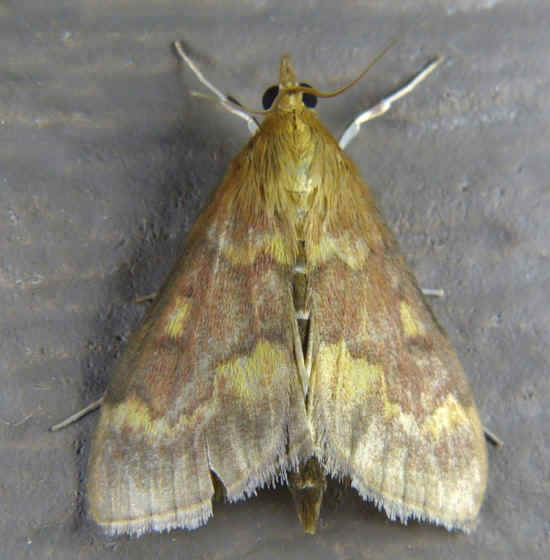
European Corn Borer Moth
(photo by Marcie O'Connor)
- Kimball's Palpita ______ M#5219 (PNE:173)
(a Crambid moth)
Palpita kimballi
- Splendid Palpita (*) ______
M#5226 PA (PNE:173) (a Crambid moth)
Palpita magniferalis
PA: 2015, Jul 25
- Basswood Leafroller Moth ______ M#5241 (PNE:173)
(a Crambid moth)
Pantographa limata
- Graceful Grass-veneer Moth ______
M#5450 NC
In NC: Piedmont
Parapediasia decorellus
- Bluegrass Webworm Moth ______ M#5451
PA (PNE:153)
(a Crambid moth)
Parapediasia teterrella
- Watermilfoil Leafcutter Moth
______ M#4764 NJ
(PNE:159)
(a Crambid moth)
Parapoynx allinonealis
- Chestnut-marked Pondweed Moth (ph)
______ M#4761 NJ
(PNE:159) (a Crambid moth)
Parapoynx badiusalis

Chestnut-marked Pondweed Moth
(photo by Marcie O'Connor)
- Polymorphic Pondweed Moth ______ M#4759
NJ (PNE:157)
(a Crambid moth)
Parapoynx maculalis
- Obscure Pondweed Moth (ph) ______
M#4760 NJ PA (PM:57)
(PNE:159) (a Crambid moth)
Parapoynx obscuralis
The Obscure Pondweed Moth occurs from Nova Scotia to Florida, and
west to Wisconsin & Texas. It is locally common. Adults fly Jun-Aug. Foods
include eelgrass, pondweed, yellow waterlily, and other aquatic
plants.
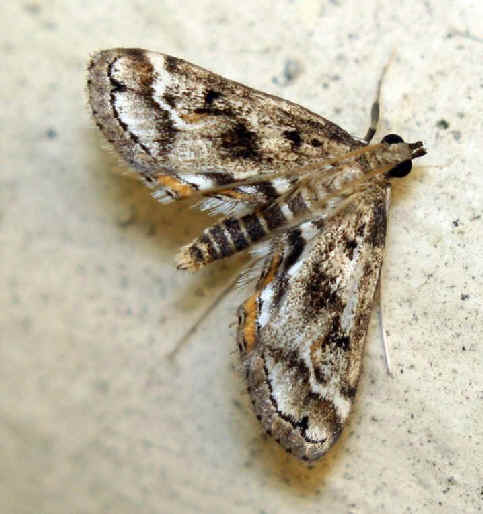
Obscure Pondweed Moth
(photo by Stephen Kloiber)
- Sod Webworm Moth ______ M#5413
PA (PNE:151) (a Crambid moth)
Pediasia trissecta
- Carmine Snout Moth ______ M#6053 (PNE:147) (a Pyralid moth)
Peoria approximella
- Titian Peale's
Pyralid Moth ______ M#4951 PA
(PNE:167)
(a Crambid moth)
Perispasta caeculalis
- Two-banded Petrophila (*) ______
M#4774 PA (PNE:159)
(a Crambid moth)
Petrophila bifascialis
PA: 2015, Jul 25
- Crowned Phlyctaenia (ph)
______ M#4953 PA
(PNE:167)
(a Crambid moth)
Phlyctaenia coronata
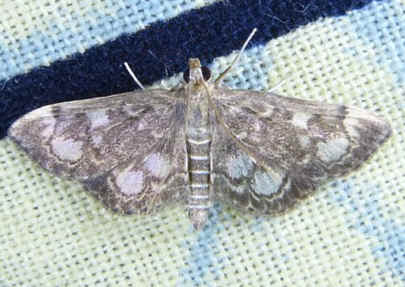
Crowned Phlyctaenia
(photo by Marcie O'Connor)
- Scraped Pilocrocis ______
M#5281 (PNE:175) (a Crambid moth)
Pilocrocis ramentalis
- White-edged Pima Moth ______ M#5747
PA (a Pyralid moth)
Pima
albiplagiatella
- Maple Webworm Moth ______ M#5606 (PNE:137)
Pococera asperatella
- Striped Oak Webworm Moth ______
M#5608
PA (PNE:137)
(a Pyralid moth) (another name has Double-humped Pococera)
Pococera
expandens
- Sycamore Webworm
Moth ______ M#5604 (PNE:137)
(a Pyralid moth)
Pococera militella
- Ironweed Root Moth
______ M#5228 (PNE:173) (a Crambid moth)
Polygrammodes flavidalis
- Prionapteryx
achatina ______ M#5334
NJ
- Obscure Psara ______
M#5268 NJ
Psara obscuralis
- Red-shawled Moth ______
M#5526 (PNE:135) (a Pyralid moth)
Pseudasopia intermedialis
- Speckled Black Pyla ______ M#5829 (PNE:143) (a Pyralid moth)
Pyla fusca
- Meal Moth ______ M#5510
PA (NW:263) (PNE:133) (a Pyralid moth)
Pyralis farinalis
- Mint-loving Pyrausta
______ M#5071 PA
(PM:57) (PNE:169) (a Crambid moth)
Pyrausta acrionalis
Pyrausta acrionalis occurs commonly
from Nova Scotia to Florida, and west to Manitoba, Missouri, Texas. Adults fly
Apr-Oct. Favored foods are mints.
- Bicolored Pyrausta ______ M#5040
NJ (PM:57)
(PNE:169) (a Crambid moth)
Pyrausta bicoloralis
- Pyrausta
niveicilialis ______ (PM:58)
Pyrausta niveicilialis occurs from
southern Ontario to Florida. It is local, and usually uncommon.
- Orange-spotted Pyrausta ______ M#5058
PA (PNE:169)
(has also been called the
Orange Mint Moth) (a Crambid moth)
Pyrausta orphisalis
- Variable Reddish Pyrausta ______ M#5051
PA (a Crambid moth)
Pyrausta rubricalis
- Raspberry Pyrausta (ph) ______
M#5034 NJ PA (NW:263) (PM:57)
(PNE:169) (a Crambid moth)
Pyrausta signatalis
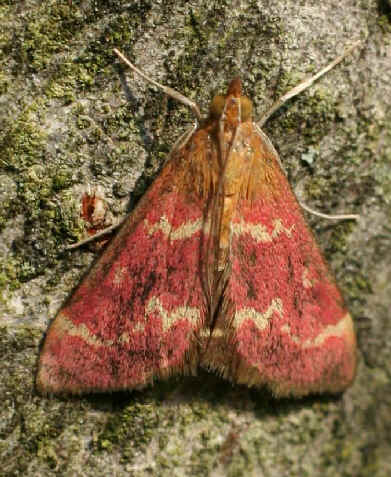
Raspberry Pyrausta
(photo by Stephen Kloiber)
- Pyrausta subsequalis
______ (PM:57)
Pyrausta subsequalis occurs throughout
eastern North America. Adults fly May-Aug.
- Pyrausta tyralis
______ (PM:57)
Pyrausta tyralis occurs from New York
to Florida, and west to Illinois & Texas. It is common southward. Adults
fly Jun-Oct. A favored food is wild coffee.
- Engel's Salebriaria ______ M#5773 (PNE:141) (a Pyralid moth)
Salebriaria engeli
- Dogbane Saucrobotys ______
M#4936 PA
(PNE:165) (a Crambid moth)
Saucrobotys futilalis
- Yellow-shouldered Leafroller Moth
______ M#5799 (PNE:143) (a Pyralid moth)
Sciota basilaris
- Locust Leafroller Moth ______
M#5796 PA
(PNE:141) (a Pyralid moth)
Sciota subcaesiella
- Belted Leafroller Moth ______ M#5794 (PNE:141) (a Pyralid Moth)
Sciota vetustella
- Black-spotted Leafroller Moth
______ M#5797 PA
(PNE:141)
(a Pyralid moth)
Sciota virgatella
- Many-spotted Scoparia Moth ______
M#4719 PA
(PNE:147) (a Crambid moth)
Scoparia basalis
- Double-striped Scoparia Moth
______ M#4716 PA
(PNE:147)
(a Crambid moth)
Scoparia biplagialis
- Carrot Seed Moth (ph) ______
M#4986.1 (PNE:167) (a Crambid moth)
Sitochroa palealis
The Carrot Seed Moth was introduced from Europe. The caterpillars
eat Queen Anne's Lace, also called Wild Carrot, and other plants
in the same family.
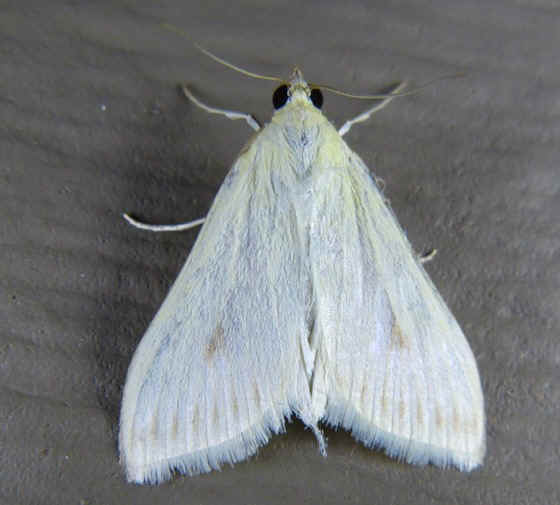
Carrot Seed Moth
(photo by Marcie O'Connor)
- Hawaiian Beet Webworm Moth ______
M#5170 NJ
(PM:56) (PNE:171) (a Crambid moth)
Spoladea recurvalis
The Hawaiian Beet Webworm Moth occurs from New York to Florida, and
west to Illinois and Texas. it is common southward and in the tropics. Adults
fly Aug-Oct, with 2 broods.
- Waterlily Leafcutter Moth ______ M#4755
NJ (PM:57) (PNE:157)
Synclita obliteralis
- Black Duckweed Moth ______
M#4754 (PNE:157) (a Crambid moth)
Synclita tinealis
- Oval Telethusia ______ M#5812 (PNE:143)
(a Pyralid moth)
Telethusia ovalis
- Tlascala Moth ______ M#5808
(PNE:143) (a Pyralid moth)
Tlascala reductella
- Woolly Grass-veneer ______ M#5439 (PNE:153)
(a Crambid moth)
Thaumatopsis pexellus
- Dimorphic Tosale ______
M#5556 (PNE:135) (a Pyralid moth)
Tosale oviplagalis
- Celery Leaftier Moth (ph) ______
M#5079 NJ PA (PM:56)
(PNE:169)
(a Crambid moth)
Udea rubigalis
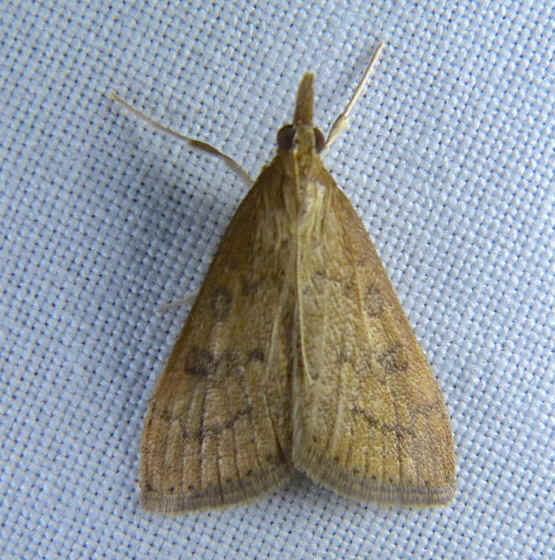
Above & below: the Celery Leaftier Moth
Below, next to a dime.
(above photo by Marcie O'Connor)

- Genista Broom Moth ______ M#4992
(PNP:63 caterpillar) (a
Crambid moth)
Uresiphita reversalis
Caterpillars of Uresiphita reversalis
hatch in early August and feed during the day on foliage of Baptisia
species (such as White Wild Indigo) and on other host plants in the
genera Acacia, Genista, and Sophora.
Their long hairs help protect them from
predation.
- Snowy Urola (ph) ______ M#5464
PA (PNE:153)
(a Crambid moth)
Urola nivalis
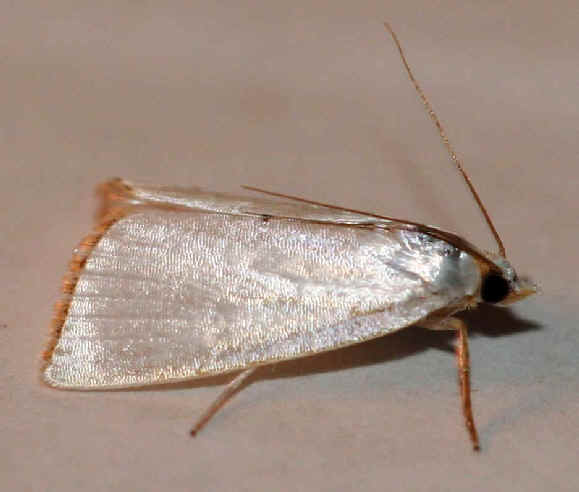
Snowy Urola
(photo by Stephen Kloiber)
- Curve-lined Argyria
______ M#5465 (PNE:153) (a Crambid moth)
Vaxi auratella
- Straight-lined Argyria
______ M#5466 (PNE:155) (a Crambid moth)
Vaxi critica
- Brower's Vitula
______ M#6011 (PNE:145) (a Pyralid moth)
Vitula broweri
- Dried Fruit Moth ______
M#6007 (PNE:145) (a Pyralid moth)
Vitula edmandsii
- Xanthophysa Moth
______ M#4879 (PNE:163) (a Crambid moth)
Xanthophysa psychialis
Family
MEGALORYGIDAE: Flannel Moths
MEGALORYGIDAE is a largely Neotropical
family. More than 40 species occur in Costa Rica.
Although members of this family appear soft and harmless, Flannel Moth
caterpillars are among the most well-defended insects. Beneath their soft,
outer hair are warts that are fortified with hollow, poison-filled stinging
spines that are capable of giving painful stings.
A caterpillar of one particularly large Amazonian species is about 8
centimeters in length. Its sting has purportedly resulted in human deaths.
Thus, the common name for that caterpillar is "el raton", "the
rat".
4 species in this family extend into eastern North
America.
- Black-waved Flannel Caterpillar
______ MD PA (W:54)
Megalopyge (or Lagoa) crispata
- Southern Flannel Moth ______ (W:55)
("Puss Caterpillar")
Megalopyge opercularis
- White Flannel Moth ______
(W:56)
Norape ovina
Family
TORTRICIDAE:
Leafroller or Tortricid Moths
- Brittania Moth ______ M#3537
PA
Acleris britannia
- Celiana's Acleris
______ M#3533 (PNE:87)
Acleris celiana
- Acleris cervinana
______ M#3514 PA
- Lesser Maple Leafroller Moth
______ M#3539 (PNE:87)
Acleris chalybeana
- Multiform Leafroller Moth ______ M#3542
NJ PA (PNE:89)
Acleris flavivittana
Acieris flavivittana
has also been called Masked Leaftier Moth.
- Hairnet Acleris
______ M#3501 (PNE:85)
Acleris forskaleana
- Strawberry Acleris
______ M#3532 (PNE:87)
Acleris fragariana
- Small Aspen Leaftier
Moth ______ M#3520 (PNE:85)
Acleris fuscana
- Hasty Acleris
______ M#3531
PA (PNE:87)
Acleris hastiana
- Black-spotted Acleris ______ M#3551 (PNE:89)
Acleris inana
- Black-headed Birch Leafroller Moth
______ M#3540 (PNE:87)
Acleris logiana
- MacDunnough's Acleris ______ M#3506 (PNE:85)
Acleris macdunnoughi
- Great Acleris ______ M#3557
(PNE:89)
Acleris maximana
- Speckled Acleris ______
M#3526 (PNE:87)
Acleris negundana
- Black-lined Acleris ______
M#3556 (PNE:89)
Acleris nigrolinea
- Snowy-shouldered Acleris ______ M#3510 (PNE:85)
Acleris nivisellana
- Schaller's Acleris Moth ______
M#3527 PA
Acleris schallereana
- Half-ringed Acleris ______ M#3521 (PNE:87)
Acleris semiannula
- Oak Leafshredder ______ M#3503
NJ (PNE:85)
Acleris semipurpurana
Aclerris semipurpurana
has also been called Oak Leaftier Moth.
- Common Acleris ______
M#3517 (PNE:85)
Acleris subnivana
- Eastern Black-headed Budworm Moth
______ M#3548 (PNE:89)
Acleris variana
- Young's Acleris ______
M#3550 (PNE:89)
Acleris youngana
- Shimmering Adoxophyes (ph) ______
M#3691 PA
(PNE:103)
Adoxophyes negundana
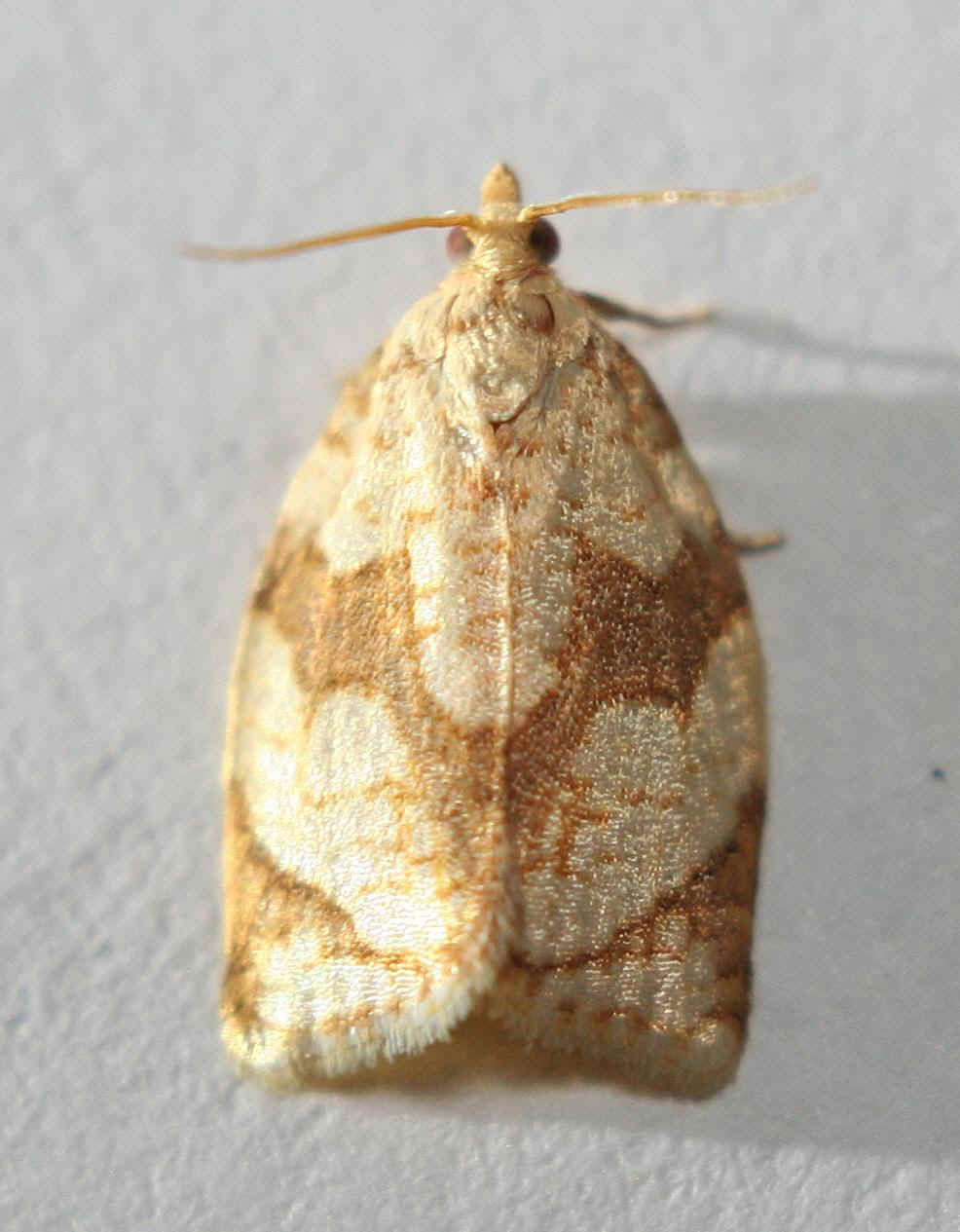
Shimmering Adoxophyes
(photo by Stephen Kloiber)
- Angular Aethes Moth ______ M#3807
PA
Aethes angulatana
- Silver-bordered Aethes ______ M#3754.2 (PNE:91) (a Cochylid moth)
Aethes argentilimitana
- Two-spotted Aethes ______
M#3754.3 (PNE:91) (a Cochylid moth)
Aethes atomosana
- Reddish Aethes ______ M#3755.1 (PNE:91) (a Cochylid moth)
Aethes biscana
- Dark-spotted Aethes ______ M#3758.2 (PNE:91) (a Cochylid moth)
Aethes mymara
- Patricia's Aethes ______ M#3759 (PNE:91) (a Cochylid moth)
Aethes patricia
- Razowski's Aethes ______ M#3759.3
NJ
Aethes razowskii
- Seriated Aethes ______ M#3760.1
NJ
Aethes seriatana
- Six-toothed Aethes ______ M#3760.2 (PNE:93) (a Cochylid moth)
Aethes sexdentata
- White-lined Leafroller Moth
______ M#3748 NC
PA
(PNE:107)
Amorbia humerosana
- Strawberry Leafroller Moth ______
M#3374 NJ
Ancylis comptana
- Ancylis Platanana Moth ______ M#3370
PA
Ancylis platanana
- Deceptive Apotomis ______ M#2765 (PNE:109)
(an Olethreutine moth)
Apotomis deceptana
- Fruit Tree Leafroller Moth ______
M#3648 NJ (PNE:99)
Archips argyrospila
- Ugly-nest Caterpillar Moth ______
M#3661 (PNE:101)
Archips cerasivorana
- Boldly-marked Archips ______ M#3666 (PNE:101)
Archips dissitana
- Oak Webworm Moth ______ M#3655 (PNE:101)
Archips fervidana
- Spring Spruce Needle Moth ______
M#3667 (PNE:101)
Archips pachardiana
- Omnivorous Leafroller Moth ______
M#3658 PA (NW:259)
(PNE:101)
Archips purpurana
- White-spotted Oak Leafroller Moth
______ M#3653 NJ
(PNE:101)
Archips semiferana
- Striated Tortrix ______
M#3664 (PNE:101)
Archips strianus
- White-spotted Leafroller Moth
______ M#3624 (PNE:97)
Argyrotaenia alisellana
- Gray-banded Leafroller Moth
______ M#3625 (PNE:99)
Argyrotaenia mariana
- Pine Tube Moth ______
M#3602 NJ PA
Argyrotaenia pinatubana
- Four-lined Leafroller Moth ______
M#3621 (PNE:97)
Argyrotaenia quadrifasciana
- Lined Oak Leafroller Moth ______ M#3623
NJ PA (PNE:97)
Argyrotaenia quercifoliana
- Red-banded Leafroller Moth ______
M#3597 NJ PA
(PNE:97)
Argyrotaenia velutinana
- Primrose Cochylid ______
M#3848 (PNE:95) (a Cochylid moth)
Atroposia oenotherana
- Javelin Moth ______
M#2707 MD (PNE:107) (an Olethreutine moth)
Bactra verutana
- Celypha Moth ______ M#2859
MD NJ
Celypha cesputana
- Oak Cenopis ______
M#3716
(PNE:105)
Cenopis diluticostana
- Aproned Cenopis ______
M#3727 (PNE:105)
Cenopis niveana
- Maple-Basswood Leafroller ______
M#3275 (PNE:105)
Cenopis pettitana
- Reticulated Fruitworm Moth ______
M#3720 NJ (PNE:105)
Cenopis reticulatana
- Filigreed Chimoptesis _____ M#3273
NJ
Chimoptesis
pennsylvaniana
- Large Aspen Tortrix ______ M#3637 (PNE:99)
Choristoneura conflictana
- Broken-banded Leafroller Moth
______ M#3632 NJ
PA (PNE:99)
Choristoneura fractivittana
- Spruce Budworm Moth
______ M#3638 (PNE:99)
Choristoneura fumiferana
- Choristoneura obsoletana
______ M#3631
NJ
- Spotted Fireworm Moth ______ M#3633
NJ
Choristoneura paralleta
- Jack-pine Budworm Moth ______
M#3643 (PNE:99)
Choristoneura pinus
- Oblique-banded Leafroller Moth
______ M#3635
NJ PA (PNE:99)
Choristoneura rosaceana
- Clemens' Clepsis Moth ______ M#3684
PA (PNE:103)
Clepsis clemensiana
- Clepsis consimilana
______ M#3683
NJ
- Black-patched Clepsis ______
M#3686 (PNE:103)
Clepsis melaleucanus
- Garden Tortrix ______ M#3688
NJ PA (PNE:103)
Clepsis peritana
- White-triangle Clepsis ______ M#3682 (PNE:103)
Clepsis persicana
- Pink-mottled Cochylid ______ M#3767 (PNE:93) (a Cochylid moth)
Cochylis aurorana
- Horned Cochylid ______ M#3769 (PNE:93) (a Cochylid moth)
Cochylis bucera
- Banded Sunflower Moth ______
M#3777 (PNE:93) (a Cochylid moth)
Cochylis hospes
- Broad-patch Cochylid ______ M#3778 (PNE:93) (a Cochylid moth)
Cochylis nana
- Rings' Cochylid ______
M#3780 (PNE:93) (a Cochylid moth)
Cochylis ringsi
- The Batman Moth ______ M#3747
PA
Coelostathma discopunctana
- Filbertworm Moth ______ M#3494
NJ PA (PM:60)
Cydia (formerly Melissopus) latiferreanus
- Codling Moth ______ (PM:60)
Cydia pomonella
- Gray-marked Tortricid ______ M#3573 (PNE:91)
Decodes basiplagana
- Locust Twig Borer Moth ______ M#3497
NJ PA (PM:60)
Ecdytolopha insiticiana
- Dotted Ecdytolopha Moth ______ M#3495
NJ PA (PM:60)
Ecdytolopha punctidicana
- Dull-barred Endothenia ______ M#2738 (PNE:107) (an Olethreutine moth)
Endothenia hebesana
- Bidens Borer Moth ______ M#3202
PA NJ (PM:60)
Epiblema otiosana
- Maple Tip Borer Moth ______ M#2703
MD NJ
Episimus tyrius
- Solidago Eucosma Moth ______ M#3142
PA
Eucosma cataclystiana
- Shortleaf Pinecone Borer Moth
______ M#3072 NJ
Eucosma cocana
- Derelict Eucosma Moth ______
M#3120 PA
Eucosma derelicta
- Triangle-backed Eucosma ______ M#3116 (PNE:115)
(an Olethreutine moth)
Eucosma dorsisignatana
- Robinson's Eucosma ______
M#3009 (PNE:115) (an Olethreutine moth)
Eucosma robinsonana
- Similar Eucosma ______
M#3116.1 PA
(PNE:115) (an
Olethreutine Moth)
Eucosma similiana
- White Pine Cone Borer Moth ______
M#3074 NJ
(PNE:115) (an
Olethreutine moth)
Eucosma tocullionana
- Ferruginous Eulia ______ M#3565 (PNE:89)
Eulia ministrana
- Sculptured Moth ______ M#2749
PA NJ (PNE:109)
(an Olethreutine moth)
Eumarozia malachitana
- Grapholita Eclipsana Moth ______ M#3438
PA
Grapholita eclipsana
- Green Budworm Moth
______ M#2862 MD
(PNE:113) (an Olethreutine moth)
Hedyra nubiferana
- Impudent Hulda
______ M#2747 MD
(PNE:109) (an Olethreutine moth)
Hulda impudens
-
Larisa subsolana ______ M#3423
NC NJ
In NC: Piedmont
- Pink-washed Leafroller ______ M#2860
MD (PNE:113) (an Olethreutine moth)
Metendothenia separatana
- Doubleday's Notocelia Moth ______
M#3208 PA NJ
Notocelia rosaecolana
- Divided Olethreutes ______ M#2848
MD (PNE:113) (an Olethreutine moth)
Olethreutes bipartitana
- Wretched Olethreutes ______
M#2791 MD (PNE:111) (an Olethreutine moth)
Olethreutes exoletum
- Banded Olethreutes ______ M#2823
NJ (PNE:111)
(an Olethreutine moth)
Olethreutes fasciatana
- Hydrangea Leaftier Moth ______ M#2827
MD (PNE:111)
(an Olethreutine moth)
Olethreutes ferriferana
- Iron-lined Olethreutes ______ M#2838.1 (PNE:111)
(an Olethreutine moth)
Olethreutes ferrolineana
- Woolley-backed Moth ______ M#2776
MD PA (an Olethreutine moth)
Olethreutes furfuranum
- Frosty Olethreutes ______
M#2847 (PNE:113) (an Olethreutine moth)
Olethreutes glaciana
- Inornate Olethreutes ______ M#2788
MD (PNE:111)
(an Olethreutine moth)
Olethreutes inornatana
- Malana Leafroller Moth ______
M#2820 MD (PNE:111) (an Olethreutine moth)
Olethreutes malana
- Dark Olethreutes ______
M#2800 MD
(PNE:111) (another name is Variable Nigranum) (an Olethreutine moth)
Olethreutes nigranum
- Shining Olethreutes
______ M#2775 MD
(PNE:109) (an Olethreutine moth)
Oleuthreutes nitidana
- Raspberry Leafroller
Moth ______ M#2817 MD PA
Olethreutes permundana
- Punctuated Olethreutes
______ M#2786 (PNE:109) (an Olethreutine moth)
Oleuthreutes punctanum
- Quartered Olethreutes
______ M#2794 NJ
(an Olethreutine moth)
Olethreutes quadrifidum
- Dusky Leafroller Moth ______ M#2770
PA (PNE:109) (an Olethreutine moth)
Orthotaenia undulana
- Three-lined Leafroller Moth
______ M#3594 NC
NJ
PA (PM:59) (PNE:97)
In NC: Piedmont
Pandemis limitata
- Tulip-tree Leaftier Moth
______ M#2711 PA
(an Olethreutine moth)
Paralobesia liriodendrana
- Grape Berry Moth ______
M#2712 (PNE:107) (an Olethreutine moth)
Paralobesia viteana
- Macrame Moth ______ M#2771
PA
Phaecasiophora confixana
- Labyrinth Moth ______ M#2772
NJ PA
Phaecasiophora nivelguttana
- Brown-patched Phalonidia ______
M#3807 (PNE:93) (a Cochylid moth)
Phalonidia lepidana
- Pale-headed Phaneta ______
M#2927 (PNE:115) (an Olethreutine moth)
Phaneta ochrodephala
- Buff-tipped Phaneta ______
M#2929 MD (PNE:115) (an Olethreutine moth)
Phaneta ochroteerminana
- Reddish Phaneta ______ M#2928
MD (PNE:115) (an Olethreutine moth)
Phaneta raracana
- Aster-head Phaneta ______ M#2936
MD (PNE:115) (an Olethreutine moth)
Phaneta tomonana
- Shaded Phaneta ______
M#2913 (PNE:113) (an Olethreutine moth)
Phaneta umbrastriana
- Bird's Cochylid ______ M#3813 (PNE:93)
(a Cochylid moth)
Phtheochroa birdana
- Marbled Cochylid ______ M#3822 (PNE:95)
(a Cochylid moth)
Phtheochroa riscana
- Silver-lined Cochylid ______ M#3825 (PNE:95)
(a Cochylid moth)
Phtheochroa vitellinana
- Exasperating Platynota ______
M#3743
PA (PNE:107)
Platynota exasperatana
- Black-shaded Platynota ______
M#3732 NJ PA
Platynota flavedana
- Tufted Apple Budworm Moth ______ M#3740
NJ PA (PNE:105)
Platynota idaeusalis
- Singed Platynota ______ M#3741 (PNE:107)
Platynota semiustana
- Maple Twig Borer Moth ______ M#3230
NJ
Proteoteras aesculana
- Pseudexentera
costomaculana ______ M#3257
NJ
- Poplar Leafroller Moth ______
M#2769 (PNE:109) (an Olethreutine moth)
Pseudosciaphia duplex
- Northern Pitch Twig Moth ______
M#2892 (PNE:113) (an Olethreutine moth)
Retinia albicapitana
- Pitch Twig Moth ______ M#2889
MD NJ (an Olethreutine moth)
Retinia comstockiana
- Gray Retinia ______ M#2898
(PNE:113) (an Olethreutine moth)
Retinia gemistrigulana
- Kearfott's Rolandylis ______ M#3837 (PNE:95)
(a Cochylid moth)
Rolandylis maiana
- Adana Tip Moth ______ M#2877
MD NJ
Rhyacionia adana
- European Pine Shoot Moth ______ M#2867
MD (PNE:113) (an Olethreutine moth)
Rhyacionia buoliana
Rhyacionia buoliana is introduced in eastern North America from Europe.
- Speckled Sereda ______ M#3425
NJ
Sereda tautana
- Sparganothis caryae
______ M#3700
NJ
- Distinct Sparganothis Moth ______
M#3704 NJ
Sparganothis distincta
- Spring Deadleaf Roller Moth
______ M#3716 PA
Sparganothis diluticostana
- Sparganothis Fruitworm Moth (ph) ______
M#3695 NJ PA
(PNE:103)
Sparganothis sulfureana
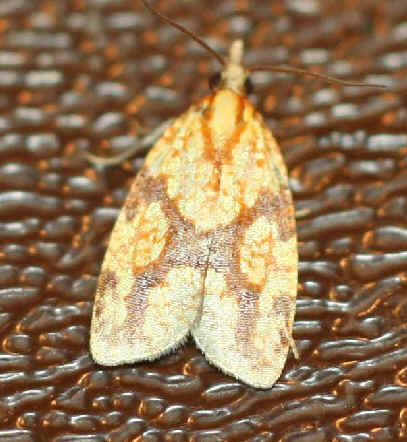
Sparganothis Fruitworm Moth
(photo by Stephen Kloiber)
- Three-streaked Sparganothis Moth
______ M#3699 NJ
(PNE:105)
Sparganothis tristriata
- One-lined Sparganothis Moth (ph)
______ M#3711 PA (PNE:105)
Sparganothis unifasciana
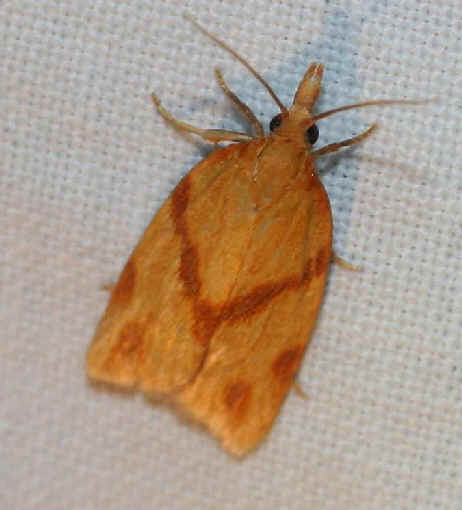
One-lined Sparganothis Moth
(photo by Stephen Kloiber)
- Black-and-gray Banded Leafroller Moth ______
M#3672 PA (PNE:101)
Syndemis afflictana
- Psychedelic Jones Moth ______
M#3751 NJ
Thaumatographa jonesi
- Dark-banded Cochylid
______ M#3843 (PNE:95) (a Cochylid moth)
Thyraylia bana
- Holland's Cochylid
______ M#3847 (PNE:95) (a Cochylid moth)
Thyraylia hollandana
- Xenotemna pallorana
______ M#3693
NJ
Family SESIIDAE:
Clear-winged Moths
- Virginia Creeper Clearwing Moth
______ M#2532 (NW:257) (PNE:77)
Albuna fraxini
- Clematis Clearwing Moth ______ MD
Alcathose caudata
- Eupatorium Borer Moth ______
M#2596 MD
(PM:61) (PNE:81)
Carmenta bassiformis
- The Boneset Borer ______ MD
Carmenta pyramidiformis
- Squash Vine Borer ______ M#2536
MD (PM:61) (PNE:77)
Melittia cucurbitae
- Hornet Clearwing ______ MD
(PM:61)
Parathrene simulans
- Raspberry Crown Borer Moth ______
M#2513 MD (PM:61)
(PNE:77)
Pennisetia marginata
- Banded Ash Clearwing ______ MD
Podosesia aureocinta
- Ash Borer Moth ______
MD (PM:60)
Podosesia syringae
Another name for Podosesia syringae
is Lilac Borer Moth.
- Lesser Grape Root Borer Moth
______ MD
Sciapteron scepsiformis
- Lilac Borer Moth ______
M#2589 (PNE:81)
Podosesia syringae
- European Hornet Moth ______
M#2542 (PNE:77)
Sesia apiformis
Sesia apiformis is introduced in northeastern North America from
Europe.
- American Hornet Moth ______ M#2543
(PNE:79)
Sesia tibiale
- Maple Callus Borer Moth ______ M#2554
(NW:256) (PNE:81)
Synanthedon acerni
- Red Maple Borer Moth ______ M#2546
MD (PNE:79)
Synanthedon acerrubri
- Maple Callus Borer Moth ______ M#2554
MD NC
(PM:61)
Synanthedon acerni
- Peachtree Borer Moth ______ M#2583
MD PA (PM:60)
(PNE:81)
Synanthedon exitiosa
- Birch Borer Moth ______
(NW:257)
Synanthedon fulvipes
- Holly Borer Moth ______ MD
Synanthedon kathyae
- Lesser Peachtree Borer Moth
______ M#2550 MD
(PM:60) (PNE:79)
Synanthedon pictipes
- Apple Bark Borer Moth ______ M#2565
PA
Synanthedon pyri
- Riley's Clearwing Moth ______ M#2552
PA (PNE:79)
Synanthedon rileyana
- Rhododendron Borer Moth ______ MD
Synanthedon rhododendri
- Synanthedon
richardsi ______ MD
- Riley's Clearwing Moth ______ MD
(PM:61)
Synanthedon rileyana
- Dogwood Borer Moth ______ M#2549
MD
(NW:257) (PM:60) (PNE:79)
Synanthedon scitula
- Currant Clearwing Moth ______ M#2553
(PNE:79)
Synanthedon tipuliformis
Family YPONOMEUTIDAE:
Ermine Moths
including here ACROLEPIIDAE, GLYPHIPTERIGIDAE, and PLUTELLIDAE
Certain members of the unrelated SNOUT
MOTHS (in PYRALIDAE) are also known as "Ermine Moths".
- Carrionflower Moth ______
M#2490 (PNE:47)
Acrolepiopsis incertella
- Honey-comb Micro Moth ______ M#2435 (PNE:43)
Argyresthia alternatella
- Bronze Alder Moth ______ M#2457 (PNE:43)
Argyresthia goedartella
- Cherry Shoot Borer Moth ______ M#2467
NJ (PNE:43)
Argyresthia oreasella
- Ailanthus Webworm Moth ______
M#2401 PA NC NJ
(PNE:41)
Atteva aurea (was
Atteva punctella)
- Yellow Nutsedge Moth
______ M#2346 (PNE:45)
Diploschizia impigritella
- Dame's Rocket Moth
______ M#2363 (PNE:45)
Plutella porrectella
- Diamondback Moth (ph) ______
M#2366 NJ (PNE:47)
Plutella xylostella
The Diamondback Moth was introduced
into the New World from Europe before the 1850s.
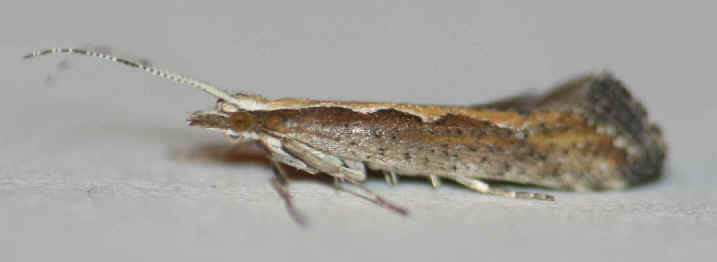
Diamondback Moth
(photo by Stephen Kloiber)
- Gray-blue Swammerdamia ______ M#2413 (PNE:41)
Swammerdamia caesiella
- Spindle Ermine Moth ______ M#2423.1 (PNE:43)
Yponomeuta cagnagella
- American Ermine Moth ______ M#2420
PA (PNE:43)
Yponomeuta
multipunctella
- Orchard Ermine Moth ______ M#2421 (PNE:43)
Yponomeuta padella
- Pine Needle Sheathminer Moth
______ M#2427 (PNE:43)
Zelleria haimbachi
Family LYONETIIDAE:
Needleminer Moths
- Clemens' Philonome ______ M#0462 (PNE:41)
Philonome clemensella
Family YPSOTOPHIDAE: Falcate-winged Moths
- Canary Ypsolopha
______ H#2371 (PNE:45)
Ypsolopha canariella
- European Honysuckle
Moth ______ H#2373 (PNE:45)
Ypsolopha dentella
The European Honeysuckle Moth is introduced in eastern North America from
Europe.
- Scythed Ypsolopha
______ H#2380 (PNE:45)
Ypsolopha falciferella
Family
GELECHIIDAE:
Twirler Moths
- Dark-headed Aspen
Leafroller Moth ______ M#2237
(PNE:65)
Anacampsis innocuella
- Unstriped Anacampis
______ M#2244 (PNE:65)
Anacampsis nonstrigella
- Peach Twig Borer
Moth ______ M#2257
(PNE:65)
Anarsia lineatella
- Pink-washed Aristotelia
______ M#1761 (PNE:61)
Aristotelia roseosuffususella
- White Stripe-backed
Moth ______ M#1851 (PNE:63)
Arogalea mouffetella
- Music-loving Moth
______ M#2225 (PNE:65)
Battaristis concinusella
- Orange Stripe-backed
Moth ______ M#2229 (PNE:69)
Battaristis vittella
- Elm-leaf Sewer Moth
______ M#1874.2 (PNE63)
Carpatolechia fugitivella
- Spring Oak Leafroller
Moth ______ M#2007 (PNE:65)
Chionodes formosella
- Black-smudged Chionodes
______ M#2093 (PNE:65)
Chionodes mediofuscella
- Silver-banded Moth
______ M#1718 (PNE:61)
Chrysoesthia lingulacella
- Conifer Needleminer
______ M#1803 (PNE:61)
Coleotechnites coniferella
- Dichomeris aleatrix
______ M#2291.1
PA
- Bilobed Dichomeris Moth ______ M#2291 (PNE:67)
Dichomeris bilobella
- Copa Dichomeris Moth
______ M#2291,2 (PNE:67)
Dichomeris copa
- Cream-edged Dichomeris Moth (ph)
______ M#2295 (PNE:69)
Dichomeris flavocostella
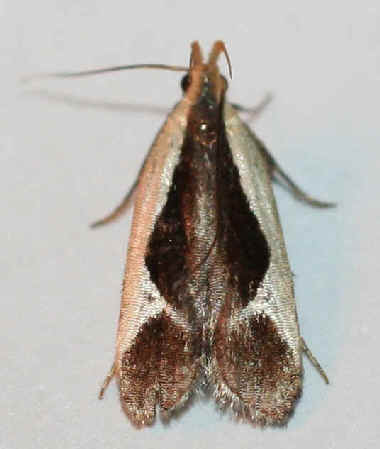
Cream-edged Dichomeris Moth
(photo by Stephen Kloiber)
- Indented Dichomeris Moth
______ M#2297 (PNE:69)
Dichomeris inserrata
- Inversed Dichomeris Moth
______ M#2310.1 NJ
Dichomeris
inversella
- Dichomeris kimballi
______ M#2310.1 NJ
- Two-spotted Dichomeris Moth ______
M#2299 (PNE:69)
Dichomeris leuconotella
- Palmerworm Moth ______ M#2281
NJ (PNE:67)
Dichomeris ligulella
- Juniper Webworm Moth
______ M#2282 (PNE:67)
Dichomeris marginella
- Little Devil
______ M#2307 (PNE:69)
Dichomeris nonstrigella
- Shining Dichomeris Moth
______ M#2289
(PNE:67)
Dichomeris ochripalpella
- Black-edged Dichomeris Moth ______
M#2309 NJ (PNE:69)
Dichomeris picrocarpa
- Spotted Dichomeris Moth ______ M#2283
NJ (PNE:67)
Dichomeris punctidiscella
- Many-spotted Dichomeris Moth ______
M#2288 NJ
Dichomeris punctipennells
- Toothed Dichomeris Moth
______ M#2301 (PNE:69)
Dichomeris serrativittella
- Orange-crescent Moth
______ M#1721 (PNE:61)
Enchrysa dissectella
- Goldenrod Gall Moth
______ M#1986 (PNE:63)
Gnorimoschema gallaesolidaginis
- Fernald's Helcystogramma
______ M#2267 (PNE:67)
Helcystogramma fernaldella
- Lanceolate Moth
______ M#2268 (PNE:67)
Helcystogramma hystricella
- Burdock Seedhead Moth ______ M#1685
PA (PNE:61)
Metzneria lappella
- Crespuscular Rock Rose
Moth ______ M#1881 (PNE:63)
Neotelphusa sequax
- Polyhymno Moth ______
M#2211 NJ
Polyhymno luteostrigella
- Walsingham's Moth
______ M#1864 (PNE:63)
Pseudochelaria walsinghami
- Lesser Bud Moth
______ M#1783 (PNE:61)
Recurvaria nanella
- Red-necked Peanutworm
Moth ______ M#2209 NC
(PNE:65)
Stegasta bosqueella
- White-banded Telphusa
______ M#1857 (PNE:63)
Telphusa latifasciella
- Y-backed Telphusa
______ M#1858 (PNE:63)
Telphusa longifasciella
Family
MOMPHIDAE: Mompha Moths
-
Mompha stellella ______
M#1455 PA
Family BLASTOBASIDAE
- Acorn Moth ______ M#1162
NJ
Blastobasis glandulella
Family GRACILLARIIDAE:
Leaf-blotch Miner Moths
- Alder Leafminer Moth ______
MD
Caloptilia alnivorella
- Azalea Leafminer Moth ______ MD
Caloptilia azaleella
- Dogwood Caloptilia Moth ______
M#0594 (PNE:35)
Caloptilia belragella
- Maple Caloptilia Moth ______ M#0595
MD
(PNE:35)
Caloptilia bimaculatella
- Walnut Caloptilia Moth (ph) ______
M#0596 MD PA (PNE:35)
Caloptilia blandella
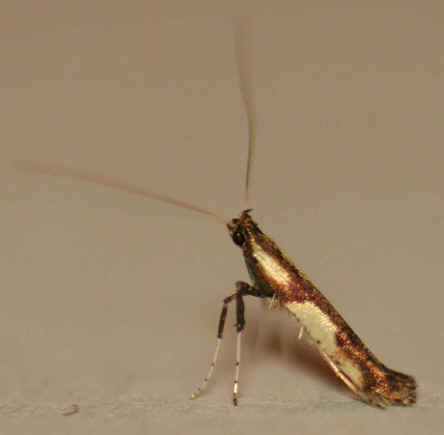
Walnut Caloptilia Moth
(photo by Stephen Kloiber)
- Ash Leaf Cone Roller Moth ______ M#0606
MD
(PNE:35)
Caloptilia fraxinella
- Box-elder Leafroller Moth ______ M#0615
MD
(PNE:37)
Caloptilia negundella
- Caloptilia ostryaeella
______ MD
- Packard's Caloptilia Moth ______
M#0620 MD (PNE:37)
Caloptilia packardella
- Sumac Leafblotch Moth ______ M#0630
MD PA
Caloptilia rhoifoliella
- Sassafras Caloptilia
Moth ______ MD
Caloptilia sassafrasella
- Cherry Leaf Cone Roller
Moth ______ M#0637 MD (PNE:37)
Caloptilia serotinella
- Poplar Caloptilia
Moth ______ M#0639 MD (PNE:37)
Caloptilia stigmatella
- Witch-hazel Caloptilia
Moth ______ M#0641 MD (PNE:37)
Caloptilia superbifrontella
- Tick-trefoil Caloptilia
Moth ______ M#0644 MD (PNE:37)
Caloptilia violacella
- Lilac Leafminer Moth ______ M#0645
(PNE:37)
Caloptilia syringella
- Hornbeam Leafminer Moth ______ M#0832 (PNE:41)
Cameraria ostryarella
- Goldenrod Leafminer Moth ______
M#0723 MD (PNE:39)
Cremastobombycia
solidaginis
- Snakeroot Leafminer Moth ______ M#0698
MD (PNE:39)
Leucospilapteryx
venustella
- Willow Leaf Blotch Miner Moth
______ M#0647 (PNE:37)
Micrurapteryx
salictfoliella
- Finite-channeled Leafminer Moth
______ M#0663 MD (PNE:39)
Neurobathra
strigifinitella
- Locust Digitate Leafminer Moth
______ M#0657 MD (PNE:39)
Parectopa robiniella
- Parornix species
complex ______ (PNE:39)
Parornix spp.
- Phyllonorycter fitchella
______ M#0752
MD NJ
- Lesser Maple Leaf Blotch Miner Moth
______ M#0765 (PNE:39)
Phyllonorycter lucidicostella
- Cherry Blotch Miner Moth ______ M#0784
MD (PNE:39)
Phyllonorycter propinquinella
- Black Locust Leafminer Moth
______ M#0790 (PNE:41)
Phyllonorycter robiniella
Family OECOPHORIDAE: Concealer
Moths
The following species in the genus
Agonopterix are sometimes placed in the family ELACHISTIDAE, or
DEPRESSARIIDAE
Also here:
AUTOSTICHIDAE, XYLORYCTIDAE, including the Scavenger Moths
- Poison Hemlock Moth ______
M#0874.1 PA
(PNE:49)
Agonopterix alstroemeriana
- Brown-collared Agonopterix
______ M#0864 (PNE:47)
Agonopterix atrodorsella
- Canadian Agonopterix
______ M#0878 (PNE:49)
Agonopterix canadensis
- Clemens' Agonopterix
______ M#0862 (PNE:47)
Agonopterix clemensella
- Curve-lined Agonopterix
______ M#0859 (PNE:47)
Agonopterix curvilineella
- Red Agonopterix
______ M#0857 (PNE:47)
Agonopterix lythrella
- Featherduster Agonopterix
______ M#0867 (PNE:49)
Agonopterix pulvipennella
- Four-dotted Agonopterix ______ M#0882 (PNE:49)
Agonopterix robiniella
- Thelma's Agonopterix Moth ______
M#0884 PA
Agonopterix thelmae
- Pale-gray Bird-dropping Moth
______ M#1014 NJ
Antaeotricha leucillana
- Schlaeger's Fruitworm Moth ______
M#1011 NJ PA
(PNE:53)
Antaeotricha schlaegeri
- Bog Bibarrambla ______
M#0911 (PNE:49)
Bibarrambla alenella
- Linden Bark-borer Moth ______
M#1463 (PNE:53)
Chrysoclista linneella
- Reticulated Decantha ______ M#1042 (PNE;53)
Decantha boreaxella
- Beautiful Dafa ______ M#1048 (PNE:53)
Dafa formsella
- Yarrow Webworm Moth ______ M#0926 (PNE:51)
Depressaria alienella
- Parsnip Webworm Moth ______ M#0922 (PNE:51)
Depressaria pastinacella
- Eido trimaculella
______ M#1068
NJ
- Orange-headed Epicallima Moth
______ M#1046 NJ
PA (PNE:53)
Epicallima
argenticinctella
- Viper's Bugloss Moth ______
M#0986 (PNE:51)
Ethmia bipunctella
- Streaked Ethmia ______ M#0999
(PNE:51)
Ethmia longimaculella
- Zeller's Ethmia ______ M#0992 (PNE:51)
Ethmia zelleriella
- Gerdana Moth ______ M#1144
NJ
Gerdana caritella
- Chalky Inga Moth ______ M#1035
NC
Inga cretacea
- Black-marked Inga ______ M#1034
NC NJ
Inga sparsiciliella
- Gold-striped Leaftier Moth ______
M#0951 PA (PNE:51)
Machimia tentoriferella
- Newman's Mathidana Moth ______ M#1059
NC In NC: Piedmont
Mathidana newmanella
- Four-spotted Yellowneck ______ M#1134
NJ
Oegoconia quadripuncta
- The Skunk ______ M#1058
(PNE:53)
Polix coloradella
- Suzuki's Promolactis Moth ______ M#1047.1
NC NJ PA In NC: Piedmont
Promalactis suzukiella
Promalactis suzukiella is
a recent introduction in North America of an Asian species.
- Black-fringed Psilocorsis Moth
______ M#0956
PA
Psilocorsis
cryptolechiella
- Oak Leaf-tying Psilocorsis Moth
______ M#0955
PA
Psilocorsis quercicella
- Dotted Leaftier Moth
______ M#0957 (PNE:51)
Psilocorsis reflexella
- Yellow-vested Moth ______ M#1026
NC
Rectiostoma xanthobasis
- Aurora Semioscopus
______ M#0916 (PNE:51)
Aemioscopus aurorella
- Plain Semioscopus
______ M#0914 (PNE:49)
Semioscopus inornata
- Packard's Semioscopus
______ M#0912 (PNE:49)
Semioscopus packardella
Family ADELIDAE: Fairy
Moths
- Southern Longhorn Moth ______ M#0227
NC In NC: low mountains
Adela caeruleella
- Purple Fairy Moth ______
M#0229 (PNE:31)
Adela purpurea
- Riding's Fairy Moth ______
M#0228 (PNE:31)
Adela ridingsella
Family
TINEIDAE: Tineid, or Fungus Moths
- Eastern Grass Tubeworm Moth
______ M#0372 NJ
Acrolophus plumifrontella
- Clemen's Grass Tubeworm Moth
______ M#0373 NJ
PA
Acrolophus popeanella
- Burrowing Webworm Moth ______ M#0334
NJ
Amydria effrentella
- Old Gold Isocorypha Moth (ph) ______
M#0299 PA
Isocorypha mediostriatella
Another name for Isocorypha
mediostriatella is the White-shawled Isocorypha Moth.
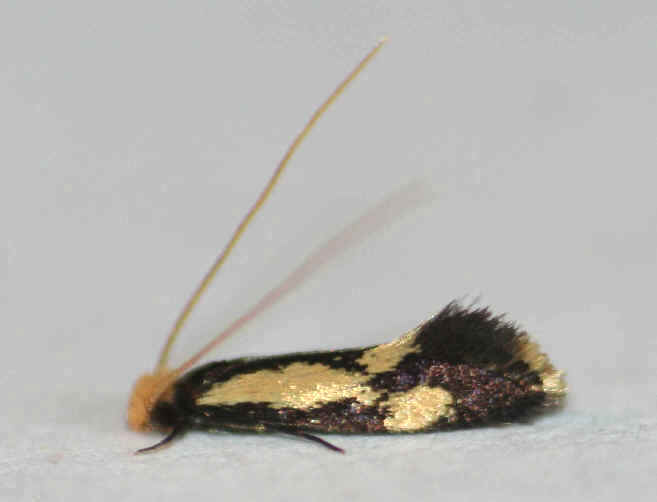
Old Gold Isocorypha Moth
(photo by Stephen Kloiber)
- Bird Nest Moth ______ M#0415
NJ
Monopis crocicapitella
- Yellow-headed Monopis Moth ______
M#0418.1 NJ PA
Monopis pavlovskii
- Speckled Xylesthia Moth ______
M#0317 NJ PA
Xylesthia pruniramiella
Family GALACTICIDAE
A recently-described
family of moths previously assigned to other families
- Mimosa Webworm Moth ______ M#2353
PA
Homadaula anisocentra
To Top of Page


 A List
A List ![]()
![]()
![]()




















































































































